| | |
- "We must keep our faith in the Republic. The day we stop believing democracy can work is the day we lose it."
"Let's pray that day never comes." - ―Queen Jamillia and Padmé Amidala, discussing the Separatist Crisis

Senators demanded Chancellor Palpatine to return to democratic principles in the last days of the Republic.
Democracy was a form of social organization that involved free political participation in a state's decision-making processes. The Galactic Republic maintained a thousand years of democracy across sovereign star systems through the Galactic Senate, but its democratic processes were eroded by personal and corporate interests that placed greed above common interests throughout the galaxy. Such corruption was exploited by the Sith Lord Darth Sidious, who undermined the Senate by engineering the Naboo Crisis and was secretly Sheev Palpatine, who was elected the Supreme Chancellor. Despite the democratic principles of senators such as Padmé Amidala, Palpatine gained increasing power over the Senate during the Separatist Crisis, which spiraled into the Clone Wars against the Separatists. At the end of the war, he ordered the destruction of the Jedi Order, paving way for the Republic's full transition into the fascist dictatorship of the Galactic Empire.
Emperor Palpatine's loyal bureaucrats and the Imperial war machine suppressed the people of the galaxy as the Senate became decreasingly relevant to governmental affairs, and the Empire was eventually overthrown by the Rebellion, giving way to the New Republic. However, its system of representative democracy was weakened by growing divides in the aftermath of the Galactic Civil War. Due to its complacency and the machinations of Darth Sidious and his Sith cult, the New Republic collapsed as the neo-Imperial First Order conquered the galaxy. However, Leia Organa's Resistance movement mobilized hopes for freedom. Among them was a new generation of rebels led by Rey Skywalker, Finn, and Poe Dameron, and they eventually rallied a fleet of galactic citizens to defeat Sidious' plans for a new Sith Empire, liberating the galaxy.
Description[]
Peace and prosperity[]
- "I don't think the system works."
"How would you have it work?"
"We need a system where the politicians sit down and discuss the problem, agree what's in the interest of all the people, and then do it."
"That's exactly what we do. The… the trouble is that people don't always agree."
"Well, then they should be made to." - ―Anakin Skywalker and Padmé Amidala exchange political views while on vacation
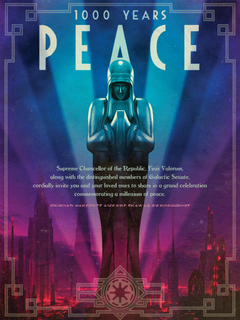
The Republic supported peace and democracy for a thousand years.
Democracy was a form of social organization that involved free political participation in a state's decision-making processes. Galactic history alternated between a mixture of democracies and dictatorships, and the Galactic Republic was founded after the fall of the Sith Empire around 1032 BBY. The Republic was a democratic union of thousands of worlds in much of the galaxy[2] that maintained a thousand years of democracy, symbolized and upheld by the Galactic Senate.[3] The Senate was a representative democracy[4] comprised of senators and representatives[1] of their respective homeworlds[5] and sectors[6] who were elected to cooperate extensively through discussion and debate in the best interest of all the[1] trillions of beings in the Republic,[2] passing legislation to solve the Republic's issues.[1] Each senator was responsible for representing both their constituents and the government as a whole, with politicians needing to reconcile frequently conflicting responsibilities especially during wartime.[7]
Convening in the Federal District's Senate Rotunda of the Republic capital planet Coruscant,[2] the Senate could make law, establish commissions of inquiry, sit in committees, and elect the Republic Supreme Chancellor to lead the Republic government.[3] The Office of the Chancellor had limited unilateral executive powers over the Senate,[1] though the system was subject to bureaucratic procedures[3] that could be influenced by special-interest lobbies.[8] Also within the Federal District sat the Galactic Courts of Justice, the Senate Office Building, and the Jedi Temple[9]—the Republic's one thousand years of democracy coexisted with one thousand years of peace[1] due to political stability and the effectiveness of the Jedi Order.[2]
Monopoly of violence[]
- "If you offer the Separatists violence, they can only show us violence in return! Many will lose their lives. All will lose their freedom."
- ―Padmé Amidala
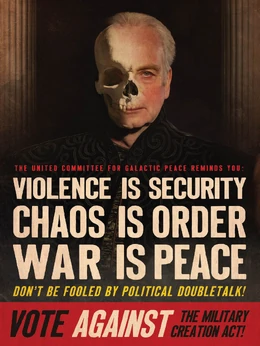
Political Doubletalk poster campaigning against Republic militarization
The Republic was supported by the Jedi as they had strong connections with the Force and were committed to light and life, safeguarding peace and justice throughout the galaxy and sometimes being tasked by the Senate to act on its behalf as negotiators.[10] Jedi had a responsibility to uphold the Jedi Code and protect all people of the galaxy,[7] and the Republic did not maintain a standing military until its final years, though treaties allowed some member worlds to contribute their local military assets to an overarching Republic Defense Coalition for the duration of specific emergencies, such as the Nihil conflict.[2] The Jedi High Council made key decisions for members of the Jedi Order to follow and operated based on consensus among its twelve members. The council included respected Grand Masters, with one, Ry Ki-Sakka, believing that after a member died and passed into the Force, the council did not replace their seat but instead expanded by inviting new Jedi.[11]
In the years leading up to the Separatist Crisis, the Senate's Core Faction advocated for increasing the centralization of power, including funding expansion programs to outlying star systems and organizing them in the model of the Core Worlds. They were opposed by the Rim Faction, which favored greater rights for individual star systems in the Outer Rim, such as Ryloth. The Core Faction was often supported by the Militarists, who wanted a centralized Republic military to counter criminal gangs instead of relying on a patchwork of planetary defense forces and the Judicial Department, which included the Sector Rangers who were supported by Jedi.[12]
The Republic's increasing investment in warfare and executive powers of the Supreme Chancellor were exploited by Sheev Palpatine to create a Grand Army of the Republic during the Clone Wars and become Galactic Emperor.[2] The Chancellor of the New Republic was therefore established as a position with limited authority by Mon Mothma, who refused to let the office maintain the emergency powers granted in the old charter of Chancellor.[13] The new democratic state therefore lacking an executive despite an attempt by Centrist faction senators to create a new position named First Senator that would have executive power over economic and military affairs. They were opposed by the Populists, who favored the sovereignty of individual member states and were led by Leia Organa. Organa believed that the fledgling democracy was left vulnerable to various remnants of the Galactic Empire due to its own demilitarization, and she left the New Republic Senate to form the Resistance, an armed movement that vowed to protect the freedom of people throghout the galaxy.[14]
Economy[]
- "It is my experience that senators focus only on pleasing those who fund their campaigns…and they are by no means scared of forgetting the niceties of democracies in order to get those funds."
- ―Obi-Wan Kenobi
The Republic's democracy moderated the galactic economy through a mixture of trade taxation and private corporations.[3] While the Republic Treasury was responsible for printing Republic credits, the Senate's Finance Committee oversaw annual budgets, revenue generation, government grants, and emergency relief fund appropriations.[12] While interplanetary cooperation and trade created the prosperity of the High Republic Era, the age of prosperity and hope was disrupted by the Nihil conflict.[2]
Economics was the study of resource allocation, people, and their choices. While some economic policies promoted rapid, short-term growth at the expense of beings, other policies allowed for incremental and constructive long-term economic growth. Although some people believed that economics had no morality and that free markets would correct themselves, some economists resolved moral dilemmas through the guidance of the Force. Listening to the Force could uncover deeper truths even when economics was popularly seen as patterns of doom and gloom; supply and demand. Some Jedi adopted monastic lives of austerity,[15] and the only personal possession allowed within the Jedi Order's membership was the lightsaber.[2]
Having long abandoned the aurodium standard, the Republic partnered with the InterGalactic Banking Clan (IGBC) and Bank of the Core to maintain its credit reserves and ensure the stability of the Republic's currency. The Republic also had a tax collection agency,[12] cut other areas of public spending,[16] and issued war bonds to fund militarization during the Clone Wars.[17] As one of the most powerful corporations in the Outer Rim,[18] the IGBC issued loans to the Republic at interest rates of their own discretion.[19]
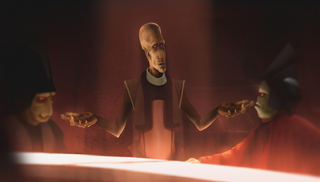
Corporate interests corrupted the Republic's democracy and profited from war.
In the latter years of the Republic, peace fostered comfort and comfort in turn begot complacency, encouraging corruption. Several commercial corporation giants—such as the IGBC, the Trade Federation, the Commerce Guild, the Corporate Alliance,[2] and the Techno Union,[12] all of which stood as examples of unbridled capitalism[20]—gained their own seats in the Senate. They exploited disagreements among politicians to stall solutions and loopholes in the bureaucracy in pursuit of profit at the expense of representative democracy, corrupting more senators on their payroll.[2]
Although the corporations were in turn restricted by the levying of taxes, they decided to lead the Confederacy of Independent Systems, a secessionist faction motivated by the frustration of many senators of Outer Rim star systems with what they perceived as an ineffectual Republic that favored the Core Worlds elite while being burdened with heavy taxation. The former Jedi Master Count Dooku of Serenno had a reputation of being a political idealist frustrated with the Republic's inefficiency, and he promised freedom and prosperity as the leader of the Separatist Alliance. While the Separatist Parliament was a representative democratic legislature akin to the Galactic Senate, it did not have the Republic's layers of bureaucracy, existing treaties, and interference from corporations.[2]
However, the Confederacy was a democracy only in name.[21] The Parliament was largely sidelined by Dooku's secret Executive Separatist Council, which consisted mainly of corporations such as the Trade Federation, Commerce Guild, Corporate Alliance, InterGalactic Banking Clan, Techno Union, and the Retail Caucus that funded the war against the Republic.[2] When the Confederacy was defeated, the trade corporations were absorbed by the Galactic Empire dictatorship[22] or simply pledged themselves to the new government.[23]
Justice, rights, and the rule of law[]
- "It's every citizen's duty to challenge their leaders, to keep them honest, and hold them accountable if they're not."
- ―Ahsoka Tano
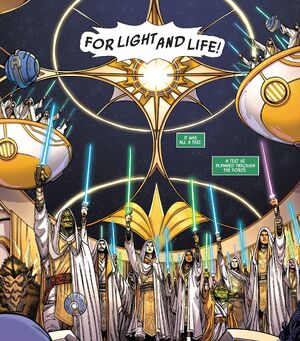
The Jedi safeguarded the Republic's democracy as guardians of peace and justice.
The Galactic Republic valued the rule of law,[25] as did planetary representative democracies such as Devaron.[26] The Alliance to Restore the Republic likewise emphasized its belief that galactic governance required just laws that were fairly implemented by the "consent of the governed."[17] The Rebellion[27] and the New Republic[28] were sometimes denounced as forces of "anarchy," and the First Order purported to reclaim "stability" and "progress" that were granted by Imperial "civilization" and "rule of law,"[27] yet without democracy, the Imperial and First Order regimes ruled by decree. They arbitrarily made oppressive laws and committed acts of terror that could not be challenged in peace,[2] militarily quashing disagreement rather than protecting their citizens.[29] Soldiers' obedience to superior orders ensured the birth of the Empire from a corrupted Republic; whereas the plague of corruption and ineffectual governance undermined the state's legal systems, the subsequent dictatorships were ultimately toppled by popular defiance.[2]
Republic laws were enforced by various courts and agencies of the Judicial Department,[12] with the Old Republic Judicial Forces having worked alongside Jedi to dismantle the Zygerrian slave trade[30] as slavery was outlawed in the Republic. However, many outlying star systems that were not part of the Republic continued to experience slavery, including the planet Tatooine in Hutt Space.[3]
In the Republic's twilight years, its courts were overwhelmed[2] and the Jedi's ability to predict the future diminished, encapsulated by their involvement as military leaders rather than their traditional role as peacekeepers in the Clone Wars.[1] The slave trade on Zygerria revived under Separatist influence during the war.[31] The Republic Senate's Ethics Committee had the power to investigate senators and government officials, including to order witnesses for court hearings, and the Judiciary Committee's Internal Activities Committee could recommend criminal charges on relevant individuals.[12]
History[]
Knights of the Old Republic[]
- "The Republic victory was so definitive that it reinvented itself, resettling its capital on Coruscant after a devastating ouster. History reset its chrono on this date, and from that moment, the modern Galactic Republic was born."
- ―The artist Janyor of Bith

The Republic was a democratic union of worlds throughout the galaxy.
The "Old Republic" was initially founded by twenty-two Core Worlds[32] around 25,000 BBY.[33] As time progressed, members of the Republic included a growing quantity of sovereign signatories of star systems and worlds that sent their representatives to the Galactic Senate,[2] which met in the Senate Building in the Federal District of Coruscant, the Core World ecumenopolis that Serving as the political capital of the Republic. The congress of the Republic elected Chancellors who led the Republic government and also chaired Senate meetings.[9] Given differences in orbital cycles and species lifespans, members of the Republic defined their own electoral procedures and term limits for their own senators.[4]
Coruscant attracted migrants from thousands of other worlds, including from both Republic member worlds and foreign allies. Although Troithe in the Deep Core rivalled Coruscant as the cosmopolitan jewel of the Republic with its aristo-mercantile families, Coruscant's growing workforce bolstered its industrial capacity and outpaced production on Troithe.[34] The Works of Coruscant thrived and were later vacated as the costs of manufacturing in the ecumenopolis rose, though its population remained in the trillions.[9] The Expansion Region's Thisspias had a constitutional monarchy that was culturally led by the hereditary Blood Monarchy but otherwise governed by a parliament. The Blood Monarch had successfully convinced the world's fighters to serve in the military of the Republic during its initial establishment, securing her reign and expanding Thisspias' economy while her people defended galactic democracy despite their generally conservative and pro-independence stance. Thisspias was involved in many Republic conflicts during the Great Manifest Period and had great influence in the Galactic Senate, connecting the Core Worlds and the Outer Rim.[15]
The Jedi Order emerged as the Republic's protectors, but the Force users suffered a schism[35] during the Hundred-Year Darkness[36] around 5000 BBY.[25] The fallen Jedi turned against their compatriots and became tyrants known as Dark Lords of the Sith, having been corrupted by the dark side of the Force,[2] which fueled desires to control others through the manipulation of fears and restrictive laws of punishment rather than the Jedi way of serving political communities with compassion.[15] The Sith Wars plagued the Old Republic.[2] According to the Qel-Droma Epics, the Dark Lord Naga Sadow's Great Hyperspace War was foiled by Empress Teta working together with the Jedi, but later the Krath took control of the Empress Teta system in the Deep Core and were led by fallen Jedi who commanded Mandalorian crusaders.[26] The Sith were also led by a Sith Emperor[37] and devastated entire worlds, including Coruscant. The Sith Order was ostensibly eliminated by Jedi Knights at the end of the Jedi-Sith War[17] on Ruusan,[38] and the Galactic Republic was democratically founded around 1032 BBY following the Sith Empire's collapse.[2] However, the sole Sith survivor, Darth Bane, conjured a Grand Plan whereby the Sith would corrupt the Republic from within and take revenge against the Jedi.[39]
Tarsus Valorum served as the first Supreme Chancellor of the modern Republic state, which disbanded its military[8] in favor of the Jedi Knights, who were no longer burdened by an existential threat such as the Sith.[2] The Republic tried to suppress the history of the Sith's oppression and their obsession with genetic sciences and immortality.[40] The Galactic Constitution[17] was influenced by the quartet of controversial philosophers known as the Four Sages of Dwartii.[9] While the constitution included a declaration that all sentient beings were equal and outlawed slavery, droid rights remained a contentious topic.[41]
Expansion of the High Republic[]
- "Perhaps it's just the cost of peace. That it's hard won. That it hurts because it's worthwhile. Worth fighting for. Precious."
"We need to be better, Aida. All of us. We need to recognize what we have and help the galaxy cling on to it."
"We will. The Jedi Order, the Republic—we'll find a way. One day, we'll be the beacon of peace that the galaxy needs. But we're not there yet. In the meantime, we have to do all we can and hope it's enough." - ―Jedi Aida Forte and Creighton Sun
The Republic was the dominant galactic-scale state that included sovereign signatories of star systems across the Core Worlds, Colonies, Inner Rim Territories, Expansion Region, and Mid Rim Territories. Republic explorers extended hyperspace routes across the Outer Rim Territories, leaving the largely uncharted Unknown Regions and the unpredictable Wild Space out of the authorities' reach. Cooperation between much of the galaxy's star systems ensured that the Republic prospered in the golden age of the High Republic[2] between around 500 BBY and 100 BBY.[25]

The Republic executive's powers were limited and depended on collaboration.
In 382 BBY,[10] the Republic was led by the Co-Chancellors Kyong Greylark and Orlen Mollo, who sought to develop a more equitable and connected union[43] during the Great Hyperspace Rush. Republic Pathfinders and Jedi led expeditions further into the Outer Rim. Mollo was a Quarren who had experience of conflict on Mon Cala, the shared homeworld of the Quarren and Mon Calamari peoples, and effectively worked with Greylark until the latter's resignation following her son's arrest.[44] While Co-Chancellor Greylark specialized in the Senate on Coruscant, Co-Chancellor Mollo traveled extensively and, while he believed the Republic should not exert undue influence on non-member worlds, he and Jedi negotiators pleaded for a ceasefire to the Eiram and E'ronoh War.[10] Around that time, the Republic clashed with the sovereign and independent Togruta people of[32] the Expansion Region planet Shili.[45]
Jedi Masters and found-siblings Porter Engle and Barash Silvain meanwhile negotiated between the Bethune army and the besieged Firevale on Gansevor, allowing humanitarian supplies to enter Firevale and establishing a ceasefire.[46] Silvain was quick to believe the Princess Sicatra of Bethune that the Bethunians wanted to kill her due to her pregnancy with Prince Colden of Firevale, given that Silvain herself had strong childhood longings for being part of a family, and entrusted Engle with demanding the army's departure. However, the army had allied with General Abediah Viess' mercenary army that insisted on targeting Firevale's city center, forcing Engle to battle Viess.[47] Princess Sicatra then revealed that the siege had been a ruse intended to usurp the Firevale throne and ordered the Bethunians to turn against Viess' army. Although the mercenaries retreated, Silvain felt responsible for her misjudgement and the resulting bloodshed, vowing to exile herself to reconnect with the Force.[48]
The Nihil crisis[]
"We are all the Republic"[]
- "Some have traveled far, some are close to home. But we all are one. We are all the Republic, and this fair is for all of us. This day is for all of us. Together we will experience new things. Together we will witness marvels from across the sectors. Art. Music. Drama. Innovation. They belong to us and they bring us together. This is a chance to understand one another; to realize once again what we all bring to the Republic, each and every one. This is our time. And it is only the beginning."
- ―Chancellor Lina Soh
At some point on the Outer Rim planet Ryloth, the Clan Assembly signed the articles of membership for the Twi'lek homeworld and their colony worlds to join the Republic. However, one of the colonies, Aaloth, was struck by famines that spurred a coup d'état—organized by the Zygerrian Alliance, it executed members of Aaloth's ruling family and forced its sole survivor, Lourna Dee, into an enslavement camp on Zygerria until it was liberated by the Jedi[49] around 255 BBY.[25]
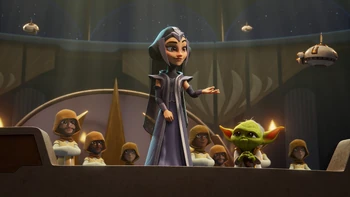
Chancellor Lina Soh was committed to the Republic's ideals of unity and compassion.
Following her election as Chancellor around 234 BBY,[25] Lina Soh launched the Great Works projects to strengthen the Republic's outreach programs and expand the democratic union's influence in the Outer Rim. Among the projects were the negotiation of a treaty between the Quarren and Mon Calamari,[50] the renewal of Kwenn's Gem Cities,[51] and technological innovations such as developing bacta cultivation, enhancing a network of communications relays, and building Starlight Beacon as both a symbol of the Republic and an effort to boost interconnectivity in the Galactic Frontier. Chancellor Soh used the phrase "we are all the Republic" to emphasise the value of its democracy,[50] and Jedi such as Avar Kriss used the phrase "for light and life" to highlight the Jedi's commitment to all beings in the galaxy.[52]
When the anarchistic Nihil marauders instigated the Great Hyperspace Disaster and subsequent Emergences in 232 BBY,[25] the Chancellor halted hyperspace travel in the Outer Rim via the Republic Transport Bureau under Secretary of Transportation Jeffo Lorillia to ensure spacefarers' safety. Senator Izzet Noor of Serenno spoke in protest of the order on behalf of the majority of the Outer Rim, though Noor's aide was a covert Nihil agent.[10] Chancellor Soh also asked the Jedi Order to work with the Republic Defense Coalition against the Nihil. The Jedi High Council debated and voted on the issue, with six members in support and five opposing; Ephru Shinn argued against Jedi military involvement on the principle of peace while Yarael Poof countered that Jedi must also intervene to maintain justice.[50]
Senator Tia Toon of the Sullust system was not satisfied with the Republic's reliance on the Jedi and was concerned about the Republic Defense Coalition's limitations, and he had been proposing a Defense Force Program that would boost the Republic's military capabilities. While Toon did not consider the economic dominance of the SoroSuub Corporation in his star system to be a conflict of interest, his costly proposals had failed multiple rounds of voting in the Senate and were not welcomed by Chancellor Soh's pacifist ideals.[32] Around the same time, Republic authorities dissolved the Byne Guild[25] after learning about the shipping company's abuse of employees working in indentured servitude, a legal practice upon which the Hutt Clan capitalized to build industries.[53]
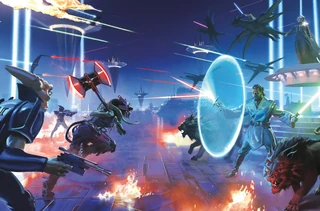
The Republic Fair on Valo was intended to be a demonstration of democracy and unity but was hijacked by the Nihil.
In 231 BBY,[25] the Chancellor hosted the Valo Republic Fair to celebrate the spirit of democracy, progress, and unity. The journalist Rhil Dairo was granted broad clearance to much of the Chancellor's work coordinating the event, as Lina Soh believed in the importance of free and transparent press coverage. The Republic Fair itself was hijacked by a vicious Nihil attack, but the Jedi and Republic forces protected many of the dignitaries and citizens of Valo, including the Chancellor herself. As Soh recovered from her injuries, Vice Chancellor Larep Reza served as acting chancellor. The Jedi's bravery convinced the fair's guest of honor, Regasa Elarec Yovet of the Togruta people, whose government had misgivings about the Republic, to argue for an alliance between the two states.[32]
Against surging storms[]
- "We are all the Republic. What does that really mean? Are they just words? Is it merely a thoughtless motto we all toss around without considering its true intent? Perhaps to some, that's all the words have ever meant. To our enemies, certainly, they are a point of ridicule. But this is because they do not understand the strength that might be found in unity. While we of the Republic share a common purpose, we share, too, common values. Compassion for our fellow beings. A desire to raise one another up, to help where help is needed, to grow. And to do it together."
- ―Chancellor Lina Soh, addressing the Senate
In 230 BBY, the Nihil infiltrated the government of Corellia, a Core World with significant isolationist sentiments along the taglines of "Corellia for Corellians." With help from the Jedi, Alys Ongwa and her diplomat security crew rallied fellow Corellians against the brutality of the Nihil regime. Despite failing to secure additional starships from the Corellian shipyards,[55] Nihil militants destroyed Starlight Beacon with the help of their "Nameless" who which preyed on the Jedi's connection to the Force.[10]
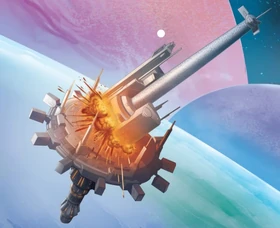
The fall of the Starlight Beacon
The Nihil also forcibly claimed an area of the frontier as their own Occlusion Zone, and the Jedi High Council informed the Senate that they were implementing the Guardian Protocols, a series of policies limiting the Jedi Order's activities alongside the council's order for all Jedi to re-gather on Coruscant to evaluate the Nihil threat. The Chancellor vowed not to abandon the trapped worlds, and some Jedi were sent along with Republic forces to patrol the Occlusion Zone's seemingly impenetrable Stormwall border and attempt to break through it.[10] In the following year, Lina Soh faced an increasing number of senators who began to push for an accord with the Nihil to recognize their legitimacy and reopen trade routes. She nevertheless commanded the Senate's approval, emphasizing compassion and collaboration as core values of their democracy, including those beyond the state's borders who carried the Republic "in their hearts."[54]
After the anniversary of the fall of Starlight, in lieu of a way to enter the Occlusion Zone, Jedi Master Elzar Mann petitioned Grand Master Ry Ki-Sakka about mounting an assault on the Stormwall. However, the Grand Master was concerned about prioritizing the Nihil conflict over the rest of the galaxy; most citizens' lives continued as normal and required governance and guardianship with everyday issues such as disputes, trade negotiations, and migrations. The Nihil Minister of Information and former Republic senator Ghirra Starros sought to establish diplomatic relations with the Republic, and she was received as a guest by Chancellor Soh and Master Elzar Mann, but they agreed that the Senate and the Jedi would be divided on the issue of recognizing the Nihil as legitimate and refused to show that the Republic would capitulate to the Nihil.[54]
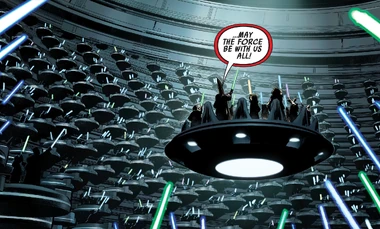
The Jedi Order worked closely with the Senate of the Republic in response to crises such as the Nihil conflict.
The Jedi Council initially refused to work with Republic forces to attempt breaching the Stormwall. When Master Mann relayed a Republic report believing that a breach had been identified, the council agreed to help Republic forces in their assault. When it failed, the Nihil expanded the reach of the Stormwall, claiming more sectors of Republic Outer Rim space, up to the Seswenna sector.[54] Although many citizens of Coruscant conducted their businesses as usual and were ignorant of the crisis in the frontier, including the consequent influx of refugees, the Chancellor and the Jedi High Council refused to abandon the outlying systems and instead worked together closer than ever, with Master Mann serving as liaison, representing the Jedi Council.[11]
Choosing and living[]
- "I bring a message of hope, though it is difficult to hear. But listen, please. Even I am familiar with despair. I know it. That feeling when everything is too much, when the pressure of looking for anything inside of tomorrow is overwhelming. It hurts. I know it, too. In times like that just remember who you are—who you want to be. Who you can be. Focus on that. Fight with me, if that is who you can be. But if you cannot, you do not have to fight. I won't ask that of you. There are people already fighting for you. For all of us. All I am asking of you today is that you live. Live today, and try to find hope tomorrow. Help is coming."
- ―Avar Kriss' promise to people trapped in Nihil space
Given the crisis, Chancellor Soh continued to have the confidence of senior senators from a rainbow of worlds, including Senator Toon.[11] Grand Master Yoda suggested that the Nihil had overreached and would face uprisings from the billions of additional people trapped within their territory, assuring the Chancellor that the council fully committed to helping the Republic Defense Coalition breach the Stormwall and learn more about the dreadful Nameless horde. Indeed, Jedi Masters Avar Kriss and Porter Engle devised a way to exit and enter the Occlusion Zone,[54] with Kriss recording a message of hope broadcasted by resistance organizers in Nihil space.[11]
Ghirra Starros reached out to the Chancellor again. While Soh was open to the idea of the Republic coexisting with another nation, she believed the Nihil had proven to be incapable of doing so and refused to recognize the Nihil's sovereignty; the Chancellor cited the "Eye of the Nihil," Marchion Ro's record of violent atrocities and hostile, expansionist agenda that trapped people within the Stormwall's borders against their will. When the Jedi Council invited Elzar Mann to join its ranks, Master Kriss, his lover, encouraged him in the belief that his strong voice would keep the council from stagnating.[11]
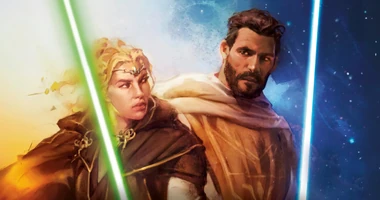
Avar Kriss and Elzar Mann played their parts in upholding the Republic and the Jedi's promise to serve the citizens of the galaxy.
Master Kriss believed that love was limitless, as opposed to attachment and possessiveness[11]—which had long been forbidden within the Jedi Order[10] as they dangerously led to the dark side—and that the Jedi's love for people inspired them to find hope and fight for freedom, even beyond the Republic and at times of despair. Master Mann later discussed love with Grand Master Yoda, asking him if it was possible to be free of attachment while loving another individual, a place, or even the entire Republic. Mann realized that his parents must have let him go to be trained as a Jedi through their love; that despite Chancellor Soh's desperate desire for her son to safely return from Nihil space, she was unwilling to compromise the billions of lives for which she was responsible to make her demand; the importance of choosing how to live and serve in every moment.[11]
For light and life[]
- "There will be times when it seems the fate of the galaxy hinges on the tiniest decision you make. Great and terrible times, indeed. In these moments, you will have to choose: will you dance with the flow of the Force, or will you become a boulder against the tide of history? You must dance, even in the storm. To do this, you must hold within your body the memory of having danced in the calm. Only then, can you truly know how to let go, and rise."
- ―Master Obratuk Glii, teaching Farzala Tarabal
Within the Occlusion Zone, the Nihil invaded the planet Eriadu and lay siege on Bri-Phrang City, where Jedi and the Republic Defense Coalition remained. The Nihil wanted to secure the support of Eriadu's Tarkin family and combine their forces to defeat the Jedi. While the Eriadu High Council debated ahead of their vote on whether or not to support the Nihil, Lula Talisola and Zeen Mrala's ally Sevran Tarkin exposed her uncle, who was inclined to welcome the Nihil, of dishonoring their family in the past.[57] As the family continued deliberating among themselves, the Nihil traveled to recruit more fighters from Valo, which they had previously occupied. The visiting Nihil were not aware that the Jedi had already freed the world, which remained in the Occlusion Zone but was the secret source of a pro-freedom and pro-Republic broadcast by the Jedi Initiate Gavi Takitaken.[58]

The urban warmth of Eriadu was set upon by the Nihil, but the banding together of not only Jedi but ordinary people ultimately proved the Nihil's downfall.
The Nihil attempted to re-conquer Lonisa City with lethal force, with some residents fighting back and others, wary of another war, were either subdued or tried fleeing from the violence. The Jedi Padawan Ram Jomaram, having initially set up Valo's broadcast studio to spread hope and remind himself of freedom in the smallest moments, returned to his home city as Gavi Takitaken was forced to broadcast a plea to surrender. Each member of Jomaram's crew played their part as the Jedi used the broadcast to call on each person to "never shut up" and be a "light in the dark," banding together to transform from "a scattered constellation" to "the dawn," fighting against the occupation until every person, every world, and the entire galaxy was free.[59] The people of Lonisa City indeed rose up and deposed the Nihil, who regathered on Eriadu to stomp out the resistance there. While the Nihil ignored their remaining Eriaduan collaborators' refusal to bombard Bri-Phrang City, a sweeping coalition of Jedi, pirates, and Eriaduans crossed the bay to Eriadu City under the leadership of Farzala Tarabal. Despite haunting visions of destruction throughout the war, Tarabal recalled his Jedi Master's teachings to rise up together with the tide of history, fighting for the freedom of Eriaduans as the Battle of Eriadu began.[56]
While Marchion Ro kept nearly 10% of the Republic's members isolated behind his Stormwall and Nihil spies infiltrated the Republic, Ro could not be satisfied with his quest to have the power to choose for everyone else, and he therefore unleashed the all-consuming Blight, threatening to destroy all life in the galaxy and thus, potentially, kill the Force itself. When he offered to remove the Blight from afflicted Republic worlds in return for public acknowledgement of his help, the Senate signaled that it would support the Supreme Chancellor whether she chose to accept or reject Ro's offer. With the decision left to Lina Soh herself, she asked her ministers to brief her on the state of the crisis and thought that even though she had been elected to the position and she tried to represent all the Republic, even the greatest elected leaders could ultimately only be themselves. When the Jedi discovered the Blight in the depths of their temple, they chose not to immediately alert the Chancellor—her Jedi liaison, Elzar Mann, reminded her that the Jedi Order was unelected and did not serve the Republic per se but rather helped the Republic, and they would not have helped if the government ordered over a trillion of Coruscant's residents to evacuate their world since doing so would lead to disastrous stampedes. Despite her initial anger at Mann's revelation, Lina Soh considered her desire for strengthening the Republic's unity and, trusting that the Jedi would do their best to stop the Blight, rejected Ro's offer.[60]
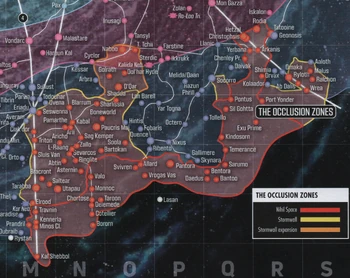
The Republic depended in large part upon the Jedi to dismantle the annexed "Occlusion Zone" (map pictured) and hold back the Blight.
With the war focusing on Eriadu while his Nihil were denied legitimacy as a separate state, Ro accelerated the spread of the Blight by killing more of the so-called Nameless on their homeworld, in doing so abandoning the Nihil and collapsing the Stormwall. He was ultimately foiled by the team of the Luminous Nine, sent by the Jedi Council, who discovered but promised to keep secret the truth of the "Nameless" people—the Shrikarai—with Avar Kriss and Elzar Mann remaining on the world to restore balance on their world, each loving but not needing the other, both dedicated to defending light and life. In the war crime trials to follow, the Republic afforded the Nihil suspects due process to show the Republic's regard for the rule of law, and Marchion Ro's trial was held in the Senate Chamber and presided by a magistrate. Chancellor Soh resolved to rebuild faith in the story of the Galactic Republic, telling citizens that their republic was built on shared beliefs and that people had more in common despite disagreements on the details. However, given how close the galaxy had come to its doom, she also realized that the Republic faced a new reality in which it would be irresponsible to depend on having faith in the goodwill and effectiveness of the Jedi.[60]
Fading of the golden age[]
Corporate stranglehold[]
The Republic Ministry of Economic Development and the Homestead Act incentivized migration from the Core Worlds into the galactic frontier and the Outer Rim, aiming to encourage such worlds to join the Republic at various times in its history.[4] Economic development in outlying systems was encouraged by the Republic's Free Trade Zones. Companies that faced threats to shipping and commerce in those peripheral regions founded the Trade Federation[61] in the wake of the Great Hyperspace Disaster.[60] Politically, it empowered the Neimoidian people, who had felt neglected by the Republic until the corporation's founding,[62] For hundreds of years, the Neimoidians colonized a wealthy network of worlds in the Colonies region known as Purse Worlds,[63] with wealth being funneled to the Trade Monarch on Neimoidia.[64] Neimoidians were born as grubs on their homeworld and competed over enforced food scarcity, with successful adults prizing calculation as a strategy for life and traveling off-world while surviving larvae were enslaved as administrative drones.[9] Among the Purse Worlds were Narq, where the native Narquois people were treated as serfs,[63] and the opulent bridge city world of Cato Neimoidia.[64]
The Corporate Sector had been established at the end of the Hydian Way by the late High Republic Era thanks to the Galactic Corporate Policy League's lobbying of key senators.[65] Two centuries prior, the same groups that founded the Corporate Sector were corporate conglomerates known as the Expansionist Oligarchy, which had secured the rights to develop worlds in the Outer Expansion Zone. Laborers were subject to cruel practices akin to slavery as the corporations exploited their worlds' resources, which prompted the Republic government to shut down the Oligarchy.[12] Among the Galactic Corporate Policy League's members were the Trade Federation of Cato Neimoidia, the Tagge Company of Tepasi, the Consolidated Holdings of Preox-Morlana Corporation of the Xappyh sector, Kuat's Kuat Drive Yards, the Chiewab Amalgamated Pharmaceuticals Company with its exploratory fleet, and Cybot Galactica of Affa. A treaty negotiated between the Corporate Sector and the Republic stipulated that the sector could not develop on any world with preexisting intelligent life.[65] Subsequent compromises between politicians and corporate interests pulled the Senate away from the common interests of the wider citizenry. Various population and governance criteria existed for a region to join the Republic as a "functional constituency" with its own senators, and corporations such as the Trade Federation gained seats in the Senate.[12]

A Padawan's mission in an unfree society uncovered the corporate government's brutality while striving to be consistent to Jedi values and appreciating Aakaash culture and the people's dedication to their communities.
In 200 BBY,[25] the Aakaash system was independently ruled by the local human-centric Land & Sky Corporation. It was technologically advanced and heavily industrialized, destroying the planet Wind's natural ecosystems and leaving much of the population in economic hardship. The mega-corporation secretly systematically detained members of the native dragon-like minority population, the Loongren, and harvested their blood for the apparent effect of granting immortality. Despite the magnate Nan Holi's efforts to promote the star system's integration into the Galactic Republic, he was opposed by isolationist forces within the corporation which ruled by draconian laws,[66] defying the democratic Republic's rule of law.[25] The Jedi Mostima and Sean were sent to the system to investigate Nan's murder but were forcibly separated by criminal gangs that worked with the authorities.[66]
While sheltering with the Silver Knights in the wastelands of Wind, Sean learned that their leader, Li Yu, had organized among the Knights an elite mercenary group—the red apricot squad—alongside a community support group for the people in the wastelands, allowing them to live free of the ruling corporation and its thugs at the cost of using cynical and often aggressive tactics against other criminals. Sean later discovered that state-owned companies had been mistreating their own employees, which encouraged corruption, and enslaving the Loongren. To minimize dissent, the mega-corporation brainwashed the rest of the population with propaganda in the news, politically strengthening the government while insinuating that foreign forces were responsible for internal discord. He vowed to expose the ruling corporation's corruption, which continually deprived citizens of their choices.[66]
Institutional decay[]
- "The majority of my colleagues can't imagine a galaxy without the Jedi, and I can understand why. When you're looking up to heroes, you don't have to face what's right in front of you."
- ―Senator Worus Rayencourt
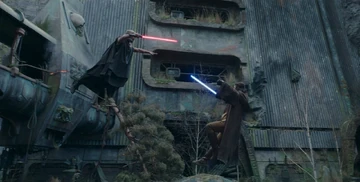
The hidden Sith strikes at the vulnerabilities of the Jedi Order following a series of impulsive Jedi decisions.
In 148 BBY,[68] four Jedi were stationed on the planet Brendok to investigate a vergence in the Force. A series of impulsive decisions made them come into conflict with the witch coven there, who sought to protect their secret of creating life, manifest in two bodies: Osha and Mae. Desiring an apprentice of his own, the Jedi Sol killed Mother Aniseya—even though she had decided to let Osha go become a Jedi—and let Mae fall to her apparent death amidst the chaos. The four Jedi took a confused Osha with them and vowed never to tell the truth of the events on Brendok to the Jedi Council, with Sol wishing to protect Osha from knowing the truth too.[69]
In 132 BBY,[68] two of those Jedi were assassinated, prompting an investigation by Master Vernestra Rwoh, who convened a meeting with several fellow Jedi. Although they concluded that the assassin was a highly skilled Force user, Rwoh rejected Ki-Adi-Mundi's suggestion that they inform the High Council of their findings, stating that the council would be obliged to inform the Senate. She resolved to keep their quest an internal Jedi affair and sent Master Sol to lead it.[70] Rwoh also kept in contact with Senator Isedwa Chuwant to prevent the increasingly popular Senator Worus Rayencourt and his allies from the Expansion Region to support an external review of the Jedi Order.[71] Together with Osha, Master Sol discovered that the assassin was Mae, who had survived the events on Brendok and been trained by a Sith.[67]

Vernestra Rwoh gave false testimony to Republic senators to cover up for the failings of the Jedi Order.
However, Osha was seduced by the dark side as she discovered that Sol had killed her and Mae's mother; Mae wanted Sol to face a trial before the Jedi Council and the Senate, but Osha instead killed Sol and joined the Sith. Believing that the Jedi would kill an individual who used the dark side, Mae asked the Sith to erase her memory and let her be captured by the Jedi to keep them ignorant of the events. Vernestra Rwoh realized that the Sith was a former Jedi pupil of hers and that her fellow Jedi had made a series of grave mistakes; nevertheless, faced with Senator Rayencourt's campaign for increased transparency of the Jedi Order, she lied to a Senate tribunal chaired by[67] Chancellor Veeth Drellik[72] about the events on Brendok. On behalf of the Jedi High Council, Rwoh claimed that the recent Jedi murders had been the sole responsibility of one man who had gone rogue and then taken his own life—Master Sol—thereby dismissing Rayencourt's call for a review of the Order.[67] In the wake of the High Republic Era,[25] the Republic would begin a slow march towards decay as the "old ways" of thinking started to fail[23] and corruption took root across the Republic, particularly in the Senate, where trade guilds and corporations were granted representation. The self-interest of many senators also helped to damage the Senate.[73]
Dooku confronting corruption[]
- "You serve the Senate."
"No. We serve the people of this Republic." - ―Senator Dagonet and Jedi Master Dooku
The Jedi Order had grown to be complacent and comfortable with its elevated stature in the Republic.[2] Jedi Master Dooku, who was born toward the end of the High Republic Era and had been Yoda's apprentice,[25] balked at such corruption.[2] Dooku was a son of the Count of Serenno, head of the noble-led assembly of the planet Serenno, named after the ancestor who led the charge against the Sith Empire.[75] Between 68 BBY and around 58 BBY,[74] when Master Dooku and Padawan Qui-Gon Jinn rescued the kidnapped son of Senator Dagonet, the Jedi found that the senator had been severely neglecting the people on his dilapidated world. Dooku's frustration broke out when the senator ordered his soldiers to kill the citizens who had kidnapped his son, and the Jedi Master stopped the soldiers and nearly killed the senator, but he was stopped by Jinn, who had also freed Dagonet's son. The latter promised the people that he would help them before departing with his father.[76]
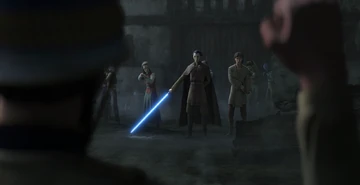
Jedi Master Dooku was frustrated with the corruption of Senator Dagonet.
Years later, Master Katri of the Jedi Council was killed on Raxus Secundus, and Masters Dooku and Mace Windu were sent to retrieve her body. However, Dooku deviated from their task to investigate Katri's death and confronted Senator Larik of Raxus, who revealed that his guards were responsible. The guards immediately killed Larik but were defeated by the Jedi. The assailants explained that they had wanted to force Larik to fulfill their wishes in the Senate; they believed that the senator was accumulating personal wealth at the expense of their planet by selling its resources to off-world companies for industrialization, and they also thought that the Jedi were merely enforcers of the Senate. Dooku expressed disagreement with the guards' methods but agreed with their ideology of protecting their world. Windu was subsequently offered a seat on the Jedi Council, and the younger Jedi explained to Dooku that the council had made the decision given that Dooku's actions had led to a senator's death.[77]
Corporate colonialism and slavery[]
- "As for my first act, I intend to cancel any and all contracts the government has with Czerka Corporation."
"You never did care for them."
"Nor did I make any secret of it. Yet the princess never realized we had so much in common. If she would've confided in more of us, she might have realized how much support there was for standing up to the company." - ―Governor Orth and Qui-Gon Jinn

Qui-Gon Jinn and Obi-Wan Kenobi on Pijal
Master Dooku had been introduced by his former Padawan Rael Averross to Senator Sheev Palpatine of Naboo after Dooku made an address to the Senate[75] in 42 BBY,[25] when Dooku left the Jedi Order to reclaim his birth title as Count of Serenno.[75] Averross served as the lord regent of the Inner Rim planet Pijal until Princess Fanry's coming of age and drafted a treaty alongside the arms manufacturer Czerka Corporation that would transfer power from the Pijali monarchy to a democratic Assembly. Fanry thought that the treaty's terms would prevent the Assembly from actually representing the population of Pijal's moon or be able to cancel contracts with Czerka, which would allow the corporation to further exploit the Pijali people and its enslaved workers. To this end, the crown princess sought to sabotage the treaty proceedings under the passionate belief that her subjects deserved actual freedom from Czerka, enlisting the assistance of the Blackguard—a clandestine division of the Pijali royal guard led by Captain Deren—to stage a violent series of attacks that Fanry framed for being the work of the Opposition performance troupe, who had been conducting their own series of peaceful protests against the signing of the Governance Treaty initiative. Although she was not involved with the blackguards, Minister Orth—one of Fanry's closest advisors and staunch proponent for Pijal tradition—expressed contempt for the capabilities of the Galactic Senate, believing that its members were more concerned with "posing for their re-election holos".[78]
In 40 BBY,[25] Qui-Gon Jinn and his Padawan, Obi-Wan Kenobi, were sent to ratify the Governance Treaty on behalf of the Republic. The Jedi learnt that Czerka was a politically powerful business, secretly using slave labor even in its factory on the Republic Core World Hosnian Prime. At her coronation, Queen Fanry stabbed Pijal's religious leader for accepting Czerka bribes and decried democracy before ordering an attack on the Czerka representative's starship—despite the presence of enslaved people aboard. Fanry's attendant and confidante, Cady, was shocked by the new queen's betrayal of her anti-slavery stance and forced the monarch to surrender. A Republic judicial ruling deemed Fanry's crowning illegitimate, and she abdicated her right to Pijal's throne, leaving her cousin Lamia to reign as queen to outlaw slavery and establish a democratic Assembly before dissolving the monarchy. Led by Governor Orth, the new democracy canceled all of Pijal's contracts with Czerka.[78] At some point after Dooku's departure from the Jedi Order, Qui-Gon Jinn was sent to rescue the runaway Jedi Padawan Lizel Liit, who was taken by Zarah Bliss to be auctioned to the highest bidder on Desinta. Jinn met with Prefect Aminar, the nominally elected leader of Desinta who was opposed by the Dan'Gar, a political group which also claimed Liit at the auction.[79]
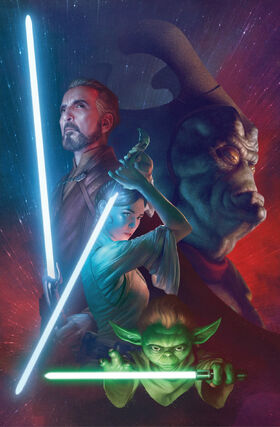
Jedi Knights faced an increasingly corrupt and dishonest galaxy, with even their own members becoming disillusioned and cynical.
In 40 BBY, Finis Valorum was elected as the Supreme Chancellor of the Republic.[80] Valorum tasked the Jedi Order with resolving the conflict between the worlds Vekura and Syrinx Prime. The Jedi initially defended Syrinx Prime against Vekura's "invasion" before they could arrange negotiations. Both sides refused to speak with one another and insisted that the politics between them were "complex." The Jedi Council found that both sides were not being truthful and decided to make both parties believe that negotiations would be to each of their best interests. To that end, the Jedi destroyed Vekura's shipyards and Syrinx Prime's weapon forges, and the consequent stalemate forced the two worlds to negotiate a peaceful end to their conflict.[81] At a later point, Jedi Master Yaddle and Jedi Knight Seera Longa mediated a dispute between the Trade Federation and the Gillanter Corporation and realized that neither side were being truthful about their affairs. Their investigation led them to cross paths with the former Jedi Dooku, who had promised to help the Trade Federation and promised to kill Gillanter's Lonkus. When Dooku's life was threatened, the Jedi abided by their values and saved him, though Dooku himself had abandoned his core values.[82]
Following members of the Gran species' violent colonization of the Mid Rim planet Malastare at some point in the centuries preceding the Galactic Empire, the Republic's Gran Protectorate Act notionally partitioned Malastare between Gran colonists on the eastern continent and the native Dug on the western continent. In effect, the Gran were granted control of the planet and were exclusively represented in the Senate.[83] Gran senators defended the Republic's status quo as the majority Dug population of Malastare were deprived of their rights by the Gran invaders and practically lived in slavery; Ask Aak, a Gran senator during the Clone Wars, had many Dug servants himself.[84]
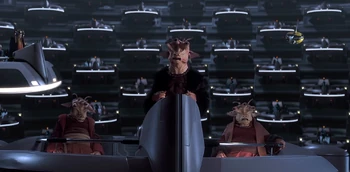
Malastare's Gran colonizers were prominent members of the Republic Senate.
Ask Aak replaced Senator Aks Moe,[84] who represented the Congress of Malastare in the Galactic Senate's Malastare delegation. It also included Senator Ainlee Teem of Malastare[3] and Baskol Yeesrim of the Gran Protectorate.[85] The injustice on Malastare was a point of embarrassment for the democratic Republic,[84] but a Republic fleet led by Wullf Yularen and supported by the Jedi[86] defeated Admiral Trench's Corporate Alliance blockade of the planet at[87] the Battle of Malastare Narrows in 34 BBY.[25] Senator Moe had significant influence among the Republic's politicians, courts, and lobbyists and profited from rampant criminality and disinvestment in Coruscant's lower levels.[88]
Moe particularly opposed the criminal justice reform proposals of the Coruscant Security Force Inspector Tanivos Exantor Divo. Divo spoke against the complacency produced by a thousand years of peace and changed tact after receiving stiff opposition from men like Moe who were well connected with the Republic bureaucracy, focusing on smaller cases to build up larger ones against Coruscant's crime lords and their associates in politics. The inspector also did not think highly of the Jedi Order that headquartered itself on the crime-ridden capital, but he appreciated the efforts of Master Quinlan Vos in helping local police.[88]
Trade and discontent[]
- "Because something dangerous is brewing in our little corner of the Outer Rim. Discontent is on the rise, as are criminal enterprises and mercenary groups in the employ of self-serving corporations. In the Seswenna sector, several lommite mining concerns are vying for the attention of the Trade Federation, which is determined to forge a monopoly in the free trade zones. Even on my own Naboo, the king finds himself embroiled with the Trade Federation and off world bankers with regard to our plasma exports. Ours are remote worlds, but what transpires in those sectors of the Outer Rim could very well have galactic repercussions."
- ―Senator Palpatine, to Tarkin
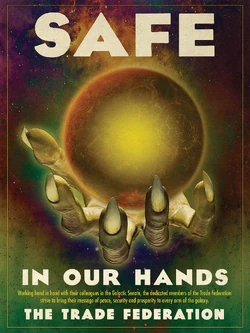
Safe In Our Hands poster by the Trade Federation
While the Republic's expansion bolstered the established Core systems' prosperity via trade, many outlying systems such as Eriadu were forced to take loans from the InterGalactic Banking Clan at high interest rates and thus accumulated debt.[8] Toward the twilight years of the Republic, many systems that wanted to join it had their applications delayed by senators of the metropole—particularly those who feared losing political influence in the Senate and wanted their own worlds to profit from the resources of new members without expending resources to the periphery.[89] Coruscanti-centric perspectives of the outlying systems typically treated them as a barbaric wilderness. Such beliefs were ingrained by the Outer Rim's high crime rates arising from a lack of Republic protection, driving resentment toward the Republic's elites and institutions among the peoples of the Outer Rim.[8]
While the Neimoidians gradually lost control of the Trade Federation to the Kuati of Kuat Drive Yards,[90] the Federation had consolidated a monopoly over the Free Trade Zones by the final decades of the Republic.[8] The corporation incentivized colonization, offering to guide colonists on their hyperspace routes based on tariffs set by the Federation itself[17] and its "protection" fees,[61] In 65 BBY, a joint venture between Naboo and Damask Holdings completed construction of the Theed power generator.[26] Its opening ceremony was attended by the Naboo official Sheev Palpatine, and it extracted plasma from the depths of Naboo to power the capital city of Theed. The complex's operations far exceeded Theed's energy needs, and energy was exported off-world in deals arranged via the Trade Federation.[9] Issues of the plasma trade with the Trade Federation and off-world bankers occupied the king of Naboo.[8] The Trade Federation also built up its own armed forces, with the Geonosian Archduke Poggle the Lesser's factories producing a massive droid army at the behest of a secretive Lord Sidious.[91] Geonosian society was industrious but was prone to warfare when the hives were idle, and the archduke agreed to an offer by Baktoid Armor Workshop to design those droid factories.[92]
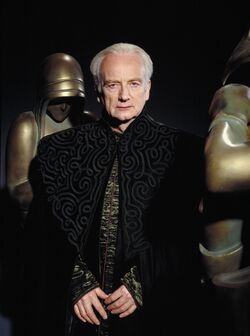
A seemingly modest Senator Palpatine of Naboo began cultivating influence in the Republic.
In lieu of protection from criminal gangs, the Republic member world Eriadu took its own initiative to establish the Outland Regions Security Force, which was funded by off-world loans, bought weaponry from arms manufacturers that had been ignoring a Republic ban on selling weapons to member worlds for centuries, and countered piracy in the Seswenna sector under Wilhuff Tarkin's leadership.[8] In 36 BBY,[25] Senator Palpatine allied with Tarkin, agreeing with his assessment that the Republic's Judicials were being obsoleted in favor of the Jedi Order. Palpatine supported Tarkin's bid to become the Governor of Eriadu, and Tarkin blocked Chancellor Finis Valorum's requests to investigate the Eriadu Conference; talks between the Republic and the Trade Federation on the Federation's tariffs in the Free Trade Zones had collapsed due to an attack by the radical Nebula Front, which killed the Federation directorate. With their removal, Nute Gunray of the Neimoidian faction was able to take over as the Viceroy of the Trade Federation[8] and Lott Dod became the corporation's senator,[61] wresting control from the Kuati; the Techno Union subsidiary Kuat Drive Yards firmly aligned itself with the Chancellor of the Republic instead.[90] Chancellor Valorum later managed to push for a Senate proposal to tax the Free Trade Zones.[61]
The Republic relied on volunteer soldiers and Jedi to resolve localized conflicts such as the Stark Hyperspace War,[12] of which Saesee Tiin was a veteran.[93] Tiin became a member of the Jedi High Council,[51] and in 33 BBY,[94] Qui-Gon Jinn challenged the council on their undue focus on large-scale issues while they allowed the closure of Jedi outposts such as the one scheduled to be shuttered on Kwenn, which had been established through great effort in the High Republic Era. Jinn and Obi-Wan Kenobi had witnessed the migration of people from Outer Rim worlds affected by the increased presence of criminal groups following the closure of such outposts, and all twelve members of the council agreed to embark on a mission to Kwenn to help its citizens despite the threat of pirates.[51]
In Wild Space, the Republic and the Jedi had intervened in the war between the Yam'rii and Kaleesh peoples. The Yam'rii had the benefit of advanced technology, exploiting and enslaving the people of Kalee until the Kaleesh warlord Qymaen jai Sheelal led his people in a ferocious campaign not only resisting the Yam'rii but also driving them off their homeworld of Huk. Having been displaced, the Yam'rii successfully sought the help of the Republic,[95] which censured the Kaleesh and imposed trade embargoes and fines that led to mass starvation.[96] Qymaen jai Sheelal, having taken the name "Grievous," developed a vendetta against the Jedi.[95]

Palpatine worked with Queen Amidala as Naboo's senatorial representative.
Around 33 BBY,[97] the HoloNet News reported on how Chancellor Finis Valorum's administration was beleagured by mounting political crises, including a row with the Trade Federation over taxation and the collapse of a Republic-mediated reconciliation effort between the Anselmi and Nautolan peoples of the planet Glee Anselm in the Mid Rim. The broadcaster was aware that Republic citizens were tired of "doom and gloom" over threats of war, though such news boosted the company's ratings, and it additionally reported on a pop icon dating a shockball star as a counterpart to the negativity. Count Dooku took advantage of Glee Anselm's dire situation in further destabilizing the Republic government.[98]
Two voices from Naboo[]
- "So many people from all over the galaxy, and all they could do was squabble. I told them that our people were suffering, and they would have made us wait until some committee flew out to the Chommell sector and checked. They were more concerned with voting along the lines of their alliance than they were with listening to problems and trying to find solutions. It was a mess, and Chancellor Valorum did nothing. Nothing."
- ―Padmé Amidala, to Sabé

Queen Amidala and her council were frustrated with the Senate's inefficient response to the invasion of Naboo.
In 32 BBY, Naboo was blockaded and invaded by the Trade Federation upon the order of Lord Sidious—Viceroy Gunray wanted to force the corporation's Senate dispute on trade route taxation to conclude in their favor. However, the sovereign Naboo people had democratically elected the fourteen-year-old Padmé Amidala as their queen[3]—her youth reflected Naboo culture's emphasis on education and protecting their monarchical tradition against the impersonal and cynical aspects of modern politics[17]—who refused to sign a treaty with the Trade Federation. The Chancellor had also sent Jedi ambassadors Qui-Gon Jinn and Obi-Wan Kenobi to Naboo, and they escorted Queen Amidala away from her world, which was being forcefully invaded by Viceroy Gunray's massive droid army.[3] The human Naboo people had colonized Naboo centuries ago, driving the native Gungan people underwater after arriving on the planet as refugees fleeing the Grizmallti civil war in the Core Worlds,[26] though the Trade Federation also drove the Gungans from their underwater cities.[3]
Along the way to the Senate on Coruscant, Qui-Gon Jinn recruited the bumbling Gungan Jar Jar Binks and the human boy Anakin Skywalker despite Obi-Wan Kenobi's objections. Skywalker had been enslaved on Tatooine since his fatherless birth by his mother, Shmi, and Jinn found that the boy had great potential in the Force—the Jedi believed that Skywalker was the prophesized Chosen One who would restore harmony in the Force, despite the Jedi Council's misgivings, and formed a fatherly bond with the boy. Meanwhile, the Queen was frustrated with the Senate's inaction and complacency as she observed its debates, with Senator Aks Moe agreeing with the Federation's Senator Lott Dod to simply establish a commission to evaluate the events on Naboo.[3]
Senator Palpatine then convinced Amidala that the Senate was suffering from Chancellor Valorum's weak leadership and alleged that he was being unduly influenced by the Republic's bureaucrats, who were in turn on the payroll of the Trade Federation. Palpatine thus successfully suggested Amidala to move a Vote of No Confidence in Valorum. Unwilling to sit by in further deliberations while her people were being rounded into prisoner camps, Queen Amidala then returned to Naboo with the Jedi. Despite the traditional mistrust between the human Naboo and the Gungans, Queen Amidala humbly appealed to the Gungan Boss Rugor Nass for help. Boss Nass was amused by the humans' casting aside of their typical sense of superiority and gladly accepted to form a coalition. The two peoples embraced their symbiotic bond and defeated the Trade Federation on their homeworld. However, Qui-Gon Jinn was slain by a Sith Lord—the likes of whom the Jedi Order had assumed to be extinct for a thousand years—who was then defeated by Obi-Wan Kenobi.[3]
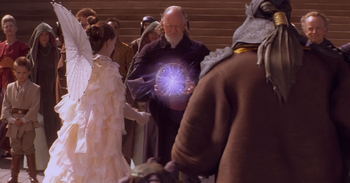
The humans and Gungans agreed to share their homeworld in peace after uniting to repel the Trade Federation invasion.
Meanwhile, with Valorum defeated in government, Palpatine took advantage of other senators' sympathy for Naboo to win the following Chancellorship election, which was contested by Bail Antilles of Alderaan and Ainlee Teem of Malastare. Unbeknownst to virtually everyone else, Palpatine was secretly Darth Sidious—the master of Qui-Gon Jinn's killer and mastermind of the Trade Federation invasion.[3] As Supreme Chancellor, he retained Mas Amedda as the Republic's Vice Chancellor and the Senate's Vice Chair and Speaker, with the canny bureaucrat being one of the very few individuals who knew that Palpatine was a Sith Lord.[100] Dooku had allied with Sidious, believing that the Jedi blindly served a corrupt Senate and regretful over the death of Jinn, his former Jedi apprentice. Sidious anointed Dooku as his new Sith apprentice under the name "Darth Tyranus."[101]
A Republic divided[]
- "Loyalty to the Republic is paramount. Loyalty to democracy."
"And what if democracy does not return the favor?"
"Then you must work to restore the democratic process." - ―Senators Bail Organa and Padmé Amidala
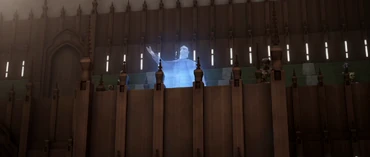
Having forsaken the Jedi, Dooku called on Republic star systems to secede and threaten to take the path of war.
The Gungan High Council subsequently contributed to their planet's democratic process alongside the humans, particularly for off-world relations.[26] Four years after the Trade Federation invasion and after refusing an offer to amend the Naboo constitution to stay as queen, Padmé Amidala took up the post of Republic Senator for Naboo and the wider Chommell sector at the request of the newly elected Queen Réillata. Amidala joined the political faction led by Senators Bail Organa of Alderaan, Onaconda Farr of Rodia, and Mon Mothma of Chandrila. Although they suspected Senator Mina Bonteri of Onderon of covertly working against the Republic's interests and were wary that she was befriending Amidala, Organa spoke with the new senator and realized they shared faith in the Republic and its principles of galactic democracy.[6]
In 24 BBY, Dooku gave the landmark Raxus Address, in which he lambasted the Republic's ineffectual bureaucracy and corruption and inspired many worlds to leave the Republic.[2] Dooku unsuccessfully attempted to recruit Tarkin as Eriadu's governor to the Separatist cause, proving Tarkin's loyalty to Palpatine[8] and preventing the count from having a economic stranglehold over the Republic.[12] Chancellor Palpatine held on to power past the typical term limits due to the resulting Separatist Crisis, with evermore star systems discontent with the Republic's system of governance threatening to leave the union.[1]
Nute Gunray remained as viceroy of the Trade Federation despite undergoing four trials at the Republic's Supreme Court, and, with an eye on personal profit, he secretly pledged military support for the secessionist movement's new rival state[1]—Dooku's Confederacy of Independent Systems.[2] The Trade Federation's reparations to Naboo paid for the new Theed Spaceport,[9] and the courts additionally ordered the corporation to reduce its army—however, economic concerns meant the Jedi were not allowed to investigate rumors that this was not carried out.[1] A number of the Haor Chall Engineering Corporation's IG-227 Hailfire-class droid tanks, initially commissioned for the Intergalactic Banking Clan to enforce debt collection, were owned by Danry Ledwellow, a senator of the Republic who took bribes from Thalassian slavers operating on Er'Kit.[102]
War and peace[]
Road to Geonosis[]
- "It's-a clear desa Separatists made a pact wesa desa Federation du Trade. Senators! Dellow felegates! In response to this direct threat to the Republic, mesa propose that the Senate give immediately emergency powers to the Supreme Chancellor!"
- ―Representative Jar Jar Binks
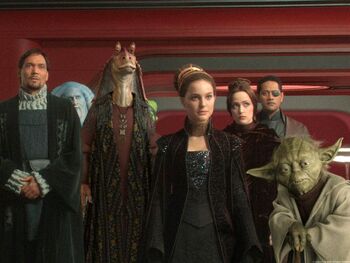
The targeting of Senator Amidala, a vocal advocate of the Republic's constitutional and peaceful democracy, prompted intervention of Jedi.
Several senators, including Bail Organa, Padmé Amidala, Ask Aak, and Orn Free Taa of Ryloth, joined Chancellor Palpatine's Loyalist Committee as advisors, wishing to defend the Republic's integrity, democracy, and peace as more member systems joined the Separatists. On behalf of Queen Jamillia, Amidala also tirelessly campaigned against the Republic's Military Creation Bill, which she believed would prompt the Separatists to seek armaments from the Commerce Guild or Trade Federation. She knew the corporations had undue influence over Republic bureaucrats, judges, and senators and feared that they would push the galaxy into civil war.[1] The veteran senator for the Raioballo sector, Horox Ryyder, supported Amidala's position against the bill but, depressed and exhausted by politics, bitterly retired from the Senate even though he was one of its most respected members. Ryyder subsequently toured every world that he had represented and continued speaking out against the endemic corruption in the Republic.[84]
Also among the bill's opposition were the Roshu Sune, Gotal terrorists who wanted their homeworld of Antar 4 to leave the Republic. A poet laureate of Kooriva made the poster Political Doubletalk for the Roshu Sune's "United Committee for Galactic Peace" front, alleging that Chancellor Palpatine was engaging in linguistic distortion, advocating security and order to actually benefit his politics of war.[17] The government of Carida supported the Military Creation Bill given that the Carida Academy of Republic Military personnel stood to benefit from it, investing over two million credits to back the re-armament campaign.[103] Ahead of a crucial debate on the legislation, Dooku hired bounty hunters to assassinate Amidala[1] in 22 BBY to no avail.[25]
At a meeting between Palpatine's committee and members of the Jedi Order, the High Council admitted that it was unaware of the identity of the assassins' benefactor but vowed to investigate. Amidala placed her suspicions on Dooku and believed that he intended to destabilize the Republic, though the leading Jedi Council member Ki-Adi-Mundi dismissed Dooku as simply a "political idealist." Later in private, Jedi Master Obi-Wan Kenobi discussed his skepticism of all politicians with his Padawan Anakin Skywalker; though Skywalker felt Amidala and Chancellor Palpatine were different from most politicians, Kenobi spoke from his experience that senators forgone the "niceties of democracy" to appease those who would fund their political campaigns, and he also thought that Palpatine cleverly took advantage of senators' "passions and prejudices."[1]

Democratic politics were discussed between Anakin Skywalker (left) and Padmé Amidala (right).
On the Jedi Council's suggestion and the Chancellor's order, Amidala briefly hid on Naboo with Padawan Skywalker to prevent further attempts on her life. Queen Jamillia welcomed the two and—after discussing corporate corruption and influence over the Republic's bureaucratic, legislative, and judicial branches and contributions to the heightening tensions between the Republic and the Separatists with Governor Sio Bibble—the queen declared that they must all maintain "faith in the Republic," as "the day we stop believing democracy can work is the day we lose it." As Amidala and Skywalker retreated to the meadows in private and fell in love, the pair debated democracy—as opposed to simply "popular rule," Amidala believed that constitutional laws such as term limits were integral to democracy so that politics gave people what they "needed" rather than simply what they "wanted," while Skywalker expressed his admiration for Palpatine as a strong leader.[1]
Meanwhile, Master Kenobi reported to Jedi Council leaders Yoda and Mace Windu of his discovery of a clone army. Kenobi was told that it had been ordered by the late Master Sifo-Dyas on Kamino[1]—an extragalactic world outside the Republic governed by Prime Minister Lama Su and his Ruling Council[9]—and the clone troopers who composed the army were based on the bounty hunter Jango Fett, who claimed to have been hired by a "Lord Tyranus." Meanwhile, Tyranus himself, in his public persona as Count Dooku on the planet Geonosis, closed a clandestine deal with corporate leaders who pledged support for the Separatist cause.[1]
Master Kenobi's discovery of a Separatist Droid Army on Geonosis prompted Vice Chair Mas Amedda to persuade Naboo's Gungan representative, Jar Jar Binks, to call on the Senate to grant the Chancellor unprecedented emergency powers to form a new Grand Army, whose ranks would be composed of the newly discovered clone troopers. Following Binks' urging[1] and with it seeming as though there was little choice in fighting back,[104] the fearful Senate[105] empowered the Supreme Chancellor[1] lest they be attacked by the Separatists[105] without a military of their own. Palpatine pledged his "love" for democracy and the Republic and promised to lay down his powers at the end of the conflict.[1]
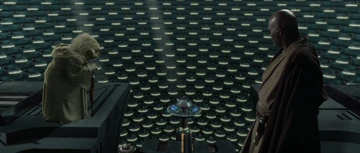
The Jedi watch from the sidelines of the Senate, which votes to support Palpatine and his war.
Yoda later reflected that the Jedi were quick to join the conflict out of arrogance and fear, and even the wisest of the Jedi were clouded by the dark side arising from within themselves[106]—Yoda and Windu were aware that their ability to use the Force had diminished but, believing that only the Sith knew of their weakness, decided against informing the Senate for fear that doing so would provoke more opposition against the Jedi. When a host of Jedi attempted to rescue Kenobi, Skywalker, and Amidala from Separatist detainment on Geonosis, Dooku, intent on starting a war, ordered the execution of all the Jedi there. Clone forces led by Yoda then rushed in and engaged the Separatists, swiftly winning the battle under Jedi leadership while failing to stop the Separatist leadership from fleeing.[1]
Rapid militarization[]
- "You see, the victory of the clone army, for now, is the only thing that can lead us to peace."
- ―Supreme Chancellor Sheev Palpatine

The Jedi Order found itself the military commanders of the Republic armed forces.
The Jedi were irrevocably drawn into the so-called Clone Wars. The Jedi Military Integration Act formally made Jedi Knights generals of the Grand Army of the Republic, and even young Padawan learners were folded into the frontiers of war, becoming Jedi Commanders.[62] Darth Sidious had the additional advantage that the Jedi Council continued meeting in the Jedi Temple, where their wisdom was clouded by the historical Sith's dark side energy from the Shrine in the Depths,[8] as well as by their own dark side, with more Jedi experiencing fear, anger, and hate.[106] Under Jedi leadership, the clone troopers were deployed across the galaxy by the Republic[62] and fought in the name of galactic democracy, an ironic idea considering that the clones themselves had few individual rights.[108] All the same, the clones quickly came to exhibit signs of individuality, which was encouraged by the Jedi.[109] Republic warships, such as the Acclamator-class transgalactic military assault ship, were considered military assets mobilized in the name of defending democracy.[110]
The Separatist Droid Army answered directly to Dooku's minion, Supreme Martial Commander General Grievous, rather than the Separatist Parliament.[2] The Confederacy's laissez-faire model removed Republic protections against slavery and exploitation of workers as well as for autochthonous sentient beings' rights and environmental protection. While localized resistance arose on Separatist Alliance worlds, local governments ceded political control and resources to Dooku and the Separatist Council. The council oversaw the administration of government and the war effort, being formed of corporate backers[12] that dealt in secret, sidelining the Separatist Parliament.[2] Parliament was led by Speaker Bec Lawise with an ideology of minimal taxation and trade regulation, but the congress was divided between senators who opposed Dooku's war powers or war taxes and senators who wanted to extend the war.[12]
The Military Creation Act spurred the Republic's founding Corellia system to close its borders and other star systems to vow to retain their own defense forces or even declare their independence from the Republic—they wished to avoid paying more taxes to fund the new army.[111] Cato Neimoidia and the Trade Federation declared neutrality at the start of the war,[62] although the Federation's neutrality was little more than a mask to cover its eventually clear[23] bias towards[112] and sponsorship of the CIS. In what was effectively an open secret by the war's end, other corporations, such as the Techno Union, did much the same by declaring neutrality while helping to maintain the Separatist cause.[23] Despite her dislike of the Trade Federation's leadership, the Neimoidian guard Ruug Quarnom believed in the concept of the Federation as a champion of the Neimoidians and thought that the Republic treated her people as no more than shipping statistics, though Quarnom also believed that some Republic citizens were reasonable. When Cato Neimoidia's capital was bombed, both the Republic and the Confederacy sent emissaries to aid in investigating the disaster. Obi-Wan Kenobi represented the Republic while Asajj Ventress represented the Confederacy, and the latter radicalized Quarnom's colleague against the Republic and goaded him to try to bomb the Jedi.[62]
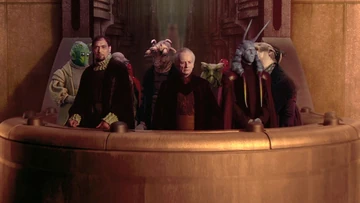
Padmé Amidala's opposition to militarization in the Senate was overruled by Palpatine's emergency powers and machinations.
The Reflex Amendment to the Republic constitution gave the Chancellor's office near-total power over military matters, making Palpatine the most powerful Chancellor since the Ruusan Reformations.[113] The Senate's Naval Subcommittee approved contracts with Techno Union subsidiary arms manufacturers such as Sienar Systems, Kuat Drive Yards, and BlasTech Industries to supply the fleets. However, the Techno Union had also pledged its armies to Count Dooku, manufacturing a million Separatist battle droids per Republic warship.[12] The Kuat subsidiary Rothana Heavy Engineering had supplied the Kaminoan government with the Acclamator-class cruisers that Yoda led on Geonosis,[114] and the commissioning of Venator-class Star Destroyers bolstered the Republic's deep-space warfare capabilities.[113]
Moral quagmires[]
Christophsis crises[]
Republic Venators failed to breach Admiral Trench's blockade of the strategically positioned planet Christophsis, where Senator Bail Organa of Alderaan reported a dire lack of food, water, and munitions at his Republic-run refugee camp. Among Trench's starships was a Providence-class Dreadnought, a class that was built by the Quarren-ran Free Dac Volunteers Engineering Corps and Pammant Docks for Viceroy Gunray of the Trade Federation following the Naboo invasion of 32 BBY.[114] Republic and Jedi ingenuity, coupled with the Sienar stealth corvette and clone sacrifices, played a key role in eventually winning the Battle of Christophsis, a victory that was hailed by Republic High Command as an example of Jedi-clone cooperation despite the betrayal of a clone trooper,[115] Sergeant Slick.[116] Slick's betrayal forced the Jedi to emotionally deal with the factor of free will within the clone ranks.[115]
Legitimizing the Hutt Clan[]
- "We must help Jabba. This is the opportunity we've been looking for. The Jedi must rescue Jabba's son."
"I don't like it, dealing with that criminal scum. This is a dark day for the Republic."
"I agree, my friend, but what choice do we have? The Hutts control the Outer Rim, and we'll need their space lanes in order to move our troops." - ―Supreme Chancellor Palpatine defends allying with the Hutt Clan to Jedi General Mace Windu

In the name of securing victory, the Republic legitimized the criminal activities of the notorious Hutt Clan.
When the crime lord Jabba the Hutt's son was kidnapped, Chancellor Palpatine asked the Jedi Order to rescue him so that the Republic may negotiate military access to Hutt-controlled hyperlanes in the Outer Rim. Mace Windu opined it was a "dark day for the Republic" to be working with the Hutt gangsters, but Palpatine defended the action as a necessary evil. In response, Obi-Wan Kenobi and Anakin Skywalker were diverted from Christophsis to negotiate a treaty with Jabba and rescue his son. After the Jedi found that Dooku and the Separatists had secretly kidnapped the child and framed Skywalker for it during the Battle of Teth, Palpatine offered the news to Senator Padmé Amidala during a meeting about security measures the Chancellor had put into place on Naboo. Palpatine had justified those new security measures due to the sudden eruption of the Battle of Teth and other battles in the Outer Rim.[117]
Concerned for her husband and becoming focused on the crisis, which stopped her from meeting with Palpatine about his security endeavors, Skywalker's predicament prompted Amidala to attempt to re-establish contact with Jabba and negotiate a treaty by herself as a representative of the Galactic Congress. She exposed Ziro the Hutt's conspiracy with Dooku to force the Hutts against the Republic, and Skywalker safely returned to Jabba his son with his new Padawan, Ahsoka Tano. The resultant treaty allowing the Republic to use Hutt routes to the Outer Rim set back the Separatist war effort[117] while legitimizing the Hutts' businesses. Hutt Clan lawyers further amended the agreement to allow the Hutts to peek into affairs in Republic space, access routes in the Mid Rim, and make inroads into the Core.[88]
The Ryloth crisis[]
- "We need to remember why we're here. We came to aid the Twi'leks, not destroy their home."
- ―Jedi General Obi-Wan Kenobi, to his troopers

Representative Binks deployed his antics to distract Neimodian delegates from Republic supply ships trickling up Toydaria's sky.
When the Separatists blockaded and invaded the Republic member planet Ryloth,[119] local residents were forced to surrender after a group led by the radical Cham Syndulla was massacred near Lessu City.[120] Millions of Ryloth citizens were forced into starvation, and Republic Senator Bail Organa and Representative Jar Jar Binks appealed to King Katuunko and his ministers on Toydaria for assistance. Although the Toydarians were keen to remain "neutral" in the war due to pressure from Senator Lott Dod of the Trade Federation and formally refused to allow the Republic to ship relief supplies to Ryloth via Toydarian territory, King Katuunko privately gave assent for Organa and Binks to stage their relief mission in secret from the Trade Federation delegates on Toydaria.[119] The king subsequently decided that Toydaria should join the Republic after negotiations with the Separatists broke down given that Separatist leader Asajj Ventress had broken her word and ambushed the Republic delegation led by Master Yoda and the Coruscant Guard's diplomatic service.[121]
Separatist Emir Wat Tambor of the Techno Union oversaw the occupation of Ryloth, tasking the tactical droid TX-20 with preventing Republic soldiers from landing using heavy artillery in the city of Nabat. The native Twi'leks were deprived of food and forcibly displaced, their homes having been destroyed while the streets were left barren—TX-20's battle droids took the Nabat's inhabitants hostage and used them as living shields among the cannons, predicting that the Jedi would not be willing to risk the hostages' lives. Indeed, Jedi General Obi-Wan Kenobi was unwilling to endanger the Twi'leks after he and his forces breached Nabat's high wall, yet clone troopers Waxer and Boil found a displaced Twi'lek girl, Numa, who showed them Nabat's underground tunnels. Kenobi's forces distracted TX-20 while the Jedi, Waxer, and Boil freed the Twi'leks and destroyed the cannons. Kenobi and Numa were nearly killed but the Twi'leks, unarmed but angry, overwhelmed TX-20's tank and dismantled the droid, freeing their own home.[118]
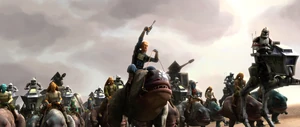
While he was greatly concerned for what future awaited Ryloth if he aligned with the Republic, Cham Syndulla believed he had no choice but to partner with the clone army due to the damage caused by Confederate occupation.
As Jedi General Mace Windu led Republic forces to Lessu, Count Dooku ordered Emir Tambor to evacuate from Ryloth while causing maximum damage, intending to signal the high cost of a Republic victory. Windu asked Cham Syndulla and his Twi'lek Resistance for support in liberating the capital. Informed by his mistrust of Senator Orn Free Taa and the possibility of an armed occupation of his homeworld under the Republic, Syndulla was hesitant to commit his group to the Republic's efforts until he heard that Separatists had firebombed villages around Lessu, which were filled with women and children. Senator Taa was likewise suspicious, concerned that Syndulla would seek power on Ryloth, but Windu convinced the two men to agree on a compromise. The senator promised that the Republic Army would leave Ryloth once the droids on the planet were beaten, and the freedom fighter affirmed that he believed in democracy.[120] In an attack remembered by the Twi'leks as the "Hammer of Ryloth,"[122] the joint forces prevented the Separatists from destroying Lessu and accepted their unconditional surrender from Tambor shortly afterward. Additionally, for all of Syndulla's fears about the future of Ryloth under a now-Republic occupation,[120] the battle had earned Windu his respect.[122]
A grievous commander[]
- "General Grievous is a critical part of my plan for the Clone Wars."
- ―Darth Sidious

The brutal General Grievous (mask depicted as a shadow) was a useful figure to wartime Republic propaganda.
General Grievous was a critical figure in Sidious's plans for the Clone War.[123] With the cyborg leading brutal campaigns across the galaxy,[124] his actions spread fear and destruction across the Republic.[125] When Grievous captured Obi-Wan Kenobi and his clone battalion on Caliban, he forced them to rebuild a bridge despite Kenobi objecting on the basis of the Galactic Accord of Systems, which said prisoners of war should not be forced into manual labor.[126] Jedi Master Ki-Adi-Mundi's encounter with General Grievous in the early weeks of the war brought to light the infamous brutality of the Separatist general,[62] who led a slaughter on Hypori that demoralized Republic forces.[127]
Indeed, Republic propaganda exploited Grievous as a figure of "evil," such as by depicting the general's mask in works like Keep Our Republic Secure and Evil Has Its Eyes On You. Republic propaganda depicted Grievous as a "mechanical monstrosity," taking advantage of the deep-seated droidophobia that the Clone Wars kicked up and worsened.[17] Meanwhile, Separatist citizens were shielded from the worst of Grievous's actions.[128] Clone troopers listened and watched the Grand Army of the Republic broadcast, hosted by Hologram VJ as "the voice of the Outer Rim" to keep up morale on the front lines, such as for the Mud Jumpers "slugging it out" on Mimban.[129] Mimban's rainforests were devastated by the Separatists' indiscriminate mining practices, resulting in significant mud deposits.[130] The Republic's 224th Division trained and fought alongside Iasento and his tribe of Mimbanese against Separatist droids who invaded their world[131] and sought its hyperbaride minerals.[132]
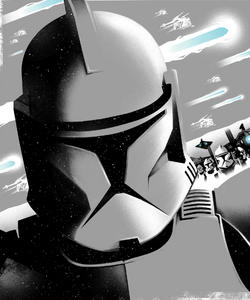
Clone troopers were heralded as the last hope of a democracy that did not recognize their own rights.
Grievous also launched a devastating campaign on the Republic using the dreadnought Malevolence,[125] which was built by the Free Dac Volunteers[114] and Pammant Docks[133] and armed with mega-ion cannons. The campaign spread fear across the Republic as it wiped out dozens of Republic warships[125] and pushed into Core Worlds territory.[25] The Malevolence destroyed Venators and even targeted medical transports and the Kaliida Shoals Medical Center, which was undefended and filled with over 60,000 injured clone soldiers.[134] When Jedi-led forces were poised to overwhelm the Malevolence, Grievous briefly took Senator Padmé Amidala hostage in an effort to call off the Republic assault before abandoning the Malevolence, which Skywalker and Kenobi boarded, joined Amidala and C-3PO aboard, and reprogrammed by sending it into a crash course into the Dead Moon of Antar.[135]
Shadowfeeds and schemes[]
- "The charter of Chancellor maintains the emergency powers granted by Palpatine […] They are a poison to democracy."
- ―Mon Mothma, reflecting as Chancellor of the New Republic on the office's past
Until Republic forces destroyed Skytop Station, Grievous led another campaign in which he ambushed Republic fleets using intelligence collected via the listening post.[136] The station was overseen by the ex–Republic Aqualish Senator Po Nudo's Hyper-Communications Cartel, which also ran anti-Republic Shadowfeeds on the HoloNet,[12] supervised by the propagandist and Separatist parliamentarian Ansibella Dellu of Raxus Secundus. The Republic Navy was able to shut down the Shadowfeeds, and the Commission for the Protection of the Republic (COMPOR) was founded in response. Associated with Republic Admiral Wilhuff Tarkin, COMPOR produced populist propaganda that supported the consolidation of power in the Chancellorship; Palpatine was granted direct control of the HoloNet, which featured damning footage of Separatist rights violations that were timed to attempts for peace talks in the Senate.[17] Furthermore, official conversations between Republic senators and their Separatist counterparts was illegal under Senatorial decree for fear it would legitimatize the Separatist cause. Palpatine alleged that he was open to negotiation with the Separatists, only to also claim the CIS always ignored his alleged pleas for peace,[137] leaving it to seem as though military victory in war was the only path forward.[107]
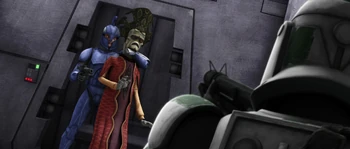
Senate Guard Argyus betrayed the Republic in the hope of a lucrative reward.
Later in 22 BBY,[25] Senator Farr of Rodia accepted a deal with Viceroy Nute Gunray to ally with the Separatists and capture Senator Padmé Amidala—Farr's longtime friend and Gunray's hated political nemesis—in exchange for vital supplies. Representative Jar Jar Binks and protocol droid C-3PO proved to be steadfast companions of Amidala's, and Senator Farr decided to help arrest Viceroy Gunray before Chancellor Palpatine pledged relief efforts to Rodia.[138] Fearing that such turn of events meant Gunray would leak important secrets to the Jedi, Darth Sidious arranged for the viceroy to be either rescued or assassinated while he was in transit—Asajj Ventress worked with Senate Commando Captain Faro Argyus to free the prisoner. Having been promised a fortune by Count Dooku,[139] Argyus' betrayal of the Republic weakened the authority of the Senate Guard—elite soldiers clad in distinctive blue armor charged with defending the Republic Senate and its representatives—and Chancellor Palpatine took the opportunity to expand his favored contingent of Red Guards.[12]
As the war progressed, the Republic Security Council changed from a Senate committee that made recommendations to the legislature into an advisory council for the Supreme Chancellor on military matters. It oversaw decision-making on which worlds to defend or attack and, along with the Chancellor, could activate any of the 150 general orders subconsciously memorized by each clone in the Grand Army. While Republic civilians ran the Senate Bureau of Intelligence, it was separate from the Republic Intelligence service under the military.[12] At some point during the war, Republic citizens staged a protest at the Carida Academy against militarizationin which a demonstrator was killed.[140]
The successful detonation of an electro-proton bomb secured the Republic's victory at the Battle of Malastare, but it also awakened the Zillo Beast with its seemingly indestructible armor. The Dug Council agreed to give the Republic access to Malastarian fuel in return for the Republic's protection, and Chancellor Palpatine ordered the creature to be cloned for further research.[141] Following the Second Battle of Geonosis and the capture of Archduke Poggle the Lesser, Palpatine presented plans for a weapon of mass destruction to the new Strategic Advisory Cell, a highly exclusive group of a few select senators, military officials, scientists, and industrial representatives that oversaw its Special Weapons Group in constructing the battle station in the Geonosis system—ostensibly necessary because the Separatists were developing one based on Geonosian schematics. Artificial intelligence specialist Dr. Gubacher oversaw augmented droids to expedite progress on the station. Other scientists unknowingly attached to the project and assigned to developing its various aspects were monitored by a dedicated branch of Republic security.[92]
The cell's members met at the Republic Center for Military Operations, which had been remodeled and expanded by Orson Krennic of the Corps of Engineers, and were subject to the Official Secrets Act, which required members to keep their business secret to outsiders, including the Jedi Order. Once appointed as coordinator of the Special Weapons Group, Lieutenant Commander Krennic took an interest in Dr. Galen Erso's renewable energy research for Zerpen Industries, which studied kyber crystals at an experimental fusion facility on Vallt in the Outer Rim. When Vallt joined the Separatist Alliance, Vice Chancellor Mas Amedda allowed Krennic to take the initiative leading Republic forces in abducting scientists working on a virus that targeted clones from the Separatist world Merj and brokering a sham exchange on Vallt, in which the Erso family were freed only for Republic forces to bombard the Separatist-allied faction.[92]
Defenders of diplomacy[]
- "What has happened to democracy… and why doesn't anyone seem to care?"
"Well, you do. Forgive me, my lady, umm… you're not like most politicians."
"If only that were enough, Teckla." - ―Padmé Amidala and Teckla Minnau
While they preferred the Separatists over the Republic, many major corporations that supported the CIS maintained the shaky mask of neutrality[23] in order to maintain their business with the Republic as a means of war profiting off both sides.[143] For example, the Trade Federation remained officially neutral and continued to be represented in the Republic Senate by Lott Dod.[112] Other Separatist corporate backers, the Techno Union and the Banking Clan, likewise remained represented in the Senate by Gume Saam and Nix Card respectively. The trio plotted together despite Card's contempt for Saam.[137] Conversely, Magistrate Passel Argente of the Corporate Alliance and Kooriva withdrew as a member of the Republic Senate,[91] and Voe Atell represented the alliance in the Separatist Parliament, which met on Raxus Secundus.[137] The Commerce Guild, which competed with the Corporate Alliance, similarly pledged its forces to Count Dooku under Presidente Shu Mai of Castell[12] but did not openly join the Separatists,[144] though Amita Fonti represented the guild in the Separatist Parliament. The CIS prided itself as a state that was not under the rule[137] of corporate monopolies, as its members proclaimed the Supreme Chancellor[145] and Republic were.[137] However, with the establishment of the Separatist Council[1] and the great power the corporations held as the Confederacy's sponsors, Separatist fighter Hressk would reflect that the Confederacy had indeed sold itself out to corporate masters, all in the name of maybe securing the right of self-determination.[23]
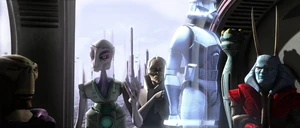
Halle Burtoni was part of a grouping of senators who defended their pro-war attitude as Republic patriotism.
In 21 BBY,[25] Count Dooku and Jedi Generals Obi-Wan Kenobi and Anakin Skywalker were captured by Hondo Ohnaka and his pirate gang following a battle. The Republic sent the Gran Senator Kharrus, Representative Jar Jar Binks, and diplomatic service shock troopers to deliver a hefty ransom of spice to the Ohnaka Gang in exchange for the captives. The mission fell apart when Kharrus and several troopers were killed and Dooku and the Jedi escaped separately.[146] As Senator Gume Saam of the Techno Union pushed for a financial reform bill to deregulate the InterGalactic Banking Clan to open more lines of credit to fund the Republic Military, the Loyalist Senators Padmé Amidala, Bail Organa, Onaconda Farr, and Mon Mothma led the opposition. The bill was also supported by the Kaminoan Senator Halle Burtoni.[137]
Meanwhile, Padawan Ahsoka Tano joined Amidala as the senator broke a Republic law prohibiting diplomatic contact with the Separatists by meeting the pro-peace Onderonian politician Mina Bonteri, and they spearheaded the Confederate–Republic peace initiative. When Voe Atell declared that the Corporate Alliance would not allow the Confederacy to make a peace offering in the Separatist Parliament, Kerch Kushi countered that the Confederacy was a democracy and, "unlike the Republic," was not ruled by corporations. Tano discussed the politics of war with Senator Bonteri's son, Lux Bonteri, and learnt from her time on Raxus that there were heroes on both sides.[137]

Arguments for and against peace with the Republic were hurled across the Separatist Parliament's benches.
However, Dooku bypassed the Separatist legislature by bombing Coruscant's power supply, and then ordering a secret assassination of Mina Bonteri, blaming the murder on the Republic, which scuppered the peace process.[137] Outraged members of the Senate such as the pro-war Tarnab Mot-Not Rab and Zinn Paulness approved the deregulation bill, debates on financial reform nevertheless continued with Senator Halle Burtoni's proposal for the Republic to purchase five million more clone troopers. The Banking Clan, which had been charging the Republic 10% interest on its war loan, claimed that it lended money to the Separatists at an increased interest rate to fund three million new battle droids and increased its Republic interest rate to 25%.[16]
Amidala believed that the Republic would be bankrupt if the Senate passed the bill, leading to public spending cuts to the maintenance of basic social services, education, healthcare, and infrastructure. However, senators who were not in support of the proposals were being intimidated and even severely assaulted by thugs hired by Dooku on Coruscant, which was already experiencing mandatory power blackouts[16] and other harsh austerity measures of water and foodstuff under the Victory Rationing Program.[113] Despite Senators Farr, Amidala, and Organa being attacked in succession in the streets of Coruscant, Amidala's aide Teckla Minnau encouraged the Naboo politician to address the Senate.[16]
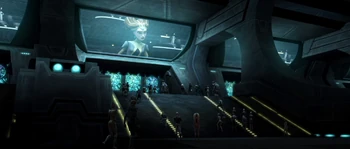
Senator Amidala was defiant in arguing against military spending increases at the expense of basic services to Republic citizens.
By citing Minnau as a Republic citizen whose livelihood depended on the basic services provided by the Republic, Amidala argued that the lives for which the Republic defended in the war would be upended if state funding was diverted to the military. Other senators were thus persuaded to defeat the bill, slowing the war to the Chancellor's private annoyance; Palpatine spoke with Mas Amedda about having "all the power in the galaxy" yet a single senator was able to "sway the thought of millions," resolving that they must, "for now," allow the Senate's proceedings to continue and follow "the principles of our democracy."[16]
The Senate eventually passed the proposal to increase military spending and rejected Senators Amidala and Farr's motion to reduce it[107] despite Amidala having succeeded in persuading the Roonan Senator Aang, who held the deciding vote on the issue on the Military Oversight Committee.[147] After the vote, Palpatine claimed to Amidala that he did not support the increased troop production, but he also alleged ensuring the clone army's victory was the Republic's only option in pursuing peace and such was a natural thing to do after increasing secruity in the Senate. In any case, Palpatine claimed to Amidala that he was upholding democracy by allowing the policy he supposedly did not agree with to stand.[107]
No safe refuge[]
- "I know that there are those among the Separatists who would end this conflict, and I know that there are those individuals in the galaxy who would seek to promote fear and spread chaos. To those who act as agents of chaos, I say this: I stand resolute and unyielding. And if you strike my voice down, know that a chorus of thousands shall rise up in its place, for you have no dominion over the righteous. We are the defenders of truth."
- ―Padmé Amidala

Strength and Unity poster showcasing peoples of diverse backgrounds uniting for the Republic
As a part of the Republic, the Pantoran people of the moon Pantora claimed Pantora's planet, named Orto Plutonia, as their protectorate territory as it was believed to be uninhabited. Despite discovering the presence of the native Talz people[149] in 21 BBY,[25] the Pantoran Supreme Chairman Chi Cho insisted on his people's sovereignty over the planet and declared war; the Jedi were not able to interefere in their capacity as the Republic Senate's peacekeepers as Chairman Cho declared that the Pantorans' dealings with the Talz were an internal affair. Pantoran Senator Riyo Chuchi then spoke with the democratic Pantoran Assembly, which declared Cho's act of war as out of order and whose speaker authorized the senator to petition the Jedi Council to interefere. However, Chuchi was able to negotiate directly with the Talz Chieftain, Thi-Sen, ending the war with the Pantoran people recognizing the sovereignty of the Talz people.[149]
Later in 21 BBY,[25] Onaconda Farr, Zinn Paulness, and fellow senator Kin Robb of Taris joined the Council of Neutral Systems, a group of 1,500 star systems that wished to remain neutral in the Clone Wars and were represented in the Republic Senate. The Council was led by Duchess Satine Kryze of Mandalore,[150] and many of its member systems' economies relied on trade with both Republic and Separatist systems.[12] Decrying violence as extremism, the Duchess became occupied with the terrorist activities of Death Watch, a band of militant Mandalorians that was funded by Count Dooku[150] and later appropriated by the renegade Sith Lord and crime lord Maul.[2]
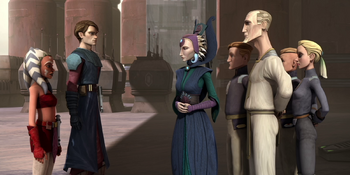
Away from the Republic's war, the Jedi Anakin Skywalker and Ahsoka Tano worked with the leaders and people of Mandalore.
Duchess Satine Kryze argued for the Mandalorian people's right to self-determination against a Senate bill that would commit the Republic Military to "save" Mandalore.[151] Although she managed to maintain Mandalore's neutrality from the Clone Wars, supply pressures encouraged corruption within the Mandalorian government and citizens turned to the black market, including for tea that had been improperly diluted and turned toxic. Prime Minister Almec's government council refused to seek Republic help as they believed the Republic was more corrupt, so the Duchess and Senator Amidala privately appealed to the Jedi for help.[73] Padawan Ahsoka Tano was assigned to Mandalore to investigate corruption undercover, ostensibly to teach at the Royal Academy of Government. Tano spoke of citizens' "duty" to scrutinize their leaders to encourage honesty and maintain accountable governance, inspiring a group of cadets led by Korkie Kryze to secretly infiltrate a food supply warehouse. They uncovered the Prime Minister's involvement in the black market conspiracy, leading to his arrest.[24]
Afterward, Senator Bail Organa hosted a conference on Alderaan on the swelling numbers of refugees due to displacement by warfare. Padmé Amidala argued that the Senate should enact legislation to protect refugee rights as well as ensure that clone soldiers would have a sense of their own futures beyond the war. Amidala also advocated for opening diplomatic avenues to discuss an end to the war, stating that some in the Confederacy likewise desired peace while agents of chaos were everywhere and declaring that she would be steadfast in defending truth and democracy. Although another assassination attempt was made on Amidala's life, she was saved by Ahsoka Tano.[148]
When the Trade Federation blockaded Pantora following the election of Baron Notluwiski Papanoida as its Chairman, Senator Lott Dod of the Trade Federation refuted Pantoran Senator Riyo Chuchi's accusation that the corporation was aligned with the Confederacy of Independent Systems. Dod insisted in the Senate that his corporation was neutral and the Pantorans had outstanding debts, but Amidala and Tano privately supported Chuchi's efforts to resist the hostile expansion of the Separatist sphere of influence. Count Dooku promised aid for Pantora should it join his Separatist Alliance while bounty hunters abducted Baron Papanoida's daughters, Che Amanwe and Chi Eekway. The chairman surmised that the "wheels of democracy" were turning too slowly for his people, whose views soured on a seemingly unsympathetic Republic Senate and popular sentiment pivoted toward joining the Separatists. However, instead of accepting Dooku's offer, he took upon himself to investigate his daughters' captors while Chuchi and Tano inspected the Trade Federation blockade, uncovering the commerce giant's conspiracy. Although the Trade Federation lifted the blockade, Lott Dod was able to insist that the corporation was not associated with the Separatists, denouncing the supervising officer Sib Canay and arguing that Canay was influenced by Nute Gunray.[112]
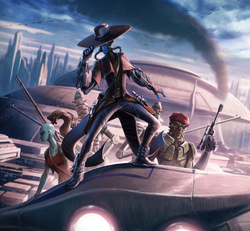
At the heart of the Republic, the Senate was sullied by a team of bounty hunters hired by the Hutt Clan.
Later in 21 BBY,[25] the Senate was debating the Enhanced Privacy Invasion Bill, which proposed allowing the Chancellor to spy on Republic citizens suspected of being a Separatist,[152] when a group of senators in opposition were taken hostage inside the Senate Office Building by Cad Bane. Leading other bounty hunters, Bane was hired by the Hutt Clan to demand the release of Ziro the Hutt,[153] who, if left in Republic custody, would be able to reveal the Grand Hutt Council's many crimes to the Senate via a holodiary only he knew the location of.[154] While Ziro was set free and the Gran Senator Philo was killed, the other hostage senators survived, among them Padmé Amidala, Riyo Chuchi, Bail Organa, Onaconda Farr, and Kin Robb.[153] Meanwhile, Bane and his crew escaped into the Coruscant underworld, distracting a pursuing force of Jedi by shooting the engines out of a nearby transport. In the end, Bane and his company were able to escape with Ziro,[155] who was returned to the Hutt capital of Nal Hutta.[154]
Mon Calamari and Quarrens; Gungans and the Naboo[]
- "Rish Loo manipulated mesa head-thoughts with lies and misinformation. He's the real enemy."
- ―Boss Lyonie, on Naboo
The Quarren Tikkes's election as Senator of Mon Cala was approved by the Mon Calamari government council, but he joined the Separatists and gained a seat on the Executive Separatist Council when the war began,[95] representing the Free Dac Volunteers Engineering Corps and Pammant Docks, which produced Separatist capital ships.[156] Other Separatist corporate leaders likewise supplied their starships and forces to the Confederacy military. Tikkes was replaced in the Republic Senate by the Quarren Tundra Dowmeia, who shared representation of Mon Cala with the Mon Calamari Senator Meena Tills.[152]

Both the Mon Calamari and Quarren peoples recognized Lee-Char as their king following a civil war stoked by the Separatists.
In 20 BBY,[25] civil war erupted between the Quarren and Mon Calamari peoples on their shared homeworld after the Separatist-backed Quarren Isolation League of Chieftain Nossor Ri rebelled against the Mon Calamari monarchy, which had governed along with representatives of both species. The Mon Calamari Senator Meena Tills appointed Gial Ackbar the personal protector of Prince Lee-Char, heir to the throne, and appealed to the Jedi and the Republic for help, receiving additional Gungan reinforcements from Naboo. Meanwhile, the Quarren were supported and had been pushed into the war by Separatist ambassador Riff Tamson,[157] who had been promised control over Mon Cala by Count Dooku should the Confederacy win the battle.[158] For all the deception his plans relied on, however, Tamson himself was a legitimate believer in the Confederate cause, which he saw as the best way to uplift his fellow Karkarodons.[159] After they discovered that Dooku had promised Tamson control of their world, the Quarrens agreed to restore the monarchy under the Mon Calamari King Lee-Char.[158] All the same, Tikkes remained loyal to the Confederacy and maintained his seat on the Separatist Council.[160]
Dooku focused on conquering Naboo, which was experiencing civil unrest as the Gungans' city experienced power shortage. With Dooku promising the Gungan minister Rish Loo that he would play a key part in the "new order" of a Separatist-occupied Naboo, Rish Loo manipulated the popular Boss Lyonie using sorcery. Lyonie recounted that Rish Loo fed him "lies and misinformation" to stoke discontent against the human Naboo, blaming them for all the troubles of Gungan society. The Gungan Grand Army embraced Lyonie's rhetoric and was ready to march on the city of Theed, where Queen Neeyutnee asked Senator Padmé Amidala and Jedi General Anakin Skywalker to find a diplomatic solution. The latter pair spoke with Representative Jar Jar Binks and General Roos Tarpals—a veteran of the battle against the Trade Federation and a firm believer in the friendship between the Gungans and the Naboo—broke Rish Loo's influence on Lyonie, and convinced the Gungan boss to tell the Gungan army to stand down.[123]
However, General Grievous' Separatist Droid Army had been invited to march alongside the Gungans, forcing Representative Binks to masquerade as Boss Lyonie to stall the attack. The Gungans deactivated the droid army and Tarpals sacrificed himself to capture Grievous, yet Darth Sidious, needing the general for his war plans, exploited Senator Amidala's relationship with Skywalker and ordered Dooku to capture the Jedi for a prisoner exchange. Despite believing that Grievous' capture would win the war, Amidala agreed to the exchange with the support of Binks, Boss Lyonie, and Queen Neeyutnee.[123]
Droid tales[]
- "Congratulations! You are now a democracy!"
- ―C-3PO, to the Patitites
The Aleena people on the planet Aleen maintained a pastoral way of life organized by faith and families, which formed tahiko kinship groups. Tahikos were represented by their eldest member in a planet-wide collective of advisors who elected the largely ceremonial King of Aleen, typically a priest. The Aleena had little contact with the wider galaxy to maintain peace with the Underworld, home to the Kindalo people, following a destructive and technologically advanced war between them millennia before the Clone Wars. The notional Kindalo government was a system of anarchical consensus, never taking action on a societal level unless every Kindalo agreed. The Kindalo therefore had only a handful of absolute laws, one of which was the compact that they shared with the Aleena: the separation of the two peoples, enforced by the Great Seal,[26] which the Republic droids C-3PO and R2-D2 helped reseal when it was disturbed[162] later in 20 BBY.[25]

C-3PO introduced democracy to the Patitites after shoving R2-D2 onto their dictator.
C-3PO and R2-D2, who respectively assisted Senator Amidala and her Jedi husband, Anakin Skywalker,[25] then stumbled upon the planet Patitite Pattuna, where they accidentally and literally stumbled upon the dictator "Big" Hay-Zu; the potentate of the petite Patitite people was killed when C-3PO knocked over R2-D2 for making an uncivil remark and the falling R2-D2 crushed the "big" dictator. When the Patitites requested C-3PO to stay as their new leader, the droid instead suggested that they find someone among their own. C-3PO asked them to nominate three of the most intelligent, understanding, and compassionate individuals and then asked the remaining people to shout their support for the three nominees in turn. The crowd was unable to decide the winner and began scuffling, at which point C-3PO decided to leave them to build their "happy democracy" on their own.[161]
Mounting frustrations[]
- "One shudders to think where the galaxy would be without the Jedi."
- ―Supreme Chancellor Palpatine, to Jedi Anakin Skywalker and Obi-Wan Kenobi
A peace conference between Republic and Separatist politicians was chaired by Duchess Satine Kryze[164] in 20 BBY.[25] It was attended by Senators Amidala, Organa, and Mothma of the Republic and the Separatist Parliament's speaker, Bec Lawise, and members Voe Atell and Amita Fonti[164]—the latter two were corporate-allied politicians who had little interest in peace,[113] and the talks indeed collapsed: the Separatists arrested Lux Bonteri for accusing Dooku of assassinating his mother, the late Senator Mina Bonteri, when barging into the meeting, and the Jedi Ahsoka Tano and R2-D2 battled the Separatist-allied Death Watch Mandalorians to rescue him.[164]

Onderonians fought for their own freedom from the Separatists, though the Republic and the Jedi were slow to provide support.
Lux Bonteri later helped persuade Jedi and clone forces to secretly train insurgents led by Steela and Saw Gerrera in their "armed struggle" against the Separatist-allied monarchy of Sanjay Rash on Onderon. Rash and his Separatist masters had deposed Ramsis Dendup as king, whom they tried to publicly execute after he emphasized that dissent was the "will of the people." After Steela and many other rebels had been made martyrs in skirmishes, Onderon militias repelled the Separatists with additional firepower supplied by Hondo Ohnaka and his pirates, courtesy of a deal with Anakin Skywalker—who was frustrated with the Jedi Order's refusal to partake in the civil war—thus allowing the restored king to assert Onderon's freedom and appoint Bonteri Onderon's representative to the Republic Senate.[165]
Later in 20 BBY,[25] Count Dooku organized a bounty hunter plot to kidnap Supreme Chancellor Palpatine during a public address on Naboo.[163] The Jedi High Council had Obi-Wan Kenobi fake his own death to infiltrate the bounty hunters, and the Jedi kept their counter-operation secret from both the Republic[88] and the wider Jedi Order, including Anakin Skywalker.[166] After the Jedi foiled the kidnapping attempt, Skywalker privately confessed his frustration with Kenobi and the council's lack of trust in him to the Chancellor when they were ambushed by Dooku. Having successfully distracted the rest of the Jedi security detail, the Sith Lord overwhelmed Skywalker and nearly captured Palpatine when Kenobi intervened.[163]
Darth Sidious viewed Asajj Ventress and the witches of Dathomir as a threat to his plans. After forcing his apprentice to abandon Ventress as the Separatists withdrew from Sullust,[167] which was home to the Commerce Guild's SoroSuub Corporation,[12] Sidious tasked General Grievous with the massacre on Dathomir, which was outside the Republic and beyond its protection.[168] During the war, the Republic also established a Population Observation program that surveyed public opinions on various aspects of the conflict, which revealed increasing anti-Jedi sentiment.[4] While the Jedi Order had been thrusted into warfare, some Jedi insisted on remaining true to their traditions whereas others were willing to explore more extreme methods.[113] Jedi General Pong Krell had become disdainful of clone lives and the Republic, and after sending scores of men to their deaths at the Battle of Umbara[169] in 20 BBY,[25] he was relieved of service and killed by clone troopers.[169]
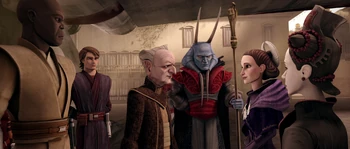
Palpatine increasingly exploited the Jedi Order's vulnerabilities, particularly Anakin Skywalker's vulnerabilities.
Jedi Knight Barriss Offee was critical of the Order's involvement in the war and bombed the Jedi Temple[170] in 19 BBY,[25] killing fellow Jedi and also clone troopers and civilians to make her point. A number of Coruscanti accused the Jedi of corruption and lambasted their government's "cloning violence" during anti-war protests held in front of the Jedi Temple.[170] The Jedi were deliberately omitted from the Republic's wartime propaganda, and on the Separatist side, the mysterious Jedi were also branded as hypocrites—self-styled "guardians of peace" who gladly led "slaves bred for war."[17]
During the investigation into the bombing, Offee framed Ahsoka Tano for her own terrorism, and the Jedi Council expelled Tano from the Order so that she may be trialed by the Republic Military. Chancellor Palpatine oversaw the proceedings as Adjutant General Tarkin pressed for Tano's prosecution while the jury was comprised of senators. Among them were Riyo Chuchi, Mon Mothma, Bail Organa, Mot-Not Rab, and Kin Robb, while Senator Padmé Amidala spoke in Tano's defense. The court case nearly came to a close in favor of Tano's prosecution when Anakin Skywalker presented Offee, whom he had captured following an aggressive confrontation, and she admitted the truth of her actions, vocally condemning the Jedi as being responsible for the Clone Wars while denouncing the Republic, claiming that the democratic union was failing. Although the Jedi Council agreed to invite Tano back into the Order as a Jedi Knight, she decided to refuse and instead find her own path.[170]
Unrestricted power[]
- "In hope of a better tomorrow, we cede control of the banks to the Office of the Chancellor of the Galactic Republic."
- ―Banking Clan representative Nix Card
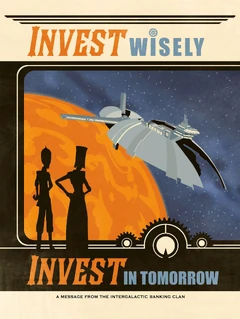
Invest Wisely poster, promoted by the IGBC to encourage more business with the bank.
Later in 19 BBY,[25] the Banking Clan continued funding both sides of the war, and its Core Five leaders were convincted of embezzlement by the Muun government, which appointed Rush Clovis at the agreement of both the Republic, whose diplomatic service delegation at the Banking Clan headquarters on Scipio was led by Senator Padmé Amidala, and the Separatists, whose delegation was represented by Bec Lawise. When Count Dooku secretly threatened Clovis that the Separatists would default on their Banking Clan loans, Clovis raised interest rates on the Republic. Senators Kin Robb, Meena Tills, and Mot-Not Rab expressed outrage at the bank that was amplified when Chancellor Palpatine confirmed that the Separatists did not experience a similar hike in rates.[19]
The Republic delegation was then ambushed by Separatist forces, which arrested Senator Amidala upon Dooku's order. When Bec Lawise protested, claiming that the Separatist Parliament would never approve of the arrest, Dooku personally redirected Amidala's blaster to fire upon Lawise before abandoning Scipio. Given the support of senators alarmed by the news of the Separatist takeover of the banks, Chancellor Palpatine authorized a Republic invasion of Scipio, forcing the bank to cede its assets to the Office of the Chancellor.[19]
Stirrings in the Force[]
- "Remember… you always have a choice to be better. You always have a choice to… to pick the right path. Even if that choice comes a little late."
- ―Asajj Ventress, to Quinlan Vos
In the same year,[25] Queen Julia appealed to the Senate—specifically Jar Jar Binks—for help when members of her ruling Bahk-tov Council began to disappear.[171] Although the council was led by the monarch whom it elected, policy decisions could only be made via an unanimous vote of the council, which included members of the pacifist Dagoyan Order.[26] The Dagoyan Masters were abducted by the militant Frangawl Cult, but they were defeated by Jedi Master Mace Windu, who had been dispatched as Representative Binks' partner. Queen Julia thus proposed a new era of more friendly relations between the Dagoyan and Jedi Orders.[172]
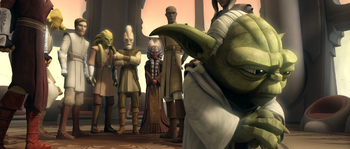
Already troubled by eroded public faith, the Jedi Order struggled to comprehend the Sith plot behind the clone army, protracted conflict, and centralization of the Republic.
Already bogged by three years of warfare, the Jedi Council was shocked by Dooku's public genocide on Mahranee and sent Master Quinlan Vos to secretly assassinate Dooku. Vos teamed up with Dooku's ex-pupil Asajj Ventress, fell in love with her, and, despite Ventress' warnings, succumbed to the singular mission of targeting Dooku—he fell to the dark side and became a deadly Separatist admiral. The Jedi Council realized that the plan was a grave strategic and moral mistake, particularly as Ventress continued making personal sacrifices to save Vos and persuaded him to choose the light. Vos did discover that Dooku himself was the Sith apprentice of Darth Sidious, the name of the Sith Lord whom Dooku claimed was controlling the Republic at the start of the war.[145] Late in the third year of the war,[113] Obi-Wan Kenobi and Anakin Skywalker further discovered that Dooku was the very same "Lord Tyranus"[173] who had hired Jango Fett to be the clone troopers' template and worked with Sifo-Dyas—the Jedi Master who had placed the order for a clone army on behalf of the Republic with the Kaminoans without the Senate's authorization.[1]
Embarking on a spiritual quest where he learned about the Living Force's relationship with the Cosmic Force, Grand Master Yoda accepted that he had a dark side, as with every Jedi. Yoda believed that the Jedi's collective ignorance of their own darkness had already cost them victory in the war, yet he resolved to commit to the light—and nearly uncovered Darth Sidious' identity.[174] The Sith Lord therefore rushed to implement his Grand Plan against the Jedi by instigating the Battle of Coruscant.[113] Separatist forces led by General Grievous kidnapped the Supreme Chancellor from Coruscant, prompting the Jedi Council to recall Kenobi and Skywalker from the Outer Rim Sieges. The act foiled an attempt by Sidious' ex-apprentice, Maul, to lure Skywalker to the war-torn world of Mandalore and caused Maul—who knew of the Grand Plan—to send his Shadow Collective criminal empire into hiding.[175] Against Jedi ethics, Anakin Skywalker executed Dooku at Palpatine's command at the battle, furthering his fall to the dark side.[160]

Do Not Bind His Hands poster praising Palpatine's procuring of power.
Although previous peace initiatives had failed, Padmé Amidala was a part of the Delegation of 2,000,[176] Senatorial representatives including Meena Tills, Tundra Dowmeia, Mon Mothma,[152] Fang Zar of Sern sector worlds including Ghorman,[177] Chi Eekway Papanoida in Riyo Chuchi's stead,[176] and Terr Taneel of the Senex sector—who gathered at Bail Organa's Cantham House office.[178] The Sector Governance Decree—an amendment to the Galactic Constitution of sending governors to coordinate the Republic war effort by procuring any production facilities in their assigned sectors[156]—was passed late into the third year of the conflict and served as the catalyst for the delegation, who planned to present their petition to Chancellor Palpatine to let go of his emergency powers once they had reached 2000 signatures.[113] As the Outer Rim Sieges cornered the Separatists, the delegation wanted Palpatine to revoke his Sector Governance Decree and start ceasefire talks.[178]
Dictatorship and tyranny[]
Fall of the Jedi[]
- "This war represents a failure to listen. Now you're closer to the chancellor than anyone. Please, ask him to stop the fighting and let diplomacy resume!"
- ―Senator Padmé Amidala, to Anakin Skywalker

The Jedi Council was concerned that the dark side clouded their foresight and questioned Palpatine's powers in the final days of the war.
Upon Dooku's demise, the Jedi Masters believed that the war would end once General Grievous was captured. The Jedi also wanted Palpatine to step down, given that his term limit had expired long ago and the Senate was due to vote on whether to grant the Chancellor even more emergency powers. Nevertheless, the council focused on the Outer Rim Sieges pursuing the Separatists—at the suggestion of Master Ki-Adi-Mundi, Yoda was diverted to defend the Wookiees on Kashyyyk.[160] Yoda was burdened by his premonition that an era was at an end throughout the war,[106] but before he left Coruscant, the Grand Master gave counsel to Anakin Skywalker. The Jedi war hero had been dreaming about his secret lover, Padmé Amidala, dying at childbirth, and Yoda asserted that the young man must let go of everything he feared losing.[160]
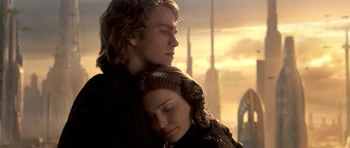
Skywalker was not in the mood for political discussion with Senator Amidala, instead focusing on his fear that she would die at childbirth.
Skywalker discussed his worry that the Jedi Order was breaking the principles of the Republic due to the war with Amidala. The senator replied with her concern that the Republic was becoming the "evil" they had been "fighting to destroy." She was questioning if the democracy that thought they were serving no longer existed and thought that the war represented a "failure to listen," pleading Skywalker to use his closeness with Palpatine to call for a return to diplomacy. Skywalker compared her concerns to the Separatists but also admitted that he was irritated—not least by his nightmares, which reminded him of his visions of his mother dying.[160]
Skywalker promised Amidala that he would not let her die and also spoke with Palpatine, who appointed the troubled Jedi as his representative to the Jedi High Council, which in turn troubled the Jedi Masters given that they had elected their own members and were concerned about Skywalker's friendship with Palpatine. The council did allow Skywalker to join—but without the rank of Jedi Master, and, off-record, the masters further tasked Skywalker to spy on the Chancellor. Although Skywalker believed that it was treason against the Jedi Code, the Republic, and Palpatine as his longtime mentor and friend, Obi-Wan Kenobi emphasised that they were at war and that the Jedi's allegiance was to the Senate, rather than to its leader.[160]
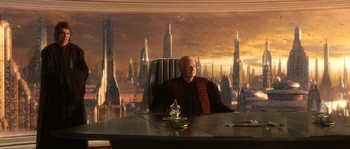
Skywalker's friendship with the Chancellor and their strained relations with the Jedi Council reinforced the young man's belief that both Palpatine and himself deserved more powers to finish the war.
Darth Sidious contacted General Grievous on Utapau and ordered him to send the Separatist Council to the hellish world of Mustafar. The Sith Lord then met Skywalker again, telling him that Grievous was on Utapau and expressing his wish for the young Jedi to lead the battle against the general. Skywalker was glad to hear that he had the Chancellor's confidence and discussed the Jedi Council's spying assignment with Palpatine, who suggested that the masters did not trust the young man and were plotting to take over the Republic. Skywalker concurred that he felt the Jedi Council was disrespecting the Republic's democracy, but he argued that the Jedi were selfless and therefore very different from the Sith who only thought about themselves. The canny politician thus moved on to indicating his knowledge about Sith arcana, catching Skywalker's intrigue with a story about Darth Plagueis' study of the power to create life and prevent death.[160]
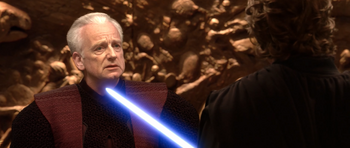
Skywalker wanted to kill the Chancellor upon his revelation that he was the Sith Lord, but he decided to relay the news to the Jedi Council instead.
When Skywalker relayed Grievous' whereabouts to the Jedi Council, the masters voted in agreement with Ki-Adi-Mundi's proposal to send Kenobi to Utapau instead. Upon the news that Kenobi was fighting Grievous, Mace Windu sent Skywalker to determine whether Palpatine would lay down his powers upon the general's defeat. Ki-Adi-Mundi stated that the Chancellor must lay down his powers, and Windu said that he sensed the shroud of the dark side surrounding the Chancellor himself, suggesting that the Jedi Council might be forced to "take control of the Senate to ensure a peaceful transition" of power. However, Grand Master Yoda warned that such a line of thought could take them down a "dark place." Plagued by the thought that other Jedi were withholding him from gaining a power he deemed necessary to "save" Padmé Amidala, Skywalker was seduced by the Chancellor, who revealed that he indeed was the remaining Dark Lord of the Sith, Darth Sidious, who had orchestrated the Clone Wars.[160]
Revenge of the Sith[]
- "Emperor Palpatine rose to power because he made people afraid. He made people fear the Jedi. He called them traitors. He said they used their mystical powers to subvert democracy and peace, to cause war. It worked, possibly because as much as people loved the Jedi, they also hated them, on some level. It is hard to look at people who have become their best selves. It reminds you that you have not. The Jedi Order was an enemy of the Empire and needed to be purged—not just from reality, but from thought. From memory."
- ―Madelin Sun, on the fall of the Jedi
Angered by the revelation, Skywalker initially wanted to kill the Sith Lord but refrained from doing so. The Chancellor concurred that Skywalker must do his duty as a Jedi to report to the Jedi Council. As Mace Windu learned from Skywalker that Palpatine was Darth Sidious, the Jedi Master sensed Skywalker's emotional confusion and ordered him to remain in the Jedi Temple. Windu and several other council members then went to the Chancellor's office with the expectation of arresting the statesman. Invoking the name of the Republic Senate, they demanded that the Chancellor relinquish his executive powers over to the Senate and let the legislative body decide his fate. However, Darth Sidious retorted that he personally was "the Senate" and attacked the Jedi within the confines of his office. The Sith Lord proved a formidable opponent until Windu deprived him of his lightsaber.[160]
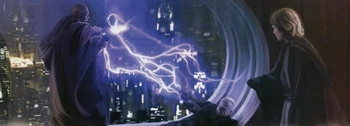
In his fear and greed, Anakin Skywalker chose darkness—power to the Sith.
The Jedi Master was ready to kill Sidious when Skywalker, frustrated by the Jedi's distrust and anxious about the fate of his wife, barged into the office. Skywalker's request that the Chancellor stand trial was dismissed by Windu, who reasoned that the Sith Lord had control of the Senate and the courts and must be eliminated to prevent the return of the "oppression of the Sith." Skywalker was ultimately lured by Sidious' promise of power and intervened in favor of the Sith, who killed Windu instead. Skywalker surrendered to the Dark Lord, who appointed him as his new Sith apprentice under the name Darth Vader.[160]
Vader's first assignment was to massacre the Jedi, including younglings, in Coruscant's Jedi Temple. The Chancellor then ordered the Republic army to destroy the Jedi Order and summoned the Republic's representatives for a special session of Congress. Addressing the Senate Rotunda, Darth Sidious was applauded as he announced the quelling of "the Jedi rebellion"—the man was visibly scarred by the Jedi attack and donned a red[160] Sith robe that showed a portion of his disfigured face[152] as he dropped the voice and mannerism of a kindly senator and declared all Jedi as traitors of the Republic. He then proclaimed the reorganization of the Republic[160] into the fascist Galactic Empire.[180]
A New Order[]
- "So this is how liberty dies—with thunderous applause."
- ―Senator Padmé Amidala
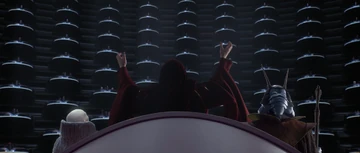
After turning Skywalker against the Jedi, Palpatine declared himself Emperor, casting away democracy and freedom and appealing to senators' desires for peace and security.
The vast majority of clone troopers heeded Palpatine's command and enacted the genocide of the Jedi Order, compelled by the programmed chips in their heads, with some justifying their murders through the words "good soldiers follow orders."[181] With the peoples of the galaxy weary of war[17] and many hoping for peace no matter the cost[2] after untold billions had died,[182] Palpatine's proclamation was gladly welcomed by many Senate representatives[160] and the wider galaxy.[176] As Amidala sadly noted in the Senate Chamber, democracy died with a thunderous round of applause. Her husband later went to Mustafar, where he executed the Separatist Council and ensured the immediate shutdown of the Separatist Droid Army at the new Emperor's behest.[160] In the Empire's telling of events, the Jedi had been puppeteering the Separatist Alliance[183] and created the war as part of a plan to supplant[179] and overthrow the Republic.[160] Other Imperial narratives, however, would paint the CIS and Jedi as separate.[184][23] Nonetheless, the public knowledge that Dooku had once been a Jedi helped to sell the idea that the Order in its entirety could have been composed of traitors.[17]
The war was over, and democratic principles were effectively rolled back on the galactic level with Palpatine's personal dictatorship.[180] The Jedi Purge suppressed the possibility of a Jedi rebellion against the New Order—though among the handful of survivors were Yoda and Obi-Wan Kenobi, who received help from Senator Organa. Kenobi joined Padmé Amidala as she confronted her husband on Mustafar. The Jedi Master affirmed that he was loyal to the Republic and to democracy, but Vader had been corrupted by his new master's temptation of power and believed the Jedi were in the wrong—he claimed that he had created his own "new empire" of "peace, freedom, justice, and security." Vader even boasted to his wife that he could overthrow Palpatine so that they may rule the galaxy together, but she rejected the offer, realizing that her husband had indeed led the attack on the Jedi Temple and subverted democracy. Vader was defeated in a duel with Kenobi, but he survived to become the Emperor's primary enforcer, clad in fearsome armor; Amidala lost her will to live, but not before she gave birth to the twins Luke and Leia.[160]
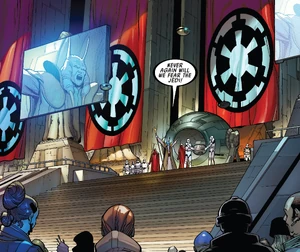
Marred by warfare, the galaxy of the Empire celebrated the end to the conflict and to the Jedi.
The self-anointed Emperor ushered in an era of rule by draconian laws,[2] terror, and oppression,[29] installing an authoritarian military state that was largely controlled by the Imperial Starfleet and armies. He appointed Governor-Generals and Moffs—sector governors who commanded planetary governors and were accountable only to the Imperial executive of high-ranking bureaucrats and the Emperor himself, rather than the war-weary citizens.[2] Grand Vizier Mas Amedda led a celebration of "freedom" from the Jedi "Separatist plots" on assassinating Palpatine, and the Emperor converted the Jedi Temple into his own Imperial Palace.[183] People who remembered the Jedi and were unwilling to die for their beliefs remained silent, becoming afraid and apathetic.[179]
Liberty's lament[]
- "It is my duty to act in your best interest and it is why I can no longer condone this unjust occupation. They wish to intimidate us, to scare us, but we shall not cower at their acts of oppression."
- ―Avi Singh, condemning the Imperial occupation of Raxus Secundus
While the Emperor allowed the existence of an Imperial Senate,[186] sixty-three senators who had been members of the Delegation of 2,000 were arrested and charged with treason on the day after the Empire's founding. Senators Mon Mothma and Bail Organa were released, but they found the new Senate disempowered.[178]
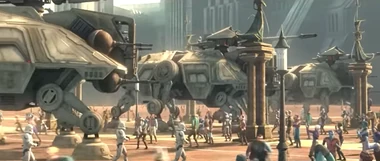
The Empire betrayed its promises and quelled opposition with brutal force, imposing a dictatorship over the ashes of democracy.
The Empire began occupying the former Separatist capital world, Raxus Secundus, early in its reign. Ex-Senator Avi Singh addressed a disgruntled crowd in Raxulon plaza square against the Imperial presence imposing itself without the people's consent, but Imperial tanks forcibly cleared the square.[185] Moff Tarkin was remembered on the Colonies planet Ghorman for forcefully landing his cruiser in Palmo Plaza, massacring hundreds of unarmed demonstrators,[187] and he also oversaw indiscriminate mass arrests and massacre on the former Separatist world Antar 4. Although the Empire censored news reports, the media dubbed it the Antar Atrocity, and Emperor Palpatine distanced himself from the controversy by removing Tarkin from the Gotal homeworld. Tarkin was then assigned to the military campaign in the Western Reaches to eliminate remaining Separatist holdouts. However, the Antar Atrocity also prompted the former Republic Intelligence captain Berch Teller to wage an insurgency against the New Order.[8]
The Empire rescinded generations-old statutes protecting Legacy worlds from resource-exploitation to strip-mine doonium and dolovite ores for the battle station over Geonosis. Aside from withholding media reports and stationing the relevant scientists across various other worlds—including Dr. Erso at the newly evicted B'ankor Refuge on Coruscant, who was convinced by Krennic that they were working for renewable energy solutions for worlds in need—authorities ensured the project's secrecy by framing companies with limited mining rights to Legacy worlds in the Western Reaches for illegal arms-trading. When Krennic placed Moff Tarkin in the framing of Zerpen Industries in the autonomous star system Salient, near other autonomous systems of the Corporate Sector, the confrontation escalated into open warfare that roused the Imperial Senate. The conflict drew in Krennic's former smuggler Has Obitt, who had been moved by his crew's reactions to the Empire's ecocide of appropriated worlds, and the insurgent Saw Gerrera, whose homeworld of Onderon had been lost to the Empire's control, as well as supporters from other autonomous systems. Tarkin was nevertheless determined to make a harsh example of the Salient system to set the precedent, particularly for governments in the Corporate Sector, that the Empire could revoke autonomy at its pleasure.[92]
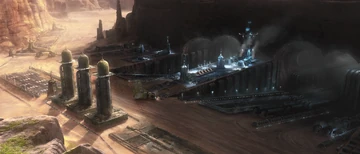
The Empire took resources off its worlds without restraint.
Where the Empire applied oppressive force, acts of resistance increased too.[25] Even planets that had been allied with the Republic during the war were militarily occupied by the Empire against the will of their populations, setting the cause for localized armed resistance movements.[188] After helping Has Obitt extricate the Erso family from Coruscant,[92] Saw Gerrera eventually led his Partisans in battling the Imperial occupation of Kashyyyk, where the Wookiees were enslaved as laborers.[188] In 18 BBY,[25] the farmers who welcomed the former Jedi Ahsoka Tano on the moon Raada mounted a spontaneous but ill-fated uprising, though the survivors were rescued by Bail Organa's secret resistance movement, which Tano joined under the codename "Fulcrum."[189]
Cham Syndulla formed the Free Ryloth Movement as Imperial forces reneged on the Republic's promise to leave their homeworld and exploited its natural resources instead. Senator Orn Free Taa was booed when he told his people to support the Empire in a speech in Lessu, and Cham Syndulla followed by asking his followers to lay down their arms, which received some cheers. However, freedom fighters Gobi Glie and Serin, along with Cham's daughter, Hera, procured weapons from the defected "Bad Batch" clone squad, wary of a new Imperial doonium refinery. The Twi'leks were arrested and deemed guilty of treason without trial by the Empire, forcing Cham and Eleni Syndulla to rescue their daughter.[190] Although Ryloth was designated a "free and independent" protectorate by the Empire, the Syndullas waged an insurgency against the occupation, which also exploited the planet for its wealth in spices.[191]
Replacing the Clone Army[]

The Senate was shown the military attack on Kamino before the Emperor persuaded it to approve the transition from a clone army to a stormtrooper army.
Around the same time, upon Admiral Tarkin's instruction, Vice Admiral Edmon Rampart's Imperial forces destroyed the Kamino cloning facilities. When the Senate debated the Imperial Defense Recruitment Bill thereafter, Rampart explained that the bill would allow the Imperial Military to replace the aging clone trooper veterans inherited from the Republic with soldiers enlisted from Imperial populations. Senator Gani Riduli of the Banking Clan and the Commerce Guild representative backed the bill. Speaking in opposition were Senators Riyo Chuchi, Bail Organa, and Tynnra Pamlo—the latter represented Taris and criticized the bill as a plan to unnecessarily build a new military, and they successfully forced the bill to be postponed for multiple debate sessions.[192] The Kaminoan senator Halle Burtoni had been removed from office after learning that Rampart was embezzling funds on the Defense Finance Committee for his stormtrooper program, and she attempted to live a quiet life on Coruscant after criticizing Kaminoan Prime Minister Lama Su for arrogantly believing that the Empire needed their people's cloning services.[193]
Senator Chuchi persuaded Burtoni to testify before the Senate about Rampart's misuse of government funding and—with the help of the Bad Batch and the Clone Underground movement, whose fellow clones were refused representation in the Senate and were fugitives from Imperial service themselves—publicly uncovered evidence of Rampart's fleet attacking Kamino. However, Emperor Palpatine, who had been absent from most Senate sessions and let Grand Vizier Amedda preside alone, personally appeared in the Senate Chamber. He claimed that Rampart had acted without authorization and convinced the Imperial Senate to pass the bill into law, heralding the age of the Imperial stormtrooper.[193] Military service recruits trained in the new Imperial Academies, which appealed to young people who wanted to travel off-world or otherwise felt a lack of control over their own lives, especially in the Outer Rim.[17]

The science of medicine was exploited by Imperial experiments on cloned soldiers, unrestrained by the democratic ideals that ended with the war.
Shortly afterward, Dr. Royce Hemlock, whose invasive procedures had violated the democratic ideals of the Republic, headed the Imperial Advanced Science Division and worked on unwilling clone subjects for the Emperor's secret biological experiments[194] as part of the Imperial cloning program, which also included the Zillo Beast, and Project Necromancer. After the Bad Batch scuppered Hemlock's facility, Governor Wilhuff Tarkin redirected the relevant funds to Project Stardust.[195] Emperor Palpatine promoted Tarkin to Grand Moff after he defeated the Berch Teller insurgency, which had been disrupting supply stations to Geonosis.[8] A separate insurgency led by "Nightswan" monitored and sabotaged shipments of doonium, iridium, and other minerals across the Empire, and in the course of countering the insurgency, Mitth'raw'nuruodo—an exile from the Unknown Regions' Chiss Ascendancy who joined the Galactic Empire under the name "Thrawn"—ascended its ranks as a talented naval officer. During his investigation, Commodore Thrawn discovered that the Empire was transporting enslaved Wookiees and discussed Nightswan's intentions, including the rebel's belief that the Empire was gathering material for a secret project.[196]
A populist peace[]
- "Palpatine is a populist. The reason he appeals to worlds like Troithe is because people there see him making real changes in their lives. He cracked down on the corporations. He ended the war. He's promising that the era of out-of-touch politicians and twelfth-generation nobility shaping the galaxy for their own benefit is over."
"He's—"
"What you're doing is only proving him right." - ―Lud Marroi and Mon Mothma, who cut herself off from arguing the point

Strength & Obedience poster glorifying the Empire's military prowess.
While day-to-day life proved difficult for the average citizen, government propaganda created a narrative that anyone could become successful: Senator Daho Sejan proclaimed that the Empire was built on prosperity and security, blaming ongoing issues on alleged dissidents and terrorists hiding among the population, and he called on "loyal" citizens to report the alleged foes among them. Sejan promised that such loyalists would have new opportunities in life as the regime expanded across the stars.[197] The Emperor was popular on the ecumenopolis Troithe, which was suffering a slow industrial decline by the time of the Clone Wars.[34] Senator Lud Marroi of Troithe told Mon Mothma that Palpatine was an appealing populist who made tangible changes felt by citizens; he was seen to have cracked down on corporations, ended the war, and promised to end the influence of out-of-touch politicians and nepotistic nobility. However, Mothma recognized that power was simply shifting to Palpatine and his cronies instead of to the people.[23]
Mothma also identified the Empire as a kleptocracy.[23] Arsin Crassus and other financiers channeled Separatist accounts to the Empire.[13] The regime either absorbed the corporate groups that had backed the Separatist Alliance[22] or permitted them to continue, so long as they pledged themselves to the new government.[23] The heavily industrialized former Separatist worlds were a boon to the Empire, which nationalized the means of production as part of Imperialization and brought substantial weapons equipment into the fold of the Imperial Military.[4] The InterGalactic Banking Clan feigned loyalty to the Empire, which was blockading their headquarters of Scipio; the corporation secretly funded armed resistance against Imperial rule[198] and was embroiled in violent trade wars against the Hutt Clan for access to smuggling routes.[199] The new regime took advantage of the Outer Rim hyperlanes that the Republic had secured with the Hutt Cartel during the war, expanding without due regard to the sovereignty of neutral and independent star systems.[4]
Brutalist base[]
- "Need I remind the honorable members that Palpatine maintained the illusion of the Imperial Senate for nearly twenty years after the Old Republic's fall? A tyrant can make anything seem to be 'the will of the people.'"
- ―Senator Leia Organa, reflecting on the Empire's history in the New Republic Senate

The Empire put to use Corellia's industrial capacity for new Star Destroyers at the expense of the world's workers and environment.
The Imperial Senate continued to operate on Coruscant with increased culpability for the regime's schemes.[4] During the investiture of senators, the Oathkeeper led the Senate Chamber in a collective oath-taking that pledged "full allegiance" to the Empire.[200] Oppositional figures such as Bail Organa and Mon Mothma were allowed to remain through the existing local electoral processes, but senators were monitored by government authorities, and support for benevolent campaigns were warped by advisors and governors to the effect of furthering Imperial oppression and staining senators' reputations: the Senate's provision of "accomodation and food" for Wobani resulted in the Mid Rim planet becoming a prisoner and labor camp, and an employment bill for the Core World Corellia was twisted into turning the[4] civilian[140] Corellian shipyards into an offshoot of Kuat Drive Yards that made Star Destroyers.[4]
Consequently, Corellia's upper atmosphere was heavily polluted[4] and the bay squids of Ugyir River became extinct,[201] with the White Worms criminal gang roaming the streets between factories co-owned by Sienar Fleet Systems and the Santhe Corporation. By 10 BBY, Imperial forces were locked in trench warfare with the Mimbanese Liberation Army who resisted the Empire's reneging on the Republic's promise of freedom[131] and instead exploiting Mimban for hyperbaride.[132] At the same time, the Cloud-Riders were rebellious marauders led by Enfys Nest who waged war on both the Empire and the Five Crime Syndicates, holding them responsible for atrocities.[131]
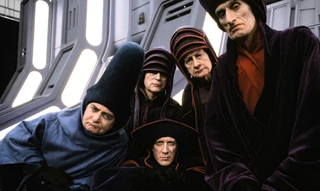
The Emperor used opaque systems of bureaucracy to manage the Empire's many regions.
The Imperial Palace, the Imperial Inspectorate HQ that replaced the Republic Center for Military Operations, and the arcology complex—the latter housing the newly founded Commission for the Preservation of the New Order (COMPNOR), including the ISB Central Office, and the Ubiqtorate of Imperial Intelligence—formed the "supreme triangle" of the Federal District.[8] Coruscant's skyline was increasingly dominated by Palpatine's favored brutalist aesthetic over the sweeping lines of Republic architecture around the Senate,[140] which received additional pressure from the executive. Imperial High Command requested the Senate to revoke the Unknown Alien protocols, which required all contact with undiscovered sentient species to be investigated on behalf of the legislative body, and rumors that the Emperor was working to revoke the protocols circulated within the military.[196]
The Imperial Starfleet earned a fearsome reputation following its orbital bombardment of the ex-Separatist world Haruun Kal, which put down the local insurrection.[202] While the military and loyal administrators' powers increased, senators' decisiveness and willingness to vote and debate decreased, reflected in declining Senate attendance and reinforcing the Senate's reputation as useless whereas governors could seemingly act without the constraint of politics. However, the Imperial leadership recognized the Senate's residual power: Emperor Palpatine allowed some legislation that hindered his plans to pass despite maintaining a veto, and Imperial Naval Regulation 132.CAT.ch(22) restricted ships from firing on escape pods in response to Senate investigations of possible war crimes.[4]
Imperialist ignorance[]
- "We made the story. We shaped it. We blew it up. We decided when it was over. With the right ideas planted in the right markets, in the right sequence, we can now weaponize this galactic opinion."
- ―Dee Shambo of the Empire's Ministry of Enlightenment
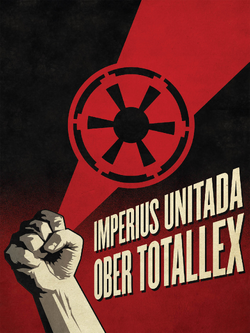
Imperius Unitada ober Totallex
The scholar Madelin Sun observed that the Emperor rose to power by making people afraid of the Jedi—citizens accepted their elected leader's claim that the Jedi, who had powers beyond most people's understanding, were subverters of democracy and peace—and the Empire went on to eliminate memories of the Jedi.[179] History was rewritten. Alternative Republic and Separatist views of the Clone Wars were suppressed and relevant records, including any mention of the Jed, were censored.[4] While older Imperials remembered the Jedi's alleged coup on Palpatine, Imperial teachings dismissed the Jedi as a marginal cult and emphasised the Emperor's promise of uprooting the corruption and inefficiencies endemic in the Republic, restraining local governments and corporate powers alike and reducing petty crime rates.[28]
COMPNOR was formed from the Commission for the Protection of the Republic populist propaganda movement and tasked with glorifying the ideals of the New Order, enshrined in the Imperial Charter. Shortly after its drafting, the Empire's Imperius Unitada ober Totallex poster promoted the ideology of "Empire united over all" using brutalist and fascist imagery including a human fist, as the New Order promoted xenophobia against non-human "aliens" as well. Post-Imperial historians criticized the twilight years of the Republic for being an era of distractions, with citizens embracing template escapist tales of heroes versus villains when attention should have been focused on corruption in governing institutions such as the Senate. COMPNOR's Sub-Adult Group served as a non-military alternative for young people who did not enlist in the Imperial Academies, training them as loyal administrators for the Imperial bureaucracy.[17]
Rebellions are built on hope[]
Nothing can come of nothing[]
- "When do we start fighting back?"
"We have."
"By walking away?"
"We fight to win. That means we lose. And lose and lose and lose…until we're ready." - ―Kleya and Luthen
When the Empire was newly founded, Padmé Amidala's handmaiden Saché had joined Naboo's legislative assembly due to her heroism during the Trade Federation invasion of Naboo and been a favorite to be elected to succeed Sio Bibble as the world's governor, yet democracy was subverted as Quarsh Panaka was installed as the Moff of Emperor Palpatine's homeworld.[6] Under Imperial rule, Gungan people were systematically evicted and detained and fled to their underwater cities.[26] During an Imperial Army deployment elsewhere, mudtroopers were ordered to round up and execute any people they found. Among the soldiers was Sergeant Lear, who deserted the army after rescuing a girl from the scene whom he named "Kleya" while he took on the name "Luthen." Whereas the Empire's victims were arbitrary and actions indiscriminate, the man taught Kleya that their hatred and acts of resistance ought to be used effectively. At times, he treated the girl as his daughter.[204]
On Naboo, Luthen told Kleya to enjoy her desert to keep in mind what they stood to lose and asked if she was sure she wanted to commit to the fight; he told her she had to accept what she was leaving behind and refrained from letting her set off the explosives that he had planted by an Imperial convoy on a bridge.[204] Wullf Yularen, who heroically served Anakin Skywalker during the Clone Wars,[25] became a leading member of the Imperial Security Bureau (ISB), which took on law enforcement powers from local agencies such as Tanivos Divo's Coruscant Security Force; Divo retired during the Imperial Era, and his daughter, Andressa Divo, became a Security Bureau agent who supported the government's increasingly extreme law enforcement tactics.[88]

Governor Tarkin oversaw notorious brutalities that were meant to democratize fear.
While the Empire quelled localized insurgencies, the regime's brutalities encouraged greater rebellion across star systems.[2] Grand Moff Tarkin oversaw the Invasion of Mon Cala alongside Darth Vader and the Inquisitors—former Jedi pupils who were corrupted by the dark side and inducted into the Empire. The Jedi Ferren Barr thought that announcing to the wider galaxy that Palpatine's enforcers were former Jedi could have undermined the new regime in its infancy, but he believed it was too late given the Emperor's successful lies. Instead, Barr wanted to dramatize the more readily understood concepts of oppression and freedom by provoking the Empire's aggression on Mon Cala into war, believing that it would stir the people of the galaxy into resistance. King Lee-Char heeded Barr's prophecy that the Mon Calamari would be at the center of the struggle for liberty and mobilized Raddus and Gial Ackbar's forces, but the Imperial war machine quickly conquered Mon Cala.[205] Consequently, Raddus led an exodus of city-ships into space, and the fleet eventually became a backbone of an interstellar rebel movement.[140]
When Lasan resisted the Empire, it invaded the world in 7 BBY[4] and nearly wiped out the Lasat people using T-7 ion disruptor rifles. The Imperial Senate banned the use of T-7s,[206] which were recalled and destroyed—Senator Tynnra Pamlo personally saw evidence of the atrocity,[140] though Alexsandr Kallus, who had ordered the disruptors to be used against the Lasat, continued as an ISB agent with the authority to override civilian and military orders and commandeer military forces, including Star Destroyers. He was later deployed to the Outer Rim agriworld Lothal, where a family of rebels named the Spectres had stationed themselves[207] after raiding Imperial supply ships on Ryloth, Christophsis, Kashyyyk, and Toydaria.[208]
From the brave, the bold, the battered[]
- "The Senate increasingly resembles a rigged casino. Given that Palpatine always wins the political games, it seems pointless to play unless you can also secure your own prizes at the same time."
- ―Senator Daho Sejan, who was later executed for treason

The Spectres (foreground) opposed the Imperial takeover of Lothal, which shuttered the world's Old Republic Senate (background).
Lothal had been governed from the Senate Building of the planet's capital until the Imperial occupation. A growing government bureaucracy at the Imperial Complex under Governor Arihnda Pryce supplanted Governor Ryder Azadi and the Lothal Senate.[26] Having been appointed by Grand Moff Tarkin to her role,[196] Pryce funneled her world's mineral resources to the Empire's new industrial factories that manufactured military equipment.[26] Although the Empire initially compensated farmers who were displaced by the mining with new homes and jobs for positive stories, the authorities eventually took land by force and threat of imprisonment, forcing Lothalites to shantytowns such as Lothal re-settlement camp 43, a slum nicknamed Tarkintown after the Grand Moff.[209]
The planet Devaron in the Colonies region continued as a representative democracy, with the sparsely populated world's economy supported by remittances from off-world Devaronians—mostly men. Women dominated the Devaronian government and other leadership roles, including in businesses and the Senate, though the rule of law continued to enshrine gender equality. The people of Devaron were unhappy with the appointment of a human Imperial governor and tacitly approved a significant number of Devaronians to join the Rebellion, prompting the Empire to interfere in Devaronian remittances.[26] Tholoth was also a democratic planet in the Colonies, being led by a head executive chair and a legislative senate in a governmental structure similar to that of the Republic's, but it was methodically Imperialized and its cosmopolitan culture of many species, architecture, and languages was stripped of elements that the Empire deemed foreign to the Tholothian species, becoming a mere resort for Imperial officers.[15]
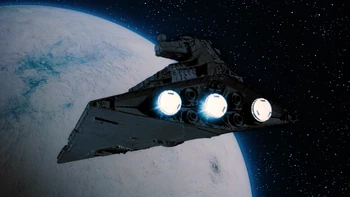
The Empire had significant pools of resources to blockade and occupy entire worlds.
The Expansion Region planet Iktotch was also a representative democracy. Instead of installing an Imperial governor, the Empire simply imposed a blockade as the Iktotchi people were largely isolationist, informed by their cautious foresight of Imperial tyranny.[26] Elsewhere in the region, the Empire sought to recruit warriors from Thisspias, where Imperial propaganda insisted on the Republic's decadence. The Thisspiasians resisted the Empire, whose governor deposed the Blood Monarch only to provoke more insurrection, with royalists and monarchical abolitionists working together against the Imperial occupation.[15] The Imperial occupation of Castell led by the "Burning Moff" Ssaria was brutal and provoked Papa Toren, a crime lord who lost a trinket to Ssaria's plundering.[210]
The semi-nomadic Vurk people of Sembla in the Outer Rim had a complex system of personal governance and political participation that was often dismissed and underestimated as primitive. Vurks addressed interpersonal disagreements by trying potential compromises to solve the issue, escalating to the community level and becoming casual rules of behavior. Vurks who disagreed migrated to other Vurk communities and were judged by their reputations, which in turn prompted new discussions on mores and consent, always questioning ethical and moral issues to better understand them. Imperials exploited the Vurks as a cheap labor force, and Vurks on other parts of Sembla were sometimes slow to unite against the Empire due to their culture of witnessing and discussing issues on a case-by-case basis.[15]
Upping the ante[]
- "Remember that the frontier of the Rebellion is everywhere. And even the smallest act of insurrection pushes our lines forward."
- ―Karis Nemik's manifesto

Democracy was not merely a memory but a hope for Mon Mothma, who continued speaking out for democratic principles in the Imperial Senate until she founded the Rebel Alliance.
In 5 BBY, Senator Mon Mothma worked with Luthen Rael and Kleya Marki's Axis network and redirected funding for the nascent rebellion. Unable to continue drawing money from her family accounts, Mothma asked her Chandrilan banker friend Tay Kolma to chair a new "charity" programme. When the oligarch Davo Sculdun found that Mothma had disappeared 400,000 credits, he pressured the senator to arrange for her thirteen-year-old daughter, Leida Mothma, to marry his son, in exchange for keeping her funds secure.[211] Axis' massive heist on Aldhani brought the rebellion 80 million credits, and the Empire introduced the Imperial Emergency Act and the Public Order Resentencing Directive (PORD), which would boost Imperial Military and Security Bureau powers to facilitate harsh crackdowns on any act deemed criminal. Senator Mothma decried the directive as a "march towards complete unchallenged authority," which the Senate debated before passing the legislation.[212]
Among the rebels who took part in the Aldhani heist were Cassian Andor and Karis Nemik. The latter appreciated that Andor joined the crew as a mercenary, and he wrote a manifesto, The Trail of Political Consciousness, which advocated freedom as a "pure" idea that emerged spontaneously against the Empire's fragile tyranny, denouncing it as "the mask of fear."[29] Although Andor enjoyed a holiday on Niamos to prevent detection by Imperial authorities, the Empire's reach caught up to the man.[213] A shoretrooper who wanted to exploit the power he held over civilians[214] arrested Andor on a popular beach because he kept "looking around" and "sweating" as though he had been running. The local courthouse sentenced Andor to six years of prison labor for various spurious charges including "civil disruption," "anti-Imperial speech," "fleeing the scene of anti-Imperial activity," and "attempted damage to Imperial property."[213]
Do you hear the people sing?[]
- "The Empire is a disease that thrives in darkness. It is never more alive than when we sleep. It's easy for the dead to tell you to fight, and maybe it's true, maybe fighting is useless. Perhaps it's too late. But I'll tell you this… If I could do it again, I'd wake up early and be fighting these bastards… from the start. Fight the Empire!"
- ―Maarva Andor
Andor was incarcerated at the Narkina 5 Imperial Prison Complex, where prisoners were increasingly brutalized by guards given the passing of PORD while being forced to construct modular parts[213]—they contributed to the highly secretive Project Stardust.[29] Andor and his fellow inmates realized that prisoners who had completed the sentence were not released but simply moved around to another level of the facility. They organized a revolt in which floor manager Kino Loy encouraged the people to help each other while they escaped.[211] Cassian Andor fled the Empire's unjust criminal justice system only to learn that his mother Maarva Carassi Andor, a prominent figure of civil society on his homeworld Ferrix, had passed away.[213]

Citizens (right) fight for freedom against Imperial oppression.
Andor returned home for the funeral, which the Imperial authorities allowed to go ahead, having recently installed a direct military occupation after replacing the Preox-Morlana corporation's civil control of Ferrix's star system. At the procession, Ferrixians listened to Maarva's recorded speech in which she encouraged her people to fight the "disease" perpetuated by the Imperial "bastards." The strength of feeling for Maarva and the community's freedom was such that the citizens were inspired to spontaneously attack the surrounding Imperial armed forces. Cassian himself decided to join the Axis network, undermining the Empire.[29]
Luthen Rael also worked with Saw Gerrera even though he considered the Partisan leader an anarchist borne of desperation, while Gerrera dismissed various rebel groupings as "separatist" or "neo-republican"[215] and criticised Mothma for being passive.[216] In 4 BBY, Ferrixians were settling as "toolies" living in a mobil-haus and working the farms of Mina-Rau when the agriworld was subject to an sudden Imperial inspection. The Imperials checked for visas and arrested undocumented migrants, and Lieutenant Krole abused his position to intimidate and sexually assault residents, spurring a deadly skirmish in which Bix Caleen and Wilmon Paak fled with Cassian Andor to join the rebellion.[217]
A new generation[]
- "Some individuals have decided that—that the worlds of this galaxy need a defense other than the Empire—a defense against the Empire—"
"An uprising. About time!"
"Don't be so happy about it. Do you realize what that would mean? For us, for the whole galaxy?"
"Yes, I do. It's still time." - ―Leia Organa and Amilyn Holdo

Future senator Leia Organa used her privilege as a princess to run mercy missions that also shored up the rebel movement.
By the time the Princess of Alderaan, Leia Organa, joined the Empire's Apprentice Legislature in 4 BBY, only forty worlds bothered sending junior representatives to the program given the declining influence of the Senate, but Princess Leia found allies such as Harp Allor of Chandrila and Amilyn Holdo of Gatalenta. The princess had been working as her father's aide in the Senate and learnt from her mother, Queen Breha Organa,[184] who not only raised her but taught other young people such as Evaan Verlaine as Alderaan's Minister of Education.[218] The young legislator discovered her parents' underground democracy movement when she found Bail Organa's rebel base on Crait. She committed to humanitarian diplomacy, including a visit to Naboo's moon of Onoam to deliver safety equipment to striking Onoam miners. The miners told Leia Organa that they could not accept her safety equipment as their Imperial overseers would simply take them to sell for personal profit. Organa met with Moff Panaka and Queen Dalné to discuss the issue, and Panaka was assassinated by Saw Gerrera's Partisans immediately afterward. Organa was surprised but hoped that Dalné could serve as Naboo's true queen for a few days or weeks while the Empire attempted to re-establish authority.[184]
The assassination of Panaka was a source of division between Gerrera and various power players of the burgeoning rebel movement, including Bail Organa, who hoped that the Moff might have been open to working alongside them in the future and believed that the Partisans needed to be corralled. After finding that Empire had forcibly displacement of Arreyel's entire population to build factories and collectively punished Chasmeene by poisoning the planet's farmland, Princess Leia entrusted the information with Senator Mon Mothma, her future mentor. Leia later personally evacuated a rebel base alongside Amilyn Holdo and eventually decided to join her parents' anti-Imperial alliance.[184] She personally delivered three Hammerhead corvettes to Imperial-occupied Lothal under the guise of transporting relief aid. The corvettes were instead "stolen" by the local rebels to bolster Phoenix Cell.[219]
Lighting the spark[]
- "All I sense is evil. Why would they burn Tarkintown?"
"To spread fear, make us afraid. The people that lived here just got caught in the middle."
"This happened because of us?"
"There's a cost for any action we take now, Ezra." - ―Ezra Bridger and Kanan Jarrus
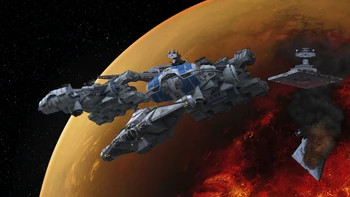
Rebel action over Mustafar killed the Grand Inquisitor and humiliated Grand Moff Tarkin but also attracted Darth Vader's personal attention.
The Spectres' harrying of Imperial forces and supplies to Lothalites in the capital and Tarkintown caught the attention of Agent Kallus.[221] When the Spectres planned to broadcast a call to rebellion on Lothal, their Jedi leader, Kanan Jarrus, was captured by Grand Moff Tarkin and the Grand Inquisitor. Nevertheless, Jarrus' pupil, Ezra Bridger, made his own broadcast that inspired people on Lothal and in the surrounding systems to resist the Empire.[222] The Spectres then infiltrated Tarkin's Star Destroyer over Mustafar—where Jarrus had been interrogated for information about the rebellion and the informant known as "Fulcrum"[223]—they destroyed the Grand Moff's flagship and rescued Jarrus with the help of Phoenix Cell. The Grand Inquisitor let himself die rather than suffer for his failures,[224] and the defeat embarassed Tarkin.[225]
Although the action at Mustafar marked one of the earliest rebel victories in the Galactic Civil War against the Empire,[223] it prompted Emperor Palpatine to send Darth Vader to handle the Lothal crisis,[224] with the Empire tightening control over the planet beginning with the torching of Tarkintown,[220] and Mon Mothma was cautious that her and Bail Organa's rebel network had revealed their sector fleet's naval capacity to Imperial authorities.[178] A military lockdown of Lothal was subsequently enforced by Grand Admiral Thrawn and his Seventh Fleet at Governor Pryce's request, the two Imperials having previously worked together to defeat Nightswan.[196] The Spectre and local Lothalite Jedi learner Ezra Bridger vowed to protect his loved ones from the Empire, and he received advice from Yoda not to fixate on fighting to win the war but to think about choosing how to win.[106]
Today Ghorman, tomorrow—[]
- "The death of truth is the ultimate victory of evil […] what happened yesterday on Ghorman was unprovoked genocide! Yes! Genocide! And that truth has been exiled from this chamber! And the monster screaming the loudest? The monster we've helped create? The monster who will come for us all soon enough is Emperor Palpatine!"
- ―Senator Mon Mothma, addressing the Imperial Senate
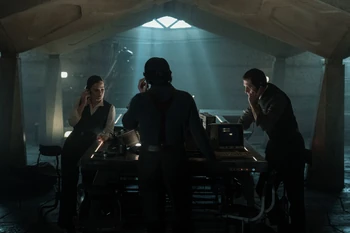
The Ghorman Front grew increasingly impatient to resist the Empire as Imperial oppression grew increasingly brazen.
As the Ghorman Front resisted the Imperial regime in 5 BBY,[227] Imperial Ruling Council officials Sly Moore and Ars Dangor cut off the shipping lanes to Ghorman, which Senator Mothma believed face starvation.[228] She backed fellow Senator Dhow in proposing to send a fact-finding mission to "prove" that the Ghorman people were simply "requesting their basic rights" but received scant attention from her colleagues, who had called for Imperial decree to handle the situation.[227] In 4 BBY, Director Krennic of an "energy project"[203]—Project Stardust[140]—enlisted select officers to secure Ghorman for the mineral kalkite, necessary for coating reaction lenses, at the cost of destabilizing the planet core. The Ministry of Enlightenment's propaganda "weaponized" galactic opinion against the Ghor while the Empire built an armory in the city of Palmo,[203] prompting protests against the over-shadowing of the Monument to the Fallen, which commemorated the Tarkin Massacre of fifteen years ago.[187]
ISB Supervisor Dedra Meero oversaw Imperial efforts to secretly incite increasingly violent Ghorman resistance as pretext for a crackdown that would allow the Empire to mine kalkite. To that end, Meero's partner, the bureaucrat Syril Karn, was posted on Ghorman to work with the Ghorman Front. The front received help from the Palmo city councillor Carro Rylanz, despite his customary calls for peaceful resistance, and the Axis network.[200] As curfews were imposed on Ghorman, Imperial journalists reported headily on "insurgents" and "terrorists" against "Imperial norms" while Ghorman rebels suffered from disunity over whether to adopt more violent forms of resistance—during an argument, Lezine stressed that they must not let their collective identity as Ghor to be corrupted by the Empire.[229] When Mon Mothma tried to convince fellow senators to back her legislative efforts against the PORD in 3 BBY, even Senator Dasi Oran of Ghorman refused to support her, citing his world's vulnerability as a single export economy—requiring the import of everything beside the twill that made Ghorman prosperous—to further restrictions that could be imposed in retaliation by Imperial authorities.[187]
In 2 BBY,[229] General Jan Dodonna's Massassi Group had set up base in a hidden fortress on the Outer Rim moon Yavin 4,[140] with a growing community of rebels[230] including General Davits Draven, Captain Cassian Andor, Bix Caleen, Wilmon Paak, Vel Sartha,[229] and Ruescott Melshi.[226] Andor's clarity of feeling inspired a healer[229] at the base who had faith in the Force and comforted rebel troops and pilots.[230] Based on intelligence from Hondo Ohnaka, the Spectres stole five Y-wings from the Empire's Reklam Station salvage yard and gave them to Dodonna's Gold Squadron.[231]
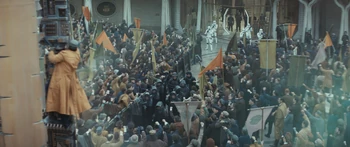
Protesters gathered in Palmo Plaza, unaware of the carnage that was to come.
The Empire committed the Ghorman Massacre in that year.[25] Rumors of Imperial mining rigs landing in the Ghorman countryside spread to Palmo and barricades were set up in the city's plaza, inviting Ghorman civilians—a few armed with blasters, with one distributing flame jars and another breaking up the ground for chunks of throwable debris, but mostly unarmed—to rally there after calling for a general strike. Inexperienced Imperial security troopers from off-world were then sent from Palmo Plaza's Imperial office complex in riot gear to push through the crowd to reach the central monument. When Supervisor Meero was confronted by Syril Karn regarding the Empire's true intentions with Ghorman, she rebutted that he had taken his promotions gladly and attempted to justify her involvement by claiming that it had been developed for years without them. She was nevertheless responsible for relaying the order from Coruscant to proceed: before the riot troops could reach the monument, a hidden Imperial sniper shot one of them, and the panicked troops fired their blasters at the protesters. As the Ghor retaliated, stormtroopers encircling the plaza began firing upon them as well, followed by KX-series security droids that cleared the plaza by chasing down and tossing demonstrators, killing many. The massacre then spilled into the surrounding streets. Surviving rebels desperately broadcasted raw accounts of the atrocity on open channels.[232] Thousands were slaughtered.[4]

A reflection of the Imperial Senate Building on Coruscant on the night of the Ghorman Massacre
Imperial state media portrayed the event as a failed uprising and hailed the fallen Imperial personnel as heroes who died for peace and security. Senator Oran was soon arrested without charge by stormtroopers before other senators in the Senate Building.[226] The massacre was the last straw for Mon Mothma.[140] She agreed with Bail Organa that while he would brave staying in the Imperial Senate, she would publicly denounce the massacre as genocide and then lead the rebels on Yavin 4. During the next day's session of the Imperial Senate, which the Oathkeeper convened early and only called senators loyal to the regime to speak, several representatives commemorated Imperial "martyrs" who died on Ghorman. When Senior Senator Erveen was called, she yielded her time to Senior Senator Organa to make a Point of Order, invoking Article 17-252 from the Emperor's Council to yield in turn to Senior Senator Mothma. She made a speech denouncing the Ghorman Massacre and the distortion of truth within the Senate—Emperor Palpatine was the "monster" who would destroy them all. Mothma was then extracted from the Senate by the Axis network, including Cassian Andor. Although Andor wanted to leave the Rebellion to live with his lover Bix Caleen, she let him go, leaving him on Yavin 4 so that he may dedicate himself to the rebel cause.[226]
Fire across the galaxy[]
- "I've been called a traitor for speaking out against a corrupt Galactic Senate, a Senate manipulated by the sinister tactics of the Emperor. For too long, I've watched the heavy hand of the Empire strangle our liberties, stifling our freedoms in the name of ensuring our safety. No longer. Despite Imperial threats, despite the Emperor himself, I have no fear as I take new action. For I am not alone. Beginning today, we stand together as allies. I hereby resign from the Senate to fight for you. Not from the distant halls of politics, but from the front lines. We will not rest until we bring an end to the Empire, until we restore our Republic. Are you with me?"
- ―Mon Mothma, assembling the Rebel Alliance
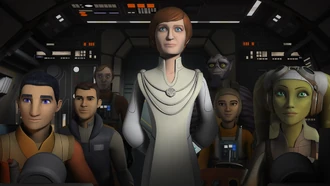
Mon Mothma formally founded the Rebellion in a broadcast from the Ghost after fleeing from Coruscant in the aftermath of the Ghorman Massacre.
Branded a traitor and pursued by Thrawn's Seventh Fleet and TIE Defender prototype, Mon Mothma fled Coruscant with her aide Erskin Semaj. They were escorted by Gold Squadron and the Spectres with their home ship, the Ghost, to the planet Dantooine. Mothma then announced her resignation from the Senate in a speech broadcast on the HoloNet, expressing her belief that she had exhausted all avenues of defending people's rights and freedoms from within the Senate. She accused Emperor Palpatine for ordering the attack on the Ghormans and called on the people of the galaxy to join her in battle against the "tyranny" of the Imperial regime and "restore our Republic." Disparate rebel groups heeded her call and formally formed the Alliance to Restore the Republic,[233] aiming to restore galactic democracy.[234] Mothma encouraged debate and disagreement in the cabinet of the Alliance Civil Government, which partook in Alliance High Command meetings alongside military leaders on Yavin 4.[140]
The movement was beset with rifts, particularly with Saw Gerrera and his Partisans.[178] The Empire's Tanivos Divo classed Gerrera as a "terrorist" who violated the Alderaan Convention against torturing prisoners.[88] When Saw Gerrera and the Spectres confirmed that the Empire had committed genocide on the Geonosians, the rebels recovered images of the poison canisters used. Bail Organa thought that the Senate would not be convinced but the evidence could rally more star systems to the rebel cause,[235] and Agent Kallus had begun to sympathize with the rebel cause following a run-in over Geonosis with the Spectres' Lasat member, Garazeb Orrelios,[236] a year prior.[25] The Alliance later severed ties with Gerrera's group for their brutal tactics and targeting of civilians, which Mothma deemed to violate the principles of the Ruusan Armistice and were unjustified even under a state of war.[178] Nevertheless, Gerrera later pressed members of the Spectres to help him investigate an Imperial shipment of a giant kyber crystal, with the rebels freeing technicians who suggested that the cargo came from the Jedha system.[216]
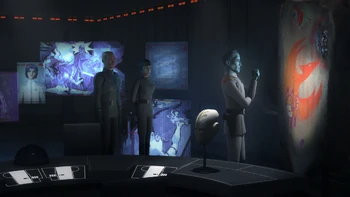
Thrawn studied artwork associated with the Spectres to guage their motives and vulnerabilities.
Before Phoenix Cell's base on Atollon was destroyed by Thrawn's fleet[237] in 2 BBY,[25] which necessitated the survivors' retreat to Yavin 4,[237] the Spectres had helped the Rebellion procure a prototype "blockade buster" starfighter designed by the master engineer Quarrie[178] in 4 BBY.[25] Quarrie later joined the crew of Admiral Ackbar's rebel flagship, the star cruiser Home One, alongside the Freemakers family of mechanics.[238] Based on the prototype, Senator Bail Organa persuaded Slayn & Korpil to manufacture the powerful B-wing starfighter for the rebel cause.[178] Princess Leia was elected as Alderaan's senator after her father stepped down, becoming the legislature's youngest member while continuing her humanitarian efforts.[239]
In 1 BBY,[25] the Spectres joined their member Sabine Wren's efforts to defend her people on Imperial-occupied Mandalore.[240] Wren noted that the popularity of Mandalorian cubism and its murals of ancient Mandalorian crusaders killing Jedi resurfaced during the Clone Wars, and she disapproved of how the imagery had been used to promote violence despite being initially intended to condemn war.[241] As both a rebel and a Mandalorian of Clan Wren, Wren defended her family, helped depose Imperial Viceroy Gar Saxon and his brother Tiber Saxon, and, alongside Lady Bo-Katan Kryze, destroyed the anti-Mandalorian weapon that Wren herself had developed during her time at the Imperial Academy.[240]
The Rebel Alliance then sanctioned General Hera Syndulla of the Spectres to lead an Attack on Lothal to destroy Thrawn's TIE Defender program, but the rebels were defeated. With Director Krennic lobbying for more funding to be diverted to Project Stardust, Grand Admiral Thrawn left Lothal to persuade the Emperor on Coruscant to maintain funding for his TIE Defender program. Meanwhile, the Spectres persisted in battling the occupation forces led by Governor Pryce on their homeworld, which compromised the TIE program.[242] The Emperor personally tried to lure Ezra Bridger to help him breach into the mystical World Between Worlds and Thrawn returned to take charge of Lothal, but the rebels successfully liberated the planet in a final battle in which Thrawn was exiled to parts unknown.[243]
Revolutions are built on love[]
Looking up to Stardust[]
- "You can stand to see the Imperial flag reign across the galaxy?"
"It's not a problem if you don't look up." - ―Saw Gerrera and Jyn Erso
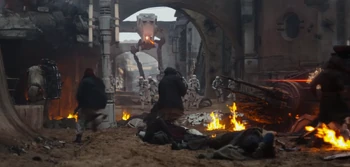
Saw Gerrera's Partisans battled Imperial forces in Jedha City.
Around the same year,[25] the Empire took direct control of HoloNet News, but its outgoing editor-in-chief asked the reporter Calliope Drouth to secretly help the growing rebel movement via the recording droid Zox. At the Imperial Ball, Drouth learnt from Krennic's subordinates of the Empire's interest in crystals on Jedha, which the reporter relayed via hand signals.[245] Indeed, the Mid Rim moon Jedha was a pilgrims' holy site from which the Empire extracted kyber crystals amidst an insurgency by Saw Gerrera. The Partisans attacked shipments of kyber, which were transported to the Outer Rim planet Eadu for refinement at Dr. Galen Erso's laboratory.[140] Against the urging of Alliance High Command to stop escalating,[246] Gerrera's rebel cell turned the Holy City into a warzone, which orphaned increasingly more children. Realizing that the Empire was willing to bear hundreds of stormtrooper casualties and lost kyber shipments, two Guardians of the Whills who had supported the insurgency—Chirrut Îmwe and Baze Malbus—led a march of orphans to the shuttle that the Partisans had planned to use as a bomb for the Star Destroyer that had newly parked over the city, forcing the rebels to abandon the plot.[247]
In her obsession with hunting Axis, Dedra Meero had been collating information about Imperial activities, including Ghorman kalkite, Jedha kyber, and Dr. Galen Erso in relation to a top-secret project. Lonni Jung, Luthen Rael's spy in the ISB who had been wanting to keep his wife and daughter safe, discovered the project in Meero's files and revealed the information to Rael in the Imperial capital in 1 BBY. Although the ISB tried to stop the leak and finally foiled Rael's front, Kleya Marki ensured she honored her mentor and their rebellious cause. She prevented the Empire from learning more about their network,[204] passed on the information to Cassian Andor, and reached Yavin 4 to join the wider Rebellion alive herself. Assembling short of their required quorum for an agreement, Alliance High Command was initially reluctant to believe Captain Andor's claims when he relayed the information, but he was allowed to meet with Tivik, his contact with Saw Gerrera's group.[246] Tivik confirmed that the Empire was building a "planet killer" based on a message sent by Dr. Erso.[244]
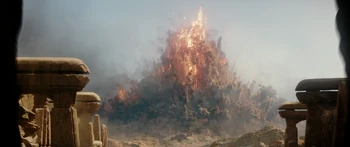
The Empire's weapon of terror was unleashed on Jedha City; among the last reports to the Senate was a "mining accident" on Jedha.
Nineteen years after the Empire's founding, the regime completed its crowning weapon of terror—the Death Star. After undermining Director Krennic's position for Project Stardust's delays and its spate of information leaks, Grand Moff Tarkin tasked the superweapon with test-firing upon Jedha City, killing the Holy City's residents and pilgrims and shattering the moon. The blast forced the Partisans stationed near the city to evacuate with their Cavern Angels squadron, and Saw Gerrera perished in the blast, but not before he received Dr. Erso's message, addressed to his "stardust"—his daughter, Jyn Erso. Living in the hope of helping her and the galaxy, Galen had planted a secret weakpoint in the Death Star. Working with Cassian Andor, Jyn decided to help the Rebellion. Although the Alliance had confirmation of the Empire's "ultimate weapon," the Imperial Senate was told that Jedha City was destroyed in a mining accident to prevent defections. Alliance High Command agreed to send Captain Andor and Jyn to capture Galen for a Senate hearing to expose the Empire's secret, but Galen was killed in action.[244]
The rebel leadership subsequently failed to agree on whether the Alliance should infiltrate the Imperial research installation on Scarif to secure the Death Star plans directly. Jyn Erso reframed the debate on "what chance" the Rebellion had to "what choice" they had,[244] but senators such as Tynnra Pamlo of Taris refused to let the rebels escalate the war against the Empire out of fear for their people. After arguing with Mon Mothma, Senator Pamlo traveled to Coruscant to publicly decry the Death Star, resign her office, and urge the Rebellion to disband.[140] Nevertheless, Erso's intervention had inspired a group of volunteer rebels to infiltrate Scarif in defiance of High Command. Led by Erso and Cassian Andor, they left Yavin 4 under the code name Rogue One. They were later supported by Admiral Raddus' Alliance Fleet, beginning open warfare against the Empire. While Director Krennic led a frantic defense of Scarif's base, Grand Moff Tarkin took charge of the Death Star to destroy the base and its entire vicinity of rebels and Imperials. All of Rogue One died in action, as did much of Raddus' fleet, but the plans were successfully transferred to the diplomatic cruiser of Senator Leia Organa as it fled the scene of battle.[244] Later, a rebel propaganda holovid featuring Jyn Erso prompted Chass na Chadic to fly with the Cavern Angels and eventually join the Rebel Alliance, and the rebel hero's sacrifice remained a lasting inspiration for the pilot.[28]
Crucible[]
- "The more you tighten your grip, Tarkin, the more star systems will slip through your fingers."
- ―Princess Leia Organa, aboard the Death Star

The Emperor dispensed entirely with the guise of democracy and formally instituted direct rule by regional governors.
Despite Senator Organa's legal protection as a diplomat, Darth Vader traced and attacked her cruiser and captured her for interrogation after realizing that the battle station plans had been sent to Tatooine. When Imperial officer Daine Jir warned Vader that news of Leia Organa's detainment could "generate sympathy for the Rebellion in the Senate," the Sith Lord ordered that her ship be filed as accidentally destroyed. Meanwhile, the astromech R2-D2, accompanied by C-3PO, endured the Tatooine heat and enslavement by local Jawa scavengers[248] to continue Rogue One's mission, carrying the galaxy's hope in the form of the Death Star plans.[244] R2-D2 convinced R5-D4 to help the Rebellion by helping him be sold to local farmers,[249] and the rebel astromech, joined by the farmboy Luke Skywalker, delivered Leia's plea from her father Bail to Obi-Wan Kenobi for the Jedi to help the Rebellion.[248]
Soon afterward,[248] Emperor Palpatine formally dissolved the Imperial Senate and transferred direct control of Imperial space to his regional governors.[180] Grand Moff Tarkin declared the Senate's dissolution as the removal of the last remnant of the Republic when the Joint Chiefs of the Imperial Military met aboard the Death Star, which included leaders such as Chief Cassio Tagge of the Imperial Army, Colonel Yularen of the ISB, and Darth Vader.[248] The Empire had become a stratocracy[140] under the Tarkin Doctrine of military governorship[8] ruling by fear.[176] Tagge was shocked by the news of the Senate's dissolution, believing that the legislature, though troublesome, involved bureaucratic hurdles that were necessary to deter dissent.[250]
Bail and Leia Organa had been monitored by Andressa Divo and the ISB, which found evidence of the Alderaanians' links to the Rebellion.[88] With Princess Leia detained aboard the new battle station as a rebel, Tarkin demonstrated its full firepower on Alderaan,[248] where billions of beings—including Bail and Breha Organa[251] and Tanivos Divo[88]—were killed as the world exploded. Tarkin believed that a galaxy-wide fear of the Death Star would silence any dissent.[248]

Guided by figures of the past and leaders of their own making, a younger generation arose to stop Imperial tyranny and restore the Republic.
When Princess Leia escaped with the help of Obi-Wan Kenobi and his crew to Yavin 4, the station pursued them, and rebel pilots prepared a daring assault on the Death Star based on their stolen schematics.[248] Mon Mothma decided to travel to Coruscant to surrender to the Empire in the event of Yavin 4's annihilation, willing to publicly disavow the Alliance and her life's work in the hope of sparing other worlds from incuring the Empire's wrath.[251] Instead, at the Battle of Yavin, the Death Star was destroyed by rebel pilot Luke Skywalker with the Force as his ally.[2] Mothma contemplated that as the news of hope spread throughout the galaxy, more young rebels who did not know democracy, regret, or a lover's kiss would rally to the revolution and die by her command.[251]
Remembering Alderaan[]
- "You can never undo the wrong, but you can always do right."
- ―Markona
Princess Leia later worked with fellow Alderaanian Evaan Verlaine to unite survivors of Alderaan's destruction. The gathered Alderaan Flotilla was attacked by an Imperial Star Destroyer over the Inner Rim world Espirion, which had a multispecies population—including Alder-Espirions led by Beon Beonel who were descended from Alderaanian humans and the Espirion species. The people were inspired by the princess' speech affirming that "Alderaan survives" so long as the values and voices of wisdom, creativity, and hope survived, and they destroyed the Star Destroyer before joining the Alderaan Flotilla. Expecting the united Alderaanians to find a new world while she herself returned to the Rebel Alliance, Organa then endorsed Verlaine to stand for a fair election as Alderaan's princess.[253]
Tarkin and many of the Joint Chiefs perished aboard the Death Star, and the ISB's role in the war against the Rebellion diminished after the debacle. The historian Beaumont Kin thought that the bureau became known for their failures over the Death Star and the Empire's strategy increasingly favored more power to the Imperial Military.[4] Nevertheless, in the quest to find rebel outposts, the ISB and Imperial Intelligence analyzed data on suspicious activities with reference to population data and used AI predictors to list targets for probe droids.[88] Task Force 99 "Scar Squadron" found and destroyed a rebel outpost in the Outer Rim following a report by Imperial Intelligence, and the elite stormtrooper squad hunted the Heroes of Yavin—Luke Skywalker, Leia Organa, Han Solo, Chewbacca, R2-D2, and C-3PO.[254]
The heroes were briefly stranded on Hubin, where they met Clan Markona. The clan lived largely in isolation and paid tithes to the Empire, which left the community alone as it did not seek Hubin's limited little resources. The clan leader Markona had lived through the collapse of democracy and retired after lending assistance to Imperial forces, believing that there was no clear line of distinction between the end of the Republic and the Empire's beginning.[255] Although the Markona were initially satisfied with their isolation, they were inspired by the rebel heroes' defiance and joined the fight against the Empire.[252] As Scar Squadron continued fighting rebels on other worlds, they realized that the Empire had already lost the war of hearts and minds; stormtroopers such as themselves were no longer being hailed as heroes and children cosplayed as the Heroes of Yavin instead. Fearing that they would go down in history as villains rather than heroic "defenders of law and order," Scar Squadron began to massacre civilians.[256]
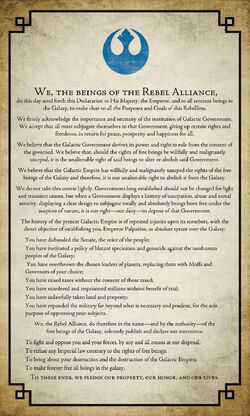
The Declaration of Rebellion established the legal, democratic conditions for the Alliance to Restore the Republic's war against the Empire.
Conversely, the Rebel Alliance's "Twilight Company" actively recruited ordinary civilians who shared the rebel movement's ideals of freedom and democracy on worlds where they battled the Empire, even though Alliance policy officially forbade the practice. Despite the realities of war, young cadets enlisting in the company had the expectation of saving people as heroes of democracy.[257] To counter the Empire's claims that her rebels were anarchists and terrorists who sought to destroy the galaxy, Mothma wrote the Declaration of Rebellion based on the language of law. The declaration recognized the need for a "Galactic Government" with jurisdiction over all beings who must give up "certain rights and freedoms" to ensure harmony between everyone. Such "power and right to rule" derived from "the consent of the governed" and that "free beings" had the "unalienable right" and "duty" to change a government with a sustained history of "willfully and malignantly" usurping their rights.[17]
The vessels of the Alliance Navy, such as the Home One, were characterized as defenders of democracy, much like the starships of the Republic Navy before it.[110] The Alliance decried the Empire's abuses, namely the disbandment of the Senate; a policy of human-centric speciesism and genocide; the replacement of member worlds' chosen leaders with moffs and governors; the raising of taxes "without the consent of those taxed;" imposing legal punishments such as imprisonment and the death penalty without trial; "unlawfully" taking "land and property;" and excess military expansion for the "sole purpose" of oppression. Refusing "any Imperial law contrary to the rights of free beings," the beings of the Rebel Alliance therefore pledged their property, honor, and lives to destroy the Emperor and his Empire and "make forever free all beings in the galaxy."[17]
What is stronger than fear?[]
- "I believe in the Rebel Alliance. I believe in its mission. I believe we will succeed. The Empire will be defeated, and freedom will return to this galaxy. I will not stop until we win, and then I will fight to make sure nothing like the Empire ever returns."
- ―Leia Organa
Despite massive losses to the Empire at the Battles of Mako-Ta and Hoth, the Rebellion continued to grow as Imperial military abuses against citizens intensified. Facing organized local resistance, Moff Gideon oversaw the near-total genocide of Mandalore.[25] When riots broke out on Milvayne—which Imperial propaganda had touted as an ideal world, heavily policed by the local authority without a visible Imperial presence—minister Pitina Mar-Mas Voor said "I daresay Milvayne will be back on track" if the Empire imposed "three years of martial law and a few well-placed bombardments."[259] So concerned was Voor for the Empire's public image that the minister wanted to overthrow the "unlovable" Emperor; ironically, her plot was leaked to the HoloNet before the Empire censored it from the public and executed her.[4]

The Emperor was losing control of the galaxy as the war raged on.
Both the Empire and the Rebellion grappled with the chaos of the criminal underworld, including the Syndicate War instigated by Crimson Dawn[25]—criminal groups competed for the Emperor's favor based on the rumor that he was ending the Empire's informal arrangement with the Hutt Clan under Jabba.[260] Relying on hatred for the Empire instead[261] of also embracing the hope that helped to fuel the Alliance,[244] Lady Qi'ra failed to topple the Imperial regime in her syndicate's war against the Sith,[262] but the Rebellion continued to grow[25] and learned that the Empire was building a second Death Star thanks to Crimson Dawn.[263] The scoundrel Kay Vess sought a free life between taking on jobs for competing syndicates, in the process helping the rebels foil the Imperial Security Bureau's infiltration of the criminal underworld and gain a codex of ISB files.[264] The Rokana Raiders pirate crew was active around the same time and operated under the democratic Rokana Code, in which the pirates put important matters to a vote.[265]
Citizens watching the HoloNet witnessed a rebel attack on an Empire Day parade where Alliance forces took care not to inflict civilian casualties, followed by rebel starships damaging a giant statue of the Emperor near Coruscant's Monument Plaza.[266] The Alderaan Flotilla was later attacked by the late Wilhuff Tarkin's protégée, Ellian Zahra. With support from Luke Skywalker, Leia Organa reconciled her duties as a princess, senator, and general after letting Zahra escape and—when she insisted on her obsession to exact vengeance against Organa—ordering the rebel fleet to kill Zahra instead. Thus relieved of the imminent threat and her sense of guilt over the Death Star's destruction of Alderaan, Organa spoke with Beon Beonel of the Alderaan Flotilla. She learnt that the Alderaanians had voted to disband the fleet: they wanted to find new places to call home and live in the wider galaxy, rather than narrow themselves to a singular identity as surviving refugees. While she dedicated herself to the war against the Empire and wished to fight on to prevent the return of tyranny, Organa also wanted a future in which she lived fully "with purpose in peace" and chose to focus on rescuing her lover, Han Solo, from Jabba the Hutt before comitting to battle against Death Star II.[258]
Bothan spies had confirmed that the battle station was being assembled in the Endor system, which prompted Organa to lead Operation Yellow Moon to distract Imperial forces in the faraway Corva sector as the Alliance Fleet gathered in the Sullust system. Organa led Nien Nunb, Antrot, Kidi Aleri, and Lokmarcha under the ruse of a recruitment run, but with potential recruits' lives at risk, she had herself and her team risk their own lives to ensure others' safety; she believed that the rebels fought not only for the anti-Imperial cause and duty but for each other, with love as an even more powerful force.[267] During the rebel rendezvous over Sullust, Tomasso of the Spice Runners of Kijimi told Mon Mothma that the Emperor and his ruling coterie were aboard the new Death Star. Mothma and Tomasso were nearly killed by an assassin of the Empire when they met on Desinta.[268] Unbeknownst to the rebels, the Emperor was luring them toward his best and well-prepared forces, with a focus on turning Luke Skywalker into his new apprentice.[269]
The New Republic[]
Heart of darkness[]
- "This is democracy. It is strange. And it is messy. It's not about getting it right. It's about trying to get it right. Yes, it's a bit chaotic. Certainly we will get some things wrong. The Empire? They cared nothing for democracy. […] But we will listen. To the countless voices crying out across the galaxy, we have opened our ears, and we will always listen. That is how democracy survives. That is how it thrives."
- ―Olia Choko

Heroes and friends toppled the Imperial regime after years of intense struggle.
At the Battle of Endor in 4 ABY, the rebels befriended the local Ewoks and they overcame the Imperial forces together. At the same time, Luke Skywalker affirmed that he was a Jedi and inspired his father's conscience. In an act of self-sacrifice for his son, Anakin turned against his Sith master and killed the Emperor.[269] News of the Emperor's death and the Rebellion's discovery and destruction of the second Death Star inspired spontaneous uprisings across Imperial worlds, with civil war erupting on Coruscant[13] as Imperials deserted the military in droves. Loyal Imperial forces enacted the Emperor's Contingency, heeding his posthumous instruction to initiate Operation: Cinder—select worlds, regardless of whether or not they were affiliated with the Empire or the value of their resources were devestated. The genocide of billions prompted a second wave of deserting Imperials.[28] Meanwhile, the late Emperor's protégé Gallius Rax quickly gathered the bulk of the Empire's military might under Grand Admiral Rae Sloane's Shadow Council, secretly aiming for a final showdown on the Inner Rim world Jakku. In accordance with the Emperor's will, Rax intended to both bring down rebel forces and cull an empire that had failed its Emperor.[270]
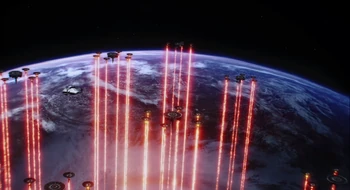
While the Empire succumbed to chaotic retreats, mass defection, and infighting, loyalists heeded the Emperor's last command to commit genocide across both rebellious and faithful Imperial worlds.
Among the worlds selected for Operation: Cinder was the Emperor's homeworld of Naboo. Although Naboo's monarchy had been rendered ceremonial, Queen Sosha Soruna and Governor Donta Gesset joined Leia Organa and other rebels in repelling Imperial forces over Naboo twenty days following the Battle of Endor.[271] As the Rebel Alliance reorganized itself as the New Republic, Naboo became a member of the new democratic state.[132] Mon Mothma served as the Chancellor of the New Republic, reviving democracy with the restoration of the Galactic Senate on Chandrila. Mothma's public relations representative, Olia Choko, gave an interview in which she was assaulted by a fruit thrown by Geeska Dotalo. The disgruntled citizen spoke of his homeworld, Gan Moradir, being embroiled in chaos and famine due to the war, and Choko encouraged Dotalo to serve as his world's representative in the Senate. Choko then chastised a New Republic officer nearby for parading captured Imperial soldiers, stating that the New Republic should not replicate the demeaning acts of the Empire; she believed that mistakes were inevitable in a democracy, which relied on listening to and learning from everyone to survive and thrive.[13]
At the time of his "Iron Blockade" over the Anoat sector, the rogue Moff Ubrik Adelhard reached out to the criminal underworld and allied with Zeva Bliss' spice runners on the Outer Rim world Kijimi, who were willing to fuel further chaos so as to better their own advantage. Adelhard enlisted hunters to assassinate prospective senators,[272] while the Sith-worshipping Acolytes of the Beyond emerged on Taris and recruited disaffected youths. The Acolytes led civil unrest on Corellia in which they destroyed speeders, attacked Peace and Security officers, looted stores, and mobbed pedestrians. They then attacked New Republic soldiers setting up aid outposts on worlds such as Devaron[270] and targeted leaders such as Leia Organa. Both she and her brother reflected that the fanatics had no understanding of the Force, murdering people to steal dark side relics simply out of their obsessive fascination for the Sith and later as terror agents of Moff Adelhard.[273][274]
New Republic Intelligence officer Caern Adan was concerned with the nascent government's national security vulnerabilities from terrorist bombings and precision strikes by starfighter forces such as the 204th Imperial Fighter Wing, dubbed "Shadow Wing." Adan formed a dedicated working group targeting Shadow Wing with General Hera Syndulla's support: Alphabet Squadron, led by Yrica Quell, a former Shadow Wing pilot who partook in the genocide of Nacronis during Operation: Cinder.[28] During the war in the Cerberon system, the local Children of the Empty Sun religious sect endured both Imperial and Republic bombs, and its leader taught that both sides were "oppressors," with the New Republic differing "in its words, not its deeds." The group believed there would be no "peace through bureaucracy" and only its particular vision of the Force promised "true peace." When Alphabet Squadron discovered the truth of Quell's actions on Nacronis, the pilot Chass na Chadic cynically thought that the New Republic was corrupt enough to knowingly recuit war criminals.[34]
Victory and death[]
- "For those who survive, wiping the slate clean is the only way to bring peace. If a record of the Empire's sins exists, it will breed violence for decades."
- ―Soran Keize
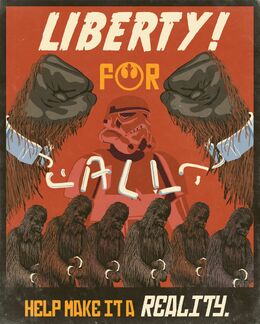
Liberty for All, a poster calling on the freedom-loving people of the galaxy to break the chains of Imperial oppression
Wishing to accelerate the Empire's defeat, the New Republic Senate voted for the creation of three new Starhawk-class battleships in addition to the prototype Starhawk to rival the firepower of Imperial capital ships,[276] which lost control of Kuat Drive Yards in 5 ABY.[25] Chancellor Mothma ordered New Republic forces not to engage occupying Imperial forces on Kashyyyk for subsequent peace talks with the Empire. Before they collapsed due to Imperial sabotage, Leia Organa led rebel veterans in the unauthorized liberation of Kashyyyk and the enslaved Wookiees on their homeworld, which briefly made her a political pariah.[270] As Imperial forces were repelled from sectors across the galaxy, surviving forces gathered in the sparsely populated Jakku system, in a remote part of the Western Reaches. Beyond either Imperial or Republic control were the New Separatist Union and the pirate territories of the Sovereign Latitudes of Maracavanya.[275]
Colonel Soran Keize of the 204th Imperial Fighter Wing thought that his forces would lose the war, but he believed that the Republic would be merciless even if Imperials surrendered or deserted to live in peace—he realized that the Emperor kept meticulous records of his people's complicity on Coruscant, binding even the lowest ranking functionaries of the Empire to the regime's atrocities by guilt, and he was resolved to destroy the Emperor's data banks in a bid to keep his people from retribution. Meanwhile, Commander Wyl Lark of General Syndulla's starfighter squadrons decided to leave the war given the Imperial retreat, believing that it would be impossible to stop all Imperials, and attempts to do so would simply antagonize more ex-Imperials and "breed martyrs."[275] Having completed his preparations, Gallius Rax leaked his forces' location to the New Republic, and the Senate narrowly voted to approve sending the military to Jakku.[270]
Chancellor Mothma pushed for the Military Disarmament Act[277] in the lead-up to the Battle of Jakku, claiming "democracy is not in need of defense" but "people are," proposing to cut down the New Republic Defense Force to 10% and divert resources to train member worlds' own local militaries once the war was won. Military control was also redirected from the Chancellor's office to New Republic High Command.[13] With the benefit of hindsight, the historian Beaumont Kin suggested that the Republic was not ready for demilitarization, which was intended to allow star systems and sectors to maintain their own defense forces and form ad-hoc coalitions if necessary but ultimately undermined the Republic.[4]
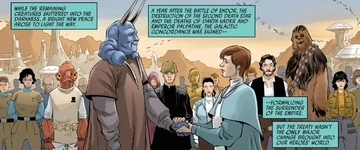
The New Republic secured the surrender of Imperial remnants after the Battle of Jakku.
At the Battle of Jakku, Adelhard intended for his coalition to destroy both Imperial and Republic forces, but the Spice Runners of Kijimi had become wary of Adelhard's power and helped the Republic through their underworld contacts; Eleodie Maracavanya's band of pirates aboard the Super Star Destroyer Liberty's Misrule attacked the Imperials[278] while the Kijimi Spice Runners themselves attacked Adelhard's forces.[279] Commodore Kyrsta Agate's Starhawk brought down the Imperial Super Star Destroyer Ravager, and at the battle's end, the New Republic emerged victorious.[270]
Concord in civility?[]
Spreading ideals[]
- "We didn't fight these battles—these wars—to merely sit back and savor the victory. There's work to be done. And the onus is on us to spread the ideals that we hope to build this New Republic on. We've got to welcome the galaxy into our fold. And it won't always be easy—it never is."
- ―Princess Leia Organa, to Chancellor Mon Mothma

A New Dawn, celebrating the restoration of democracy on Chandrila, the first capital of the New Republic.
Within a year, the signing of the Galactic Concordance ended the Galactic Civil War, with large portions of the remaining Imperial territories being incorporated into the New Republic. A few traditionally conservative worlds of the inner systems' Imperial remnant also surrendered but remained outside the New Republic on the conditions set out in the Galactic Concordance, but the remnant soon collapsed due to its members' disunity.[132] Leia Organa pushed for the Republic to spread its ideals across the galaxy by persuading more systems to join it.[280] Likewise, a report for the Committee of Democratic Implementation stressed that the New Republic should focus not just on new laws but to give citizens an understanding of justice and a system in which laws were consistently and fairly applied.[4]
Some worlds chose not to join the New Republic and remained neutral, such as Ryloth, whose freedom fighters had their hard-won independence.[281] The Narquois people sued their Neimoidian neighbors for imposing hundreds of years of serfdom on them, with the New Republic courts handling unprecedented levels of compensation claims.[63] Through elections, the government periodically relocated its capital across member worlds, placating the outlying systems that had seceded from the Republic in the lead-up to the rise of the Empire.[277] The New Republic maintained a defense fleet but not a formal military. Leia Organa likened the new democracy to being a teenager, where every new crisis felt like the first one.[282]
The Pirros problem[]
- "Is this how our grand revolution ends? The second our mettle is tested, we fall back to old habits? We answer threats and violence with bigger threats and violence? So much for the New Republic then. If we have to fight, we will fight—but we did dream of a softer way. I didn't imagine it. A way less reliant on anger and violence."
- ―Leia Organa, to Mon Mothma
Around 6 ABY,[284] the New Republic attempted to woo the world Pirros ahead of their trade summit. Although it was once part of the previous Galactic Republic, however, the world's new leadership was hesitant to accept that membership in the New Republic would improve trade and defense, especially since Pirros was a leader of the Fenril sector. On top of that, the supplies sent by the Republic in an act of goodwill had to endure pirate attacks, which made the Republic seem weak. After accusing Republic Councilor Kith Alaytia of having been Moff Adelhard's lieutenant, Pirrosi Prime Minister Kezrin Almovar expelled the Republic from the summit and suspended trade, with the Fenril Consortium shooting down a Republic trading ship,[280] the Nechrim's Wake,[285] for "trespass."[280] The Nechrim's Wake crashed on the planet Loradil, where its crew was attacked by[285] remnants of the Separatist Droid Army that had been trapped on world since the Clone Wars.[286]
As Han Solo, Luke Skywalker, and Beilert Valance donned the garb of the fallen old Republic in the form of clone trooper gear so as to defeat the Separatist remnant, the Fenril Consortium-New Republic struggle continued and escalated, much to Organa's upset as it represented a fallback into threats and conflict.[283]
Operating an amnesty program[]
The New Republic started a de-Imperialization process with ex-Imperial civil servants who were deemed to be low-value and low-risk, fast-tracking their return to important administrative and bureaucratic positions under the new state. Ex-Imperials who committed lesser criminal offenses were gradually released with restrictions on weapon ownership and voting rights, which were lifted when they were judged to pose no potential threat. The New Republic Amnesty Program rehabilitated ex-Imperials on Coruscant with droid counselors while the Reconciliation Project attempted to provide healing and closure by pairing ex-Imperials with citizens who had suffered under the regime. The education systems of some worlds also incorporated the memoir of former ISB agent and Alliance intelligence officer Alexsandr Kallus, which reflected on the war from both perspectives.[4]
Under the Duchess and ex-Imperial Captain Bombardier, the royal family of Plazir-15 transformed itself into an elective monarchy leading a direct democracy following the Empire's collapse; Plazir-15's charter affirmed the world's pacifism and pluralism, with citizens directly involved in decision-making and choosing to be independent of the New Republic.[287] In 9 ABY,[288] a tannoy announcement at Plazir-15's domed city declared that it was the only remaining direct democracy in the Outer Rim. Its society was welcoming of droids, who made up most of the city's workforce while organic beings were largely free to live comfortable lives. The human security chief Helgait, a long-time supporter of Count Dooku and his vision of "democracy," infected some of the droids' Nepenthé lubricants to cause mayhem in the city, but he was stopped by Mandalorians Bo-Katan Kryze and Din Djarin.[287] In previous decades, the advance of the Separatist Droid Army and the Empire's encouragement of prejudice had exacerbated anti-droid sentiment, though the age of Rebellion inspired droid uprisings demanding liberty and equality. Even prominent human rebels treated droids as fellow family members[238] despite a brief galaxy-wide droid plague occurring between Crimson Dawn's war against the Empire and the Battle of Endor,[289] and the New Republic encouraged the trend of acceptance between organic and mechanical beings.[238]
Imperial Remnant threats[]
- "You cannot defeat evil once and consider yourself victorious. It is our duty as the New Republic to challenge evil when we see it, no matter how scarred or hurt we are from past conflicts. We either stand for what we believe in forever without limit or qualification, with strength and bravery, or we shall fall to the same elements that crushed the Republic decades ago."
- ―Senator Leia Organa, cautioning against complacency in the New Republic Senate
To protect the child Grogu from Imperial warlord Moff Gideon and his forces, Din Djarin also worked with Marshal Carasynthia Dune of the New Republic. At her Mandalorian friend's request, Dune circumvented protocol to discharge convict Migs Mayfeld. The ex-Imperial infiltrated the secret Imperial refinery on Morak alongside Djarin by ferrying explosive rhydonium fuel to the site, where Mayfeld met Valin Hess, his commanding officer during Operation: Cinder. Detesting the man's sadistic indifference about their last operation on Burnin Konn, where thousands of civilians and even Mayfeld's fellow soldiers were slaughtered, Mayfeld killed Hess and destroyed the refinery while Djarin obtained information about Gideon's cruiser.[291]
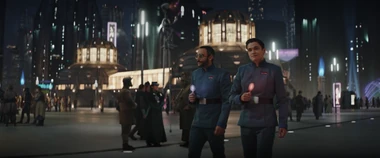
The New Republic welcomed captured Imperials such as Elia Kane and Dr. Pershing into its Amnesty Program.
Following the capture of Gideon and his cruiser, several of its ex-Imperials were placed in the New Republic's Amnesty Program. Cloning specialist Dr. Penn Pershing was among the scientists working for the New Republic on Coruscant, though his parole droid advised him that the Coruscant Accords had since banned cloning.[292] Escaping from New Republic custody, Moff Gideon was able to organize with his forces within the Republic and speak with the Shadow Council of other Imperial Remnants.[293] Gideon gathered his forces on Mandalore, wishing to engineer an army using research into cloning, the Force, and Mandalorian technology, but a diaspora of warriors who rallied around Bo-Katan Kryze ousted the warlord's forces from their homeworld.[294]
Around the same time,[25] the Santhe Corporation's Corellian shipyards had been repurposed by the New Republic to dismantle Imperial Star Destroyers and repurpose key parts for the New Republic Defense Fleet. According to Regional Supervisor Myn Weaver, other parts were sold to the shipyard's investors to generate profits for Republic reconstruction projects. However, he and the shipyard workers were secretly Imperial loyalists who shipped the hyperdrive cores to Morgan Elsbeth, an ally of Grand Admiral Thrawn.[295] Elsbeth used the cores to build a hyperspace ring that delivered Thrawn from his exile to the witches' world of Dathomir.[296] The resulting military campaign was classified by the New Republic.[4]
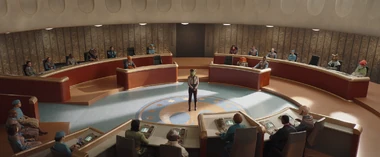
The New Republic debated issues of defense in a joint committee of senators and armed forces leaders.
New Republic General Hera Syndulla had briefed Chancellor Mothma and the Senate Oversight Committee about her intervention at Corellia's shipyard and raised warnings about the threat of Thrawn's return, but Senator Hamato Xiono led opposition to Syndulla's request for aid.[297] Defying the committee's denial of permission to investigate further, Syndulla and Captain Carson Teva led a squadron of ships to the hyperspace ring's place of assembly, where two of Teva's pilots died in a collision.[298] A detachment of New Republic vessels retrieved Syndulla and Teva's squadron, and the general was summoned before the Senate Defense Council. Senator Xiono derided General Syndulla at the hearing, chaired by the Chancellor, and commented that Syndulla's rebellious actions were not appropriate for an established government like the New Republic. When Captain Teva raised Moff Gideon as an example of the threat posed by Imperial remnant leaders, Senator Xiono asserted that Gideon acted alone. Although Xiono wanted to refer Syndulla to a court-martial, C-3PO interrupted the meeting, relaying Senator Leia Organa's cover-up story that she had authorized Syndulla's mission unaware of the Oversight Committee's prior denial.[299]
Light in the underworld[]
- "Living with the Tuskens has made you soft."
"No, its made me strong. You can only get so far without a tribe." - ―Fennec Shand and Boba Fett
Concurrent to the developing Imperial Remnant crisis[301] in 9 ABY,[25] the famed bounty hunter[302] Boba Fett returned to Tatooine with the assassin Fennec Shand at his side[301] and claimed control over the criminal empire that had once belonged to the late Jabba the Hutt,[303] having decided that "idiotic" crime lords had led one too many bounty hunters to their deaths. Instead, Fett intended to forge his own gotra[300] built off of respect, instead of relying on fear.[303] Further, inspired by his time living amongst the Tusken Raiders, he hoped his new gotra would be a true community that would strengthen its members[300] and protect the community of Mos Espa. Fett's rule was challenged by the Pyke Syndicate's arrival on Tatooine, but he was able to affirm his place as Daimyo of Mos Espa by triumphing in the battle, winning the love of the community in the process.[304]
In 18 ABY,[25] Poe Dameron left his home on Yavin 4 and fell in with the Spice Runners of Kijimi, falling in love with Zorii Bliss in the process. Many months later, they helped Zorii's mother, Zeva, arrange the Kijimi summit of key players in the galactic criminal underworld to elevate the spice runners' position. However, Dameron's idealism foiled the Bliss' brutal tactics, and he fled Kijimi City to join the New Republic, having found resonance with Senator Leia Organa's principles of needing to continually challenge evil, which she expressed in broadcast Senate debates.[290]
Fascism festers[]
- "In the post-war years people became so determined to look forward that they did not spend nearly enough time looking back at what they had left behind. They tied themselves so tightly to the belief that this should never happen again that they neglected to take the steps to ensure that it could not."
- ―Beaumont Kin, The Rise and Fall of the Galactic Empire
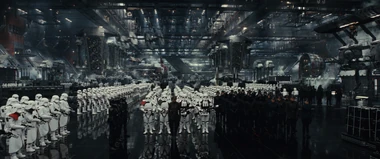
Behind machinery and masks, the First Order's fascism took advantage of individuals' sense of insecurity in its ambition to restore the Empire's might.
Not all inhabitants of the galaxy were swayed back to democracy. Aiming to revive the Empire's false glories after a period of hiding in the Unknown Regions, the First Order was a fascist junta[305] formed from a select few Imperial loyalists and Gallius Rax's child soldiers who survived the Battle of Jakku as part of the late Emperor's Contingency.[270] The Order came under the control of Snoke, a secret creation of Darth Sidious' Sith Eternal cult on Exegol,[306] and took advantage of the New Republic's demilitarization under Chancellor Mothma to strengthen a military more technologically advanced than that of the Old Empire's.[307]
Despite the New Republic's arms manufacturing restrictions, major arms corporations[2] such as Sienar Fleet Systems and Kuat Drive Yards created subsidiaries such as Sienar-Jaemus Fleet Systems and Kuat-Entralla Drive Yards operating outside the New Republic's boundaries to supply the First Order.[307] The First Order kidnapped children to be indoctrinated and trained for its stormtrooper program as part of Project Resurrection, which eventually came under General Armitage Hux and Captain Phasma's oversight.[91] The Order specifically targeted rebel veterans such as Lando Calrissian,[306] whose daughter was kidnapped in 15 ABY. By 21 ABY,[25] the Corporate Sector Authority was covertly funding the First Order and had transformed part of its own Security Police into an army.[274] Jinata Security collaborated with the Order on Project Resurrection in the Core Worlds' Jinata system, where the planet Vardos was under the control of Jinata Security's leader, Protectorate Gleb.[308]
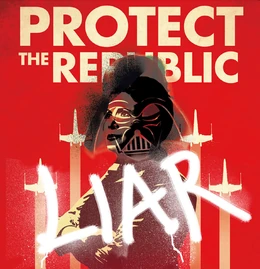
Senator Leia Organa was driven out of politics, and she formed the Resistance as the New Republic remained unmoved by her warnings.
Senator Leia Organa led politically unpopular campaigns for re-arming the Republic.[277] She uncovered that the crime lord Rinnrivin Di, whose cartel raided trade lanes around Ryloth, was funded by the Amaxine warriors, who were in turn agents of the First Order. Frustrated by the Senate's unwillingness to take action against the increasing encroachments of the First Order and scandalized by the public revelation that her father was Darth Vader, Organa left politics in the Senate to set up a paramilitary force named the Resistance[14] in 28 ABY.[25]
Since the Chancellors who succeeded Mon Mothma lacked her charismatic power, the Chancellor remained a largely ceremonial post with little effective authority. The Senate continued suffering from political gridlock between the Centrist faction that wanted to be governed by a strong and centralized executive power and Organa's Populist faction.[14] In 29 ABY, a majority of systems aligned with the Centrist movement seceded from the New Republic and publicly joined the First Order,[40] having been disillusioned with the Republic government's lack of cohesion and the resulting collapse of essential services. Organa had tried to keep the Centrist systems within the Republic, if only to make sure they could be monitored, but unlike the Old Republic Senate under Palpatine's chancellorship, the New Republic Senate chose not to oppose the departure of the dissatisfied systems[2] and welcomed the end of political gridlock.[17]
Cold War in the Borderlands[]
- "The galaxy's hard-won peace is at risk. We may only get this one warning, this one chance to take action. I implore you to study my findings carefully, and with an open mind. What we're discovered should transcend petty political bickering, or your personal opinion of me. Unless we want another war—and surely, after the bloodshed that twenty years ago, nobody can want such a thing—we must be on guard. We must come together. We have to act."
- ―Leia Organa's call on fellow senators to recognize the First Order threat
Cold War tensions emerged as the First Order made incursions in the Borderlands between New Republic and First Order space,[309] While Leia Organa remained politically unpopular, the Senate tolerated the Resistance's activities,[277] which monitored the First Order while trying to avoid galactic conflict.[2] The New Republic's Senate Intelligence Committee dismissed evidence of the First Order's activities as insignificant to warrant action.[309] Furthermore, Vice Admiral Amilyn Holdo of the Resistance gathered evidence that the New Republic Defense Force was intentionally taking no action regarding the First Order's growth.[310] In 31 ABY,[311] Poe Dameron and other New Republic pilots of Rapier Squadron joined the Resistance, having been told by their superior officer that the First Order was not a serious threat following a failed attempt to stop the Order's hijacking of a freighter in which they lost a fellow pilot.[309]
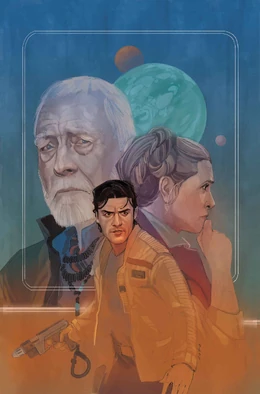
Poe Dameron began learning to be a leader as General Organa tasked him with the search for Lor San Tekka.
Leia Organa later tasked Dameron and his colleagues with intercepting Erudo Ro-Kiintor, a New Republic senator of the Centrist faction who had blocked motions to sanction the First Order and increase funding for New Republic forces. Indeed, the Resistance found in the Borderlands that the First Order had been transferring large sums of money to Ro-Kiintor via the Corporate Sector Authority and disguised through proxy companies.[309] In 32 ABY,[312] Dameron led Black Squadron on a search for Lor San Tekka—the explorer believed to be the lead on the whereabouts of Luke Skywalker—and found First Order forces attempting the same. Despite the Resistance's rules of engagement requiring members not to initiate a direct attack on First Order forces, Black Squadron pilot L'ulo L'ampar fired upon a First Order landing platform on Ovanis. Afterward, Dameron spoke with L'ampar about the incident, with the latter believing that hostile starfighters ought to be destroyed at every possible chance before the forthcoming war, but the squadron leader responded that the Resistance should not be accelerating the conflict as they were not yet ready, and their duty was to prepare while also helping the New Republic understand the First Order threat.[313]
When the First Order blockaded the Otomok system, the New Republic simply voiced opposition and accepted the Order's claim that it was an internal affair.[314] The Order freely extracted ore from Hays Minor of the Otomok system,[315] tested weapons on the world, and stole its children to bolster the stormtrooper ranks. As for the Resistance, they violated New Republic regulations on military equipment that prevented newer Koensayr Y-wing models from carrying ion cannons and bomber ordance launchers—the group had been acquiring the vessels and modifying them to better counter First Order forces[316] together with Slayn & Korpil MG-100 StarFortress SF-17 heavy bombers.[314]
Two young women from Hays Minor, Paige and Rose Tico, fled their homeworld and joined the Resistance. The Tico sisters were among the crew of two squadrons of those heavy bombers led by Vice Admiral Holdo in a campaign in the Borderlands' Cassander sector against local pirates who were being supplied by the First Order without directly engaging the Order's forces[314] in 34 ABY.[25] Instead of heeding Leia Organa's warnings of First Order military build-up, Chancellor Lanever Villecham simply focused on promoting New Republic trade relations with the neutral systems of the Trans-Hydian Borderlands and was serving his second year as Chancellor[277] in the same year.[317]
Complacency kills[]
- "Not realising that the ideology that had once produced stormtroopers armor was still producing stormtroopers. Chancellor Lanever Villecham resolutely refused to heed the warnings from the likes of General Leia Organa as to what was about to happen."
- ―Beaumont Kin, The Rise and Fall of the Galactic Empire
In that year,[25] Resistance spy Vi Moradi investigated the new stormtrooper project and came into contact with "Cardinal," who supervised the training of young children. The stormtrooper leader believed that the Republican system of government was "doomed to fail" because sentient beings were incapable of pursuing rational long-term self-interest; he believed it was the First Order's mission to sort the Republic's "mess" by removing "diplomats and lobbyists who don't represent real people with real problems" and "bringing equality to all." Cardinal later became disillusioned with the Order after realizing the brutal and unforgiving nature of Captain Phasma and was rescued by Moradi.[318] The Resistance later placed him on a "deprogramming protocol" in the forests of Cerea that rehabilitated people who had been brainwashed by First Order indoctrination.[319]
New Republic Command[320] later[25] sent the pilots Kazuda Xiono, Mia Gabon, and Hugh Sion to deliver secretive intelligence to Commander Poe Dameron of the Resistance. They were directly attacked by Major Elrik Vonreg of the First Order, but Xiono was able to deliver the information to Dameron, and they and Leia Organa learned that the First Order was planning a massive attack on the Republic.[320] General Organa sent her envoy, Korr Sella, to warn the Republic Senate on Hosnian Prime, where she met Chancellor Villecham.[27]
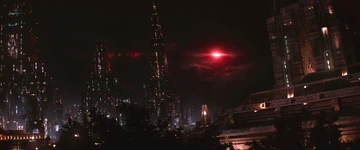
Warnings of the First Order's rise were ignored by the New Republic on Hosnian Prime—its last capital—until it was too late.
However, the entire Hosnian system, home the New Republic capital and the bulk of its fleet, was obliterated by the First Order with a single strike from their Unknown Regions superweapon, Starkiller Base. Although the Resistance destroyed Starkiller Base shortly after, the Order proceeded to conquer much of the galaxy[277] under a vanguard of zealous young commanders such as the technologist General Armitage Hux.[40] They embraced Neo-Imperialism,[132] whittling down the main Resistance fleet to a single starship—the Millennium Falcon—in a brutal war,[281] with ex-Imperial elders approving of the resurgence of fascism and militarism.[40]
Age of Resistance[]
Lighting the flame[]
- "That's how we're gonna win. Not fighting what we hate, saving what we love."
- ―Resistance fighter Rose Tico

Leia Organa served as a fighter for democracy in both politics and the battlefield.
The Resistance comprised not only of Rebel Alliance veterans but those who found friendship among each other in face of the First Order's aggression—such as the aspiring Jedi Rey, the defected stormtrooper Finn, the pilot leader Poe Dameron, and the mechanic Rose Tico. Although the Resistance sent pleas for help to their allies across the galaxy at their most desperate hour, none responded. The galaxy's wealthiest industrialists tried to profiteer from the war while living luxuriously in resorts such as Canto Bight on the Corporate Sector planet Cantonica, funding both the First Order and the Resistance's machines of war. Luke Skywalker had gone into exile on Ahch-To, believing that the Jedi's legacy was hypocrisy, hubris, and failure in overseeing the rise of Darth Sidious, Vader, and Kylo Ren of the First Order. However, Skywalker was spurred from apathy by a persistent Rey, heeding Yoda's advice to pass on his lessons as a Jedi. Kylo Ren continued to reject his family's love when Rey confronted him, thinking of himself as a "monster" of the dark side and fulfilling his ambition to replace Snoke as the First Order's Supreme Leader. Nevertheless, stories of heroism, such as Amilyn Holdo's self-sacrifice against the First Order fleet and Luke Skywalker's standoff against the First Order Army on Crait began to inspire rebels with hope across the galaxy.[321]
Ikkrukk was among the hundreds of worlds invaded by the First Order. Although the Resistance defeated the First Order forces that were destroying Grail City, Prime Minister Grist was unwilling to lend further support for fear of First Order retaliation, and some members of her government cabinet were even sympathetic to the new regime and hoped that occupation would benefit the city financially. Later, the Resistance was temporarily sheltered by the Ryloth Defense Authority militia, but Chancellor Drelomon's Rylothian government was worried that the Resistance's presence would draw the destructive wrath of the First Order. On Akiva, which had been the first planet in the Outer Rim to join the New Republic, voters removed the incumbent governor in an emergency election in favor of a First Order–affiliated merchant.[281]
The First Order blockaded Ryloth to demand tithes anyway, oblivious to the Resistance's presence. General Organa promised the RDA leader, Yendor Brethen, that she would not ask him to fight his relucatant government or people. However, the government betrayed the RDA, whose base was attacked by the First Order, yet the Resistance had taken the time to re-gather its forces and evacuate. The group also stole a list of rebel veterans from First Order–occupied Corellia, intending to recruit them to the cause.[281] The Tah'Nuhna civilization, who remained neutral in conflicts from the Hundred-Year Darkness to the rise and fall of the Empire, were later destroyed by the First Order for briefly providing refuge for the Resistance.[322]
Citizens of the galaxy[]
- "Where did they get all these fighter craft? They have no navy."
"It's not a navy, sir, it's just… people." - ―Allegiant General Pryde and Admiral Frantis Griss, surprised by the Citizens' Fleet
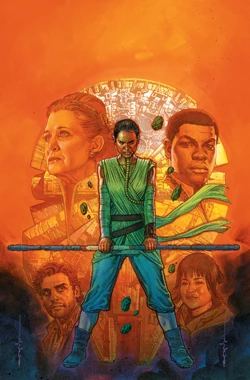
The Resistance was not only led by General Organa but bound by friendship and a sense of family among its fighters.
Spurred by the collective punishment of the Tah'Nuhna, the Resistance sought the support of the Mon Cala fleet, pleading King Ech-Char to support their cause. Ech-Char wanted to protect his people from First Order retaliation and refused to support the Resistance, and he also chaired the Mon Cala court with the support of isolationist Quarren advisors to order General Organa's group to leave the world.[324] When the First Order arrived, the veteran Quarren leader Nossor Ri sacrificed himself to allow the Resistance to leave the planet alongside Aftab Ackbar's Mon Cala fleet.[325]
The Resistance subsequently relocated to the secluded world of Ajan Kloss. While Kylo Ren's First Order struggled to reconcile either its orderly militarism with mysticism or its youthful vanguard with its ex-Imperial veteran leaders, the tyrannical junta adhered to Palpatine's contingencies when the Emperor resurfaced[40] in 35 ABY.[25] He had been resurrected due to the cloning efforts of his Sith cultists on Exegol, which also boasted hundreds of planet-destroying Xyston-class Star Destroyers and supporting forces made from resources secretly funneled by Sith loyalists in the executive boards of Sienar-Jaemus and Kuat-Entralla. Attempting to fuse his cultists' efforts with the First Order to create a "Final Order," the reborn Emperor received steadfast support from the "High Human" ideologue Allegiant General Enric Pryde.[40] Kylo Ren revealed to Rey that she was a descendant of Palpatine, but as the Jedi student of Leia Organa and Luke Skywalker, she accepted that she was susceptible to the urges of the dark side while rejecting the burden of her blood—she instead re-affirmed her bond to her friends and the Skywalkers, including the "good" that she believed still existed in Kylo Ren and her duty as a Jedi.[323]
Ren, sensing the love of his dying mother and inspired by Rey, made the choice of embracing his Jedi self as Ben Solo. Poe Dameron also confronted his complicated past as a spice runner in Kijimi City, with his idealism convincing Zorii Bliss to help oppose the First Order. The Resistance additionally gained support from Company 77 after Finn formed a rapport with the group—like him, they were former stormtroopers who had deserted the First Order after refusing to carry out an order to fire upon civilians and were willing to fight to stop the regime's oppression. The Resistance was impossibly outnumbered as it tried to stop the Sith Star Destroyers from launching on Exegol. However, Lando Calrissian assembled a fleet comprised of volunteer citizens from throughout the galaxy who heeded the call of the late Leia Organa to help the Resistance movement.[323]
Among the Citizens' Fleet were unaffiliated fringers and criminals from the anarchy of Kijimi City who championed their individual independence from politics or any authority and had taken the New Republic's limited ability to enforce interstellar law for granted; the draconian First Order roused them from apathy. Despite Kijimi's occupation and destruction under Pryde's command, the people of Kijimi were joined by people from other locales, including the royal-born Wilsa Teshlo, a member of the matriarchal Veiled Sorority pirate fleet; the Caracara Squadron mercenaries, who lended defense services to star systems; Kid Malmash of the Nebular Kelpie, transporter of political refugees;[40] and the residents of the Colossus, a supertanker home to the Resistance spy Kazuda Xiono and hunted by the First Order.[2]
The people joined Rey at the Battle of Exegol, and together, they defeated the Sith once and for all. The people of the galaxy, free at last, then led spontaneous uprisings across the galaxy, burning down the First Order with the hope of building a new future of harmony.[323] Resolving that the people of the galaxy could not afford risk another round of oppression in light of the New Republic's failure, Resistance member and historian Beaumont Kin then wrote The Rise and Fall of the Galactic Empire, a book reflecting on the past decades of galactic tyranny.[4]
Behind the scenes[]
Love in the time of democracy[]
- "We are both good and evil, and we have a choice."
- ―George Lucas, on the premise of Star Wars
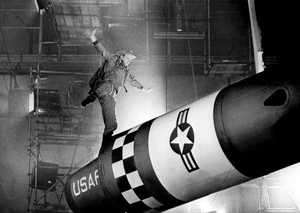
The 1964 political satire film Dr. Strangelove is among many cinematic influences for George Lucas.
Star Wars was born of George Lucas' concern for democracy in the United States of America.[327] Nominally supported by the United Nations after its founding in 1945,[328] democracy is commonly associated with liberal democracies' systems of governance that include respect for individual human rights, the rule of law, the separation of executive, legislative, and judicial powers, and free and fair elections.[329] Released on May 25, 1977 in the USA, Star Wars: Episode IV A New Hope was originally simply titled Star Wars and launches the original trilogy with a group of protagonists fighting an "evil Empire."[330] Lucas took advantage of the strong sense of good and evil in the aftermath of 1939–1945's World War II, fought between the Allied Powers—"good guys" including the USA who founded the United Nations after the war—and the Axis Powers of Nazi Germany, fascist Italy, and Imperial Japan.[331] While the Galactic Empire uses the visual motifs of Nazi Germany, the fictional regime was inspired by what Lucas terms the contemporary "American Empire" that pursued imperialist domination behind the veneer of liberating more countries.[330] However, the director intended to avoid explicitly addressing culturally "incendiary" political and emotional issues about which people would have already formed a prejudice of opinion[331]—Lucas considered this a unifying aspect of science fiction and historical fiction, though he preferred to call Star Wars a form of "fantasy," "space opera," or "mythology."[332]
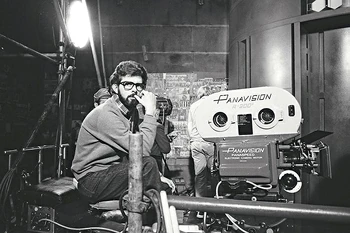
Lucas found himself passionate with and talented at filmmaking, which he considered to be a combination of his interests in art and anthropology.
While the original trilogy features the Jedi and rebels' struggle against the increasingly authoritarian Emperor Palpatine, his prequel trilogy features the fall of the Jedi and the transformation of the democratic Galactic Republic into the Empire. The conflict between good and evil is based on the mystical energy field known as the Force, which was Lucas' attempt to distill real-world religions.[330] Lucas believed that the essence of all religions is compassionate love and thus being able to "let go" rather than give in to greed,[333] and individuals need to accept that they have both good and evil inside them, and every person in every day can choose to be compassionate and love what is good or give in to greed and make unhealthy attachments; when a person feels they have some form of power, they become afraid to lose it and may fail to let go. Lucas added that regardless of whichever belief a person has, "God is love", and organized religions have a place in society to inspire people to be compassionate, but institutions can become corrupted, and "killing people in the name of God is wrong."[334] Lucas therefore used the Force, with the binary morality between good and evil, light and dark, as a narrative and symbolic tool in Star Wars as a "soap opera" about families at its heart, with wide-ranging societal repercussions in the choice between democracy and authoritarianism.[335]
George Lucas' philosophy and American democracy[]
Evolution and education[]
- "You try to keep people from being used or abused and listen to their grievances and try to do what is fair. Some people get upset because they want everything. Some people feel that they deserve to have everything, even though there's no reason for it. They just feel it's their right. That's one of the problems of a democracy. You get these individual voices that are very loud, and very dysfunctional. And if you cater to those voices, you end up with a very dysfunctional society."
- ―George Lucas
Defining humanity, Lucas said that human brains are capable of rationality and could "exchange information" through, for example, narrative art. In his view, the matter of humanity's extinction or survival depends on whether such information is accurate, and Star Wars operates on the premise that "we are both good and evil, and we have a choice."[326] Lucas considered democracy a human choice[336] and deemed the evolutionary adaptation of rationality to be God's blessing for humanity; for him, humans have a "duty" to improve education and use scientific inquiry to make sense of reality—being personally interested in the potential for neuro-anthropology to study the development of social systems, belief systems, and the psychological motifs that he claimed have been embedded in human stories for millennia[337]—and the best way to live is to help each other, not just morally or emotionally for the "pursuit of happiness" but also economically and existentially because the survival of humanity is always stake, comparable to how hunter-gatherer communities survived and then formed distinct societies and built cities.[338] Lucas lamented in 2012 that the dominance of capital and sensational mass media have been making American society more dysfunctional, antithetical to the values of democracy and compassion "that we supposedly stand for."[336] When asked by his friend and journalist Charlie Rose whether his ideal society of compassion is "democracy" or "socialism," Lucas called it "common sense."[339] Lucas believed that humanity's emotional underpinnings have not changed, though the intellectual contexts have.[337] According to Lucas, although his films are largely shaped by his experiences of society from the 1950s to 1970s, Star Wars could be seen as a form of "psychological archaeology" that explores from a humanist perspective the "ageless" and "universal" theme of conflict between humanity's intellectual-technological advancements and humanity's reliance on the "same" emotional driving points—aside from "the only other two universal themes" of violence and sex.[326]

George Lucas filming American Graffiti (1973). His next project was Star Wars.
Lucas opined in his conversation with Sinologist Orville Schell that the American media has a tendency to uncritically "devour" information—the filmmaker believed that one problem of democracy was its vulnerability to cater to loud, irrational, and greedy voices, which would prevent society from achieving consensus and render it dysfunctional. The director emphasized his belief that societies cannot exist without common faith. He also acknowledged that his notion that the media should be mindful of their social responsibilities has been taken to the extremity of censorship in Communist regimes such as the Soviet Union, which collapsed in 1991, and the People's Republic of China.[326] Speaking with Charlie Rose in 2015, Lucas nevertheless expressed appreciation that filmmakers he knew in Soviet Russia had creative freedom to make any film as long as it did not cross political redlines while an American filmmaker was bound by studios that wanted every production to be profitable—Lucas hated to be told what to do[335] and greatly admired Soviet experimental cinema prioneered by Sergei Eisenstein in the 1920s. Speaking with journalist Richard Corliss in 2006, Lucas said wanted to experiment with moving images after Star Wars and said that his "heart" was with the non-mainstream, European government–subsidized films of Jean-Luc Godard and Federico Fellini, and he thought of his Star Wars earnings as his "own little government subsidy."[340]
When speaking about the themes of Star Wars in light of 2004's US presidential election, Lucas said that the "current mess" was partly due to a lack of proper studying of the humanities and interdisciplinary learning, the "why" that storytellers like William Shakespeare explore when inviting people to study the emotional and psychological motives behind conquerors, whether it be Alexander the Great, Julius Caesar, Napoleon Bonaparte, or Adolf Hitler. Lucas wanted American education to cultivate "emotional intelligence" and return to the methods of Plato and cobblers' apprentices before the Industrial Revolution[341]—to teach the process of how to learn rather than just feeding information[334] and to help human brains adapt to "human nature's" dichotomy between being "self-absorbed," which he compared to cancer cells, and being a "communal creature," comparable to typical cells that cooperate to keep the larger organism alive.[337] Lucas' introductory words on Edutopia, the website of the George Lucas Educational Foundation, declares that "education is the foundation of our democracy."[342] After retiring from Lucasfilm, thinking that the social status of narrative art had dwindled in the 20th century, Lucas dedicated his public efforts on the Lucas Museum of Narrative Art, set to open in Chicago in 2026.[343]
20th century mythology[]
- "History is fiction, but people seem to think otherwise. The thing I like about fantasy and science fiction is that you can take issues, pull them out of their cultural straitjackets, and talk about them without bringing in folk artifacts that make people get closed minded. […] By making the film "about" something other than what it's really about. Which is what mythology is, and what storytelling has always been about. Art is about communicating with people emotionally without the intellectual artifacts of the current situation, and dealing with very emotional issues."
- ―George Lucas

Lucas' 1971 film THX 1138 features a society that is tightly controlled without people's consent.
Born in 1944 and raised in Modesto, California, USA and having grown up on Western genre films and the stories of Buck Rogers and Flash Gordon, then spending much of his youth racing cars until a near-death accident before studying anthropology and filmmaking, George Lucas' Star Wars serves, from the creator's point of view, as a modern mythology[335]—according to Lucas, mythology is narrative art that broadly and emotionally appeals to society, and it is required for people to be kept connected and for a culture's values to be passed on, rather than just individual expression for its own sake.[334] Lucas grew up in 1960s San Francisco and has been a "very ardent patriot" of America and a believer of democracy.[336] When he started working on Star Wars, he thought that America no longer had contemporary folklore for young people to enjoy.[344] Lucas asserted in an interview in 2005 that most stories have been made for adolescents as they are more open-minded than adults. In his mind, as "old stories" about "timeless" themes need to be retold to new generations in ways that resonate with them, narrative art is akin to raising children: they need to be reassured that they are part of a community who share "good" and "bad" aspects of human nature, and they need to be taught the consequences of acting on some of those notions, rather than learn everything "the hard way."[331] Speaking with journalist Hank Stuever in 2015, Lucas defined art as the communication of emotions; "you get a feeling about something, you get knowledge about something, but you don't know why […] you gotta go see it."[345]
Lucas wanted to explore the underpinning psychological motifs that have been told throughout human mythologies across historical societies and religions. Not only drawing from his interest in narrative literature, popular fiction, and experimental cinema but also influenced by his Christian Methodist upbringing and Buddhist ideas, Lucas was additionally informed by the writings of anthropologist Carlos Castaneda and comparative mythologist Joseph Campbell in making Star Wars as an exploration of what he consistently throughout the decades termed "psychological archaeology."[335][346] Lucas became friends with Campbell in 1984, inviting him to Skywalker Ranch to give talks, which informed Star Wars composer John Williams among many others about the crucial role of mythologies such as Star Wars in the development of societies from the Neolithic Revolution to the Space Age. The ranch also hosted journalist Bill Moyers' 1988 documentary television series The Power of Myth with Campbell and another TV interview with Lucas about the mythology of Star Wars in 1999, exploring the role of storytelling and motifs of the mythological "hero's journey."[347]

Francis Ford Coppola, R2-D2, and George Lucas
Lucas said that Star Wars belonged to the "heroic myth" tradition.[334] Originally, Lucas and his filmmaker friend Francis Ford Coppola were collaborating on Apocalypse Now, a film about American democracy in the context of the country's then-ongoing war in Vietnam. Apocalypse Now was released in 1979 under the direction of Coppola, who fashioned the film after the serious manner of Joseph Conrad's 1899 novella Heart of Darkness, deviating from Lucas' wish to produce a satire akin to Stanley Kubrick's 1964 film Dr. Strangelove or: How I Learned to Stop Worrying and Love the Bomb.[327] Lucas thus focused on his personal fantasy project, writing a rough draft of Star Wars in 1974 following the success of his 1973 film American Graffiti. His draft describes the Empire as "America ten years from now," at a "turning point" of "fascism or revolution." "Nixonian gangsters"—referring to Richard Nixon, President of the United States from 1969 to August 1974—would have assassinated the Emperor and rigged an election to take power, starting "race riots" and helping rebel groups before imposing a "'total control' police state," firstly welcomed by the people who are frustrated with rampant criminality, then exploiting them with high taxes and utility and transport costs. Lucas's first theatrical film, 1971's THX 1138, is set in a dystopian consumerist society tightly controlled by robotic police.[348] His earlier short films included abstract tone poems, a montage on American race riots,[338] and a narrative film on freedom set at the Berlin Wall of East Germany.[349] Lucas had a documentary filmmaking background and preferred its spontaneous approach and experimentations with the medium.[340]
Changing reality[]
- "[…] while the psychological basis of Star Wars is mythological, the political and social bases are historical. I like to take things and strip them down, then use the model and build a different story on it. […] I was sitting around with a dozen reporters, and the Russian correspondents all thought the film was about Russian politics, and the Americans all thought it was about Bush. And I said, "Well, it's really based on Rome. And on the French Revolution and Bonaparte." It's shocking that these things get repeated through history. The same mistakes get made and the tension between democracy and tyranny is always the same. And we haven't figured out any way around it."
- ―George Lucas, in 2005
Lucas realized after THX's release that "being pessimistic doesn't seem to accomplish anything"[344] and instead wanted to make a light-hearted film that would appeal to the public[335] and "regenerate optimism" for young people who were apathetic to how America was "being ruined."[350] In particular, the filmmaker wished to make a "fairytale" for "twelve-year-olds" given the "dark" times of the Vietnam War and the American civil rights movement.[327] He read John Carter of Mars by Edgar Rice Burroughs and John Coleman Burroughs, James George Frazer's The Golden Bough: A Study in Magic and Religion, and fantasy books for inspiration in January 1974. Lucas was also influenced by a host of films in writing Star Wars, including Akira Kurosawa's Japanese period dramas and Fritz Lang's Metropolis (1927), Michael Curtiz's The Adventures of Robin Hood (1938), and Howard Hawks' Air Force (1943).[344]
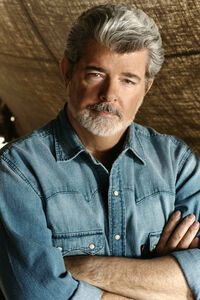
George Lucas
In 1977, Lucas stated that the Force "is a perception of the reality that exists around us,"[348] and in 1999's Star Wars: Episode I The Phantom Menace, Qui-Gon Jinn advised Anakin Skywalker that "your focus determines your reality."[3] He wanted to make a feature film with a bigger budget that involved soundstages, art directors, production designers and fulfilled the mythologizing role of American Westerns that he had grown up watching.[335] Lucas remarked in March 1999 that "one of the weird and more interesting things about Star Wars" was that it has been well-received across "many cultures" worldwide. Despite low expectations during the making of the first film, it was a major financial success while Lucas also retained creative and marketing freedoms with distributor 20th Century Fox. The entrepreneur fully owned and directed his own franchise company, Lucasfilm. He criticized corporations and especially the media of the United States for answering to nothing but the urge to make more money, which has in his view the effect of making people "disgusted" with their own culture and government and become cynical with "everything."[326] Speaking about a Frenchman he had met who claimed to watch Star Wars every week in 1997, LucasArts president Jack Sorensen commented: "I don't know if I want to say this in print, but I feel like Star Wars is the mythology of a nonsectarian world. It describes how people want to live. People all view politics as corrupt, much more so in Europe than here [the United States], and yet people are not cynical underneath—they want to believe in something pure, noble. That's Star Wars." Sorensen also thought it striking that the franchise's literary elements, while seemingly "uncommercial" and "subordinate to the purely cinematic elements" when Lucas was making his films, had become "the very qualities that seem commercial about it now."[351]
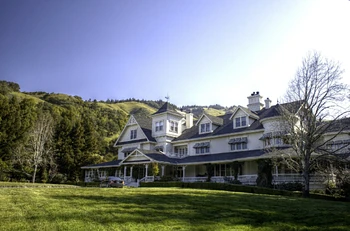
Skywalker Ranch, Lucas' studio
US President Jimmy Carter watched Star Wars alongside Rosalynn Carter and Egyptian President Anwar Sadat and Jehan Sadat on February 4, 1978, at Camp David,[352] where peace accords between Egypt and Israel were eventually signed in September. George Lucas, unhappy with writing and also stressed by directing, later hired Irvin Kershner to direct Star Wars: Episode V The Empire Strikes Back as he was impressed with Kershner's quick turnaround on the 1977 film Raid on Entebbe about Israel's operation in Uganda in the preceding year, and the Star Wars sequel was released in May 1980.[344] Lucas remarked in a conversation televised in 2002 with Carrie Fisher, who played Princess Leia Organa, that the "hero's journey" of Anakin Skywalker would involve him becoming "a bad person" through "very good intentions"—they alluded to a common opinion in the US at the time supporting "vengeance" for the September 11 terrorist attacks of 2001 that sparked the "war on terror" and how Lucas had originally titled 1983's Episode VI "Revenge of the Jedi" rather than "Return of the Jedi."[332] In 2010, George Lucas was invited to the launch of the UK charity Films Without Borders, which brought teenage filmmakers from Israel, Palestine, and Rwanda together, and advised the students that humans have always been telling the same stories for millennia but differ in the way they tell the stories, and good filmmakers entertain audiences in return for their time and money instead of directly preaching messages—"themes are always best unsaid," and the process of entertaining would then "hopefully" give insight into the audience's own lives and create dialogue across troubled divides.[353]
Echoes of history[]
Empire of liberty: a new republic, repressing Native Americans, and Nixon[]
- "And here's an interesting thing about democracy: if you don't treat it well, if you don't do your job, especially if you're our representative in the senate, in the parliament, or whatever, the whole thing can go awry, because if you're always bickering and not agreeing on things and doing the people's work—who elected you—a tyrant will come in and take over and do it for you because the people want to get the job done and they will tend to go where the person who's got the most leadership is."
- ―George Lucas

Carrie Fisher as Leia, rebel leader and princess of the people
According to a 2024 interview with the broadcaster Deutsche Welle, George Lucas intended Star Wars to be one movie about the adventures of Luke Skywalker and the tragedy of Anakin Skywalker. What became the prequel trilogy originated as a backstory that was constrained by the visual effects technology of the 1970s, and the middle of the Star Wars story evolved into three films.[349] Lucas told the TIME magazine in 2002 that this original trilogy is the story of "Princess Leia and her friends" waking up to the fact that the Republic was the Empire, a "sham" democracy that they must resist.[355] On Han Solo's initial dismissal of the revolution and acting as a mercenary and smuggler, Lucas said in August 1977 that he was just "a free-enterprise small businessman who is trading between systems without benefit of a proper license from the trade unions." The issue of smuggling "was really the result of the Empire, which has such stringent rules about tariffs, and the trade companies, which are so strong, so monopolistic. Most legitimate operators were squeezed out of the business." However, Han Solo did not consider the situation from a political perspective despite the Empire being the "Big Brother," instead treating the regime as any another obstacle.[348]
The original novelization of Star Wars published in 1976 included an excerpt from the "First Saga" of the "Journal of the Whills" that outlined the fall of the Republic with the "wise rule of the Senate and the protection of the Jedi Knights," using the parable of a tree that could "withstand any external attack" but "rotted from within;" with the help of "massive organs of commerce," Senator Palpatine was elected "President of the Republic" with the promise to reunite discontent people and "restore the remembered glory of the Republic," but he "was controlled by the very assistants and boot-lickers he had appointed to high office," with "governors and bureaucrats" overseeing a "reign of terror" using "the Imperial forces and the name of the increasingly isolated Emperor." The excerpt ends introducing a group of rebels wishing to restore the Old Republic and "cast the light of new truth" across an oppressed galaxy.[356] In early drafts of his film script, Lucas intended Star Wars to be akin to a saga documented by an observer known as the Whills, and the plot device later developed into the Force.[357]
Lucas described similar developments when speaking with Carol Titelman in August 5, 1977, on the history of the Star Wars galaxy as general notes for Lucasfilm: the Republican Senate had single four-year terms for its Chancellors, but senators was corrupted by intergalactic companies to extend the last Chancellor's term twice due to a crisis and made him Emperor for life; senators were concerned by bloated bureaucracy and rationalized that executive powers could control it, but the Emperor made Senate meetings shorter and less frequent and had actually made the bureaucracy "run amok" in the first place, having control of key bureaucrats through company money. Although "a little over half" of the Senate was not corrupted and tried to oust the Emperor through legal means such as impeachment, many of them mysteriously died, prompting the Jedi Knights to rally for the remaining senators. However, the Jedi could not restore order as they were betrayed and destroyed by Darth Vader.[348] When Lucas met Richard Marquand, Howard Kazanjian, and Lawrence Kasdan for a story conference in 1981, he explained the tragedy of Darth Vader, and that because the Emperor had been elected, "nobody knew" that he was a bad person and "Richard M. Nixon" was his name.[330]
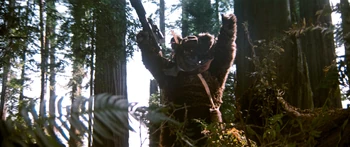
Lucas compared the Ewoks that defeated the Empire in 1983's Return of the Jedi to the Vietnamese who defeated the "American Empire."
Speaking with Hollywood director James Cameron in 2012, Lucas also compared the rebels and Ewoks' battle against the technologically advanced Imperial forces in Return of the Jedi with two cases of the "underdogs" against the "empire"—firstly, the "Viet Cong" that defeated American forces in the Vietnam War, and secondly, the founders of the United States that defeated the "English Empire" in America in the late 18th century.[358] Appearing in court in Calgary, Canada on a copyright claim about the concept of the Ewoks in 1990, Lucas testified that he was also informed by[359] the Coast Miwok people indigenous to Marin County, California, whose population inhabited the land around Skywalker Ranch until it was devestated by disease and displacement[360] brought by European colonists, like other Native American societies.[361]
Road from Rome: Caesar, Napoleon, and Hitler[]
- "The whole point of the movies, the underlying element that makes the movies work, is that you, whether you go backwards or forwards, you start out in a democracy, and democracy turns into a dictatorship, and then the rebels make it back into a democracy. That's one of the uber-issues that everyone is dealing with. You've got the personal issue of Anakin and his turn to the dark side, and his children bringing him back to being a human being, but the larger issue is the fact that you've given up your democracy. […] It came out of Nixon wanting to change the rules so that he could get a third term, and with that—I'm a big history buff—I was beginning to study Caesar. Why did the Roman senate give his nephew a dictatorship when they had gotten rid of Caesar? Why did they do that? After they had a revolution in France to get freedom, why did they create an emperor? I mean, why did they do that? Why did the Germans, after they had a democracy after World War I, turn it into a dictatorship? Why did they do that? That was my initial question 30 years ago. And I'm not really saying why as much as how it gets done, because it always gets done in the same way. And it's scary, the fact that the world has caught up to that theory."
- ―George Lucas, in 2005

Ian McDiarmid, who likened Palpatine to Slobodan Milošević, and George Lucas, who based the character on Augustus, Napoleon, and Hitler out of concern for American democracy under Nixon.
1999's The Phantom Menace launched the prequel trilogy, where Lucas intended to explore how democracies could be eroded and transition into dictatorships through democratic means rather than via coups or rebellions in the real world, paralleled with the story of a good person such as Anakin Skywalker turning into a villain—Darth Vader.[330] Upon the release of 2002's Star Wars: Episode II Attack of the Clones, TIME magazine writers asked Lucas about politics in Star Wars, considering Obi-Wan Kenobi's cynicism of political campaign financing to be an echo of US Senator John McCain's role in campaign financing reform; Padmé Amidala's idealistic plead in a deleted scene in the Senate calling the Military Creation Bill "a declaration of war," with violence begetting more violence and resulting in everyone losing their freedom an echo of United Nations Secretary-General Kofi Annan's pleads for the plight of the people of Palestine; Anakin Skywalker's realpolitik about a strong leader resolving the Senate's differences an echo of Roman Senator Brutus in his assassination of Julius Caesar. Lucas replied that he described himself a believer in liberal ideals of democracy and suggested a continuity between his films by emphasizing the role of Princess Leia and the Jedi in the original trilogy to overthrow the Emperor.[355] In 2005, actor Ian McDiarmid described the character of Palpatine/Darth Sidious as "totally irredeemable," motivated only in accumulating and exercise power for its own sake unlike the psychological complexity of Shakespeare's characters; McDiarmid instead likened Palpatine to the Serbian leader Slobodan Milošević, who was on trial for genocide, crimes against humanity, and war crimes in the former Yugoslavia.[362]

The 1935 Nazi film Triumph of the Will. Lucas worried for America's democracy, drawing on historical examples of dictators being voted into power when making Star Wars.
Although American politics during the Vietnam War served as a catalyst for writing Star Wars, Lucas cited three examples of what he believed to be the cyclical nature of history with respect to Palpatine's rise to power: firstly, Julius Caesar in the Roman Republic[330]—Caesar was voted "dictator perpetuo" and then usurped by fellow senators in 44 BC, leading to the rise of Augustus and his Roman Empire, which dominated Europe, north Africa, and west Asia for centuries.[363] Secondly, Napoleon Bonaparte in revolutionary France[330]—following the collapse of the ancien régime in 1789, legislators allowed his coup as "Premier consul" in 1799 and then appoint himself "Emperor," with Bonapartist France dominating 19th century Europe.[364] Thirdly, Adolf Hitler in the German Weimar Republic[330]—the German Empire collapsed in 1918 following World War I and the Republic voted Hitler's Nazi Party into parliament and government in 1933, with Chancellor Hitler enacting emergency powers in the same year that resulted in his elevation as "führer," the Holocaust genocide of Jewish people, and World War II until Nazi Germany's defeat in 1945.[365]
Charisma and tyranny[]
In another Attack of the Clones deleted scene, Count Dooku tells a captive Padmé Amidala that "the democratic process in the Republic is a sham" and the "incompetent" Chancellor had allowed the bureaucracy to become stronger and the Republic's "cult of greed" would eventually lose "any pretext of democracy and freedom." Amidala re-affirms her dedication to the Republic and calls Dooku's Separatists "not government that has been bought out by business" but "business becoming government!"[330] The film's novelization, written by R. A. Salvatore based a script of Lucas', even includes Dooku telling the business leaders joining the Separatists that their alliance has an "absolute commitment to capitalism" regarding lowering taxation and tariffs, promising "complete free trade" by eventually abolishing "all trade barriers."[366] Lucas decided to replace the scene with Dooku speaking to a captive Obi-Wan Kenobi instead, showing the irony of Dooku sharing most of the Jedi's view that the Senate is corrupt and ineffective and also telling the truth about the Republic being controlled by Darth Sidious—yet Kenobi does not believe Dooku because the fallen Jedi asks him to join him in overthrowing Sidious and taking power by themselves.[367]
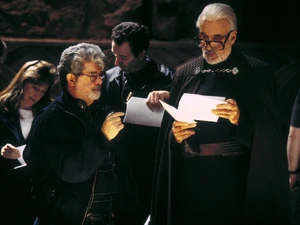
George Lucas and Sir Christopher Lee
Tony Keen wrote in 2012's Star Wars and History about the saga's connections with the fall of the Roman Republic and compared Padmé Amidala's rebuke of Anakin Skywalker's faith in a benevolent dictator and her belief in a democratic republic with the Roman politician Cicero, who criticized Julius Caesar's dictatorship, supported Caesar's heir Octavian against Mark Antony, and was condemned to death by Antony. The latter and Cleopatra, Queen of Egypt, warred against Octavian as lovers until their deaths, allowing Octavian to rule as the first Roman emperor as Augustus. Although contemporaneous Roman records did not distinguish the "Republic" from "Empire," nor did contemporaneous records name the "Weimar Republic" as a separate polity when Nazis came to power in Germany, Keen highlighted that Hitler used the Reichstag fire as pretext for suspending civil liberties while Napoleon Bonaparte organized a formal coronation of himself, similar to Palpatine's claim of a "Jedi plot" and declaration of the Galactic Empire.[368]
Writing in the same book, Kevin S. Decker compared the charisma—and thus capacity to gain and maintain popular support as an apparent "political idealist"— of Count Dooku, whose Sith name was Darth Tyranus, to the ancient tyrants Kypselus of Corinth and Pisistratus of Athens in the 7th and 6th centuries BC, who both seized power by appealing to marginalized people; "demagogues," according to Aristotle. Decker further compared the Galactic Republic's first Chancellor, Tarsus Valorum[368]—who originated in Star Wars Legends material[369] but has since been introduced to the current canon[8]—to Solon, who laid the foundation of democracy by breaking down ancient divisions and developing a rule of law. The author noted that in contrast, the fall of Roman republican practices and also the Roman Empire, which had adopted Christianity given the enduring appeal of Jesus, left many European monarchies that sought Christian-based legitimacy and power deals among their royal courts.[368]
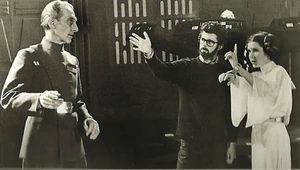
Peter Cushing, George Lucas, and Carrie Fisher
Within this medieval context, Decker stated that the Sith Code[368]—written by David Gaider as a Nazi-inspired perversion of the Jedi Code from Legends material,[370] and both codes have since introduced been in the current canon[145][371]—would instruct adherents to be a "manipulative courtier" of a monarch, yet Darth Sidious and Tarkin go beyond this framework as the Italian Renaissance author Niccolò Machiavelli advised, obtaining power by being feared rather than loved; achieving effective means even at the cost of Christian virtues. Tarkin expressed disdain for the Jedi Code and implemented a rule of constant militarization and fear under the Empire, while Sidious used coercion and cruelty—much like Qin Shi Huang, the first of the Chinese emperors who ruled for over two thousand years until the Republican Revolution in 1912—though the Sith Lord did not follow Machiavelli's advice to refrain from indiscriminate cruelty and ultimately fails. Decker also added that the conquests of one man could only be enabled by the public, comparing Communist Russia and China's personality cults of Joseph Stalin and Mao Zedong to the Star Wars galaxy's "conditions of cultural decadence, political amoralism, and unrestrained, all-consuming commerce and industry" in the rise of the Empire; the moral leadership of Bail Organa, Mon Mothma, and Leia Organa follow Machiavelli's praise for Aristotle, Cicero, and John of Salisbury's ideas and an ideal republic of a free contitution for citizens of virtue to advance the common good.[368]
Chinese trade and empire[]
Revolutions of culture[]
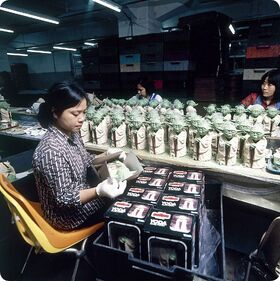
Star Wars toys made by a Hong Kong company in Guangdong being packaged in Hong Kong for export to the US in 1982.
Mao Zedong's Cultural Revolution was a period of mass societal upheaval—and restrictions on Western imports such as Star Wars—in the People's Republic of China that began to wind down with Mao's death in 1976.[372] Nevertheless, the Chinese Communist Party's newspaper, the People's Daily, criticized the original Star Wars film on July 24, 1978 as an illusory fairyland that reflected Americans' dissatisfaction with reality[373] and added that the supposedly corrupting downfall of capitalist culture was exemplified by the visual effects expenses on Star Wars and Steven Spielberg's Close Encounters of the Third Kind,[374] made by Lucasfilm's visual effects company Industrial Light & Magic.[344] The Soviet Union's Literary Gazette in Moscow likewise disparaged the film on September 7, 1977, describing it as an unsurprisingly profitable horror film where America's "mass audience is ready to bite at such pieces of “art” in order to, when leaving the movie theater, see that things outside are fairly quiet…"[375] From 1978, Chinese authorities began promoting science fiction literature in an effort to rehabilitate scientific research[373] until the campaign against "spiritual pollution" such as science fiction in 1983.[376]
Although the prequel trilogy released in China and inspired a generation of Chinese Star Wars fans,[376] the original trilogy was not officially released in China's cinemas until June 2015. In the late 2010s, Lucasfilm made brief forays into officially collaborating with Chinese companies via Disney in the late 2010s with Shanghai Disneyland, the ill-fated Star Wars: Galactic Conflict video game, and the web-novel The Vow of Silver Dawn.[372] In contrast to mainland China, Star Wars was screened in Hong Kong, a colony of the British Empire that not only engaged in entrepôt trade between the West and Communist China but also boasted a booming plastics industry, including manufacturing the first Star Wars figures during the 1970s and 1980s for England's Palitoy company and the American Kenner company.[377]
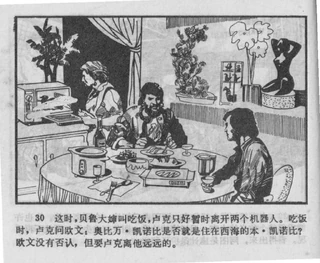
A panel of Luke Skywalker's family in a Guangdong comic adaptation of Star Wars.
When meeting with Chinese Vice Premier Geng Biao in May 1980, President Carter invited Geng to watch The Empire Strikes Back with the first family. Carter told the press that "Geng Bao was on the edge of his seat all the way through the movie. Fortunately, he did not ask me for any of the weapons he saw in the movie"—they shared concerns over the Soviet Union's invasion of Afghanistan and Vietnam's invasion of Cambodia and discussed military cooperation as part of a new relationship between the US and China.[344] In the same year, Chinese officials in Guangzhou City of the Guangdong province, which neighbors Hong Kong, obtained a copy of 1977's Star Wars and summoned the artist Song Feideng (宋飞等) to a private viewing. He was tasked with illustrating a lianhuanhua picture book to promote scientific achievement in China. Song found the film exciting and happily received payment for his work, which Zhou Jinzhuo (周金灼) wrote in adaptation of the film and sold quickly under the Guangzhou branch of the Popular Science Press (科学普及出版社). It remained one of the few Star Wars material in mainland China alongside pirated videos and some broadcasts by local television stations in the late 1980s.[373][378][379]
Star Wars lianhuanhua were published by children's book publishers across China, including the regions of Yunnan in the southwest, Anhui in the east, and Inner Mongolia in the north.[380] In October 1980, in Changsha City of the Hunan province north of Guangdong, the local branch of the People's Press commissioned Star Wars novellas under the editor and veteran translator Tang Yinsun (唐荫荪) with translators Zhang Ruoheng (张若衡) and Chen Yuequan (陈月泉), firstly adapting Donald F. Glut's novelization of The Empire Strikes Back and then the original Star Wars with other staff. In October 1986, the publisher started printing its adaptation of Return of the Jedi but was performing poorly, and it switched to printing adaptions of the English erotic novel Lady Chatterley's Lover, which was hugely popular, banned on the charge of obscenity, and led to the publisher being sanctioned.[381] Around the same time, manufacturing of Star Wars toys in Hong Kong began relocating to Guangdong amidst China's economic reforms and socio-economic uncertainty over the impending transfer of sovereignty over Hong Kong to the People's Republic of China in 1997.[377]
Hong Kong: city on the edge[]
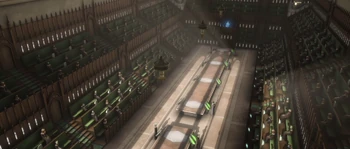
The Separatists in The Clone Wars and the British Empire—parliamentary democracy and organs of commerce
While local industries declined, Hong Kong refocused on servicing as an international financial center, being situated at the edge of both Western and Chinese influence.[377] In Star Wars and History, Michael Laver compared the nationalization of the Dutch and British East India Companies with the Galactic Empire's absorption of the Trade Federation, stressing the giants of commerce could outlive their usefulness to their respective imperial metropole. Katrina Gulliver also wrote in the book that London, as the world's premier financial center and metropole of opportunity in the heyday of the East India Company, was recognized as a modern version of the past dominant cities of Babylon, Jerusalem, and Rome, developing technological and economical innovations fit for empire hand-in-hand with the widely influencial Westminster model of parliamentary democracy. Gulliver added that London's leading status passed to New York and the United States in the early 20th century, in contrast to the long-term dominance of Coruscant as capital of the Star Wars galaxy and Republic.[368]
Further back in time and closer to Hong Kong, Laver's essay in Star Wars and History compares Tatooine and Cloud City in their capacity as ports on the galaxy's political and economic fringe with southeastern Chinese ports such as Amoy (Xiamen) and Canton (Guanzhou). They were geographically far from China's capital city of Beijing, and piracy thrived in southern China during the eighteenth and nineteenth centuries. In the 17th century, pirate-admiral Zheng Zhilong and his family's competed with the collapsing Ming and rising Qing dynasties of China—likened to the fragile Galactic Republic—as well as a Edo Japan and the Dutch East India Company (VOC) in Formosa (Taiwan), which parallel Lando Calrissian as a pirate, Cloud City's Baron Administrator, and rebel general. Laver also compared the Trade Federation's model of having its own trade fleet with the VOC and the British East India Company as "states within a state" away from the European metropole in the 17th century; just as Viceroy Nute Gunray oversaw the blockade of Naboo, the VOC imposed many blockades on rival imperial powers such as Portugal and Spain in Goa, Macau, and Manila in southeast Asia, while the East India Company was commissioned in England as Spain lost its war in Europe and the company lobbied Parliament to maintain its monopoly of trade in India, eventually incorporating the land as the heart of the British Empire.[368]
According to Laver, endemic corruption and a "divide and conquer" policy relating to the Dutch and British imperial powers also mirror the state of the Galactic Republic and the Trade Federation's failure, in the case of the Naboo and the Gungans, to dominate the populations separately. The author stressed that in terms of socioeconomic and political ramifications of corporate barons' ruthless pursuit of profit, the Trade Federation's use of military force to advance economic interests most clearly reflects British imperialist companies' Opium Wars against Qing dynasty China, forcing the opium trade through Canton by beginning the first of many "unequal treaties" with, among other stipulations favoring British merchants' convenience of trade in 1842, the ceding of Hong Kong Island to Queen Victoria of Great Britain.[368] A special pack of Star Wars action figures celebrated the transfer of sovereignty over Hong Kong to the People's Republic of China—under the Sino-British Joint Declaration registered at the United Nations—on July 1, 1997.[382]
Slavery and apartheid[]
- "The effect of war on the common people is something that Dave and I wanted to explore from the beginning and George really liked the stories where we got into that. It speaks to what's happening in our world today and I think it gives some emotional reality to the battles that makes us care about the outcomes because the lives of the innocents are hanging in the balance."
- ―Henry Gilroy, speaking in 2008 about the Ryloth trilogy

Peace between the Talz and Pantoran peoples in "Trespass."
Named the "Grand Army of the Republic," the fictional clone forces share its name with the United States' Grand Army of the Republic organization of veterans who had served in the American Civil War against the seceding slavery-based Confederate States[368]—the fictional Separatist state was identified as the "Confederacy of Independent Systems" in Star Wars Legends material,[384] which was later confirmed by the 2010 "Sphere of Influence" episode of the Star Wars: The Clone Wars television series, created by George Lucas.[112] For the 2009 "Trespass" episode of The Clone Wars, focusing on the Pantorans' war against the Talz, voice actor Brian George's performance as Chairman Chi Cho drew on "some of the uglier voices of the South African apartheid era" that only ended in the 1990s and the "venom and hatred that we used to hear on the news every night." George also likened his character's hatefulness to ethnic cleansing in the former Yugoslavia, the 1994 Rwandan genocide, the Darfur genocide between 2003 and 2005, and tragically, many more.[385]

The cost of war in The Clone Wars' Ryloth arc, partly based on the tragedies of Afghanistan
Henry Gilroy wrote the 2009 Ryloth trilogy of The Clone Wars while thinking about Afghanistan, particularly on how it was invaded by Soviet Russia and the United States supplied the Afghan mujahideen with weapons to counter the Soviets, and some of the Afghans eventually fought American forces in another war that started in 2001 as part of the war on terror. The first and second episodes, "Storm Over Ryloth and "Innocents of Ryloth," were partly based on battles of the Second World War.[386] According to lead character designer Kilian Plunkett, Twi'lek culture was based on the north African nations of Algeria and Morocco.[387] The writers took inspiration from the French Revolution for the third episode, "Liberty on Ryloth," which also introduced Cham Syndulla. The character was changed from a Separatist agent lying to his people to a freedom fighter to better suit the plot, and, given that George Lucas had insisted that Twi'leks speak in French accents, executive producer Dave Filoni referred to him as the leader of the French Resistance of the Second World War.[388] Catherine Taber, who voiced Numa in the second episode, thought that the history of the Twi'leks shared a cultural thread with the Irish people.[389]
In the book Star Wars and History, Paul Horvath and Mark Higbee compared the economic basis of the Star Wars Confederacy's leadership—battle droid manufacturers such as the Trade Federation—with the economic basis of the American Confederacy—cotton plantations reliant on enslaved labor. Economic interests, coupled with political change—either the despotic Palpatine's rise as Chancellor of the Republic in Star Wars or the anti-slavery Abraham Lincoln's election as President the United States in 1860—contributed to the outbreak of civil war, with the summary executions of Jedi echoing the Confederate massacre at Fort Pillow of surrendering Black US soldiers. The Galactic Empire's promises of peace, violated particularly by the oppression of non-human species until the galaxy's liberation by the Rebel Alliance, was also compared with the post-Reconstruction decades of America's nadir of race relations and the struggle of modern American civil rights campaigners.[368]
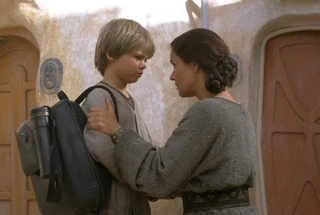
The tragedy of Anakin Skywalker
Paul Finkelmen wrote in Star Wars and History that bondage existed in various forms throghout human history, from legal forced labor and concubinage in ancient Mesopotamia; descriptions in the Bible; and ancient Greece and Rome when limited democratic enfranchisement existed, to transactional chattel slavery in the transatlantic slave trade; state institutions of serfdom, gulag systems, and concentration camps; and human trafficking in the modern era. Finkelmen compared slavery's role in separating affected family members with the emotional toll of Anakin Skywalker having to leave his still-enslaved mother behind on Tatooine at a young age, akin to American abolitionist Frederick Douglass' childhood, with Anakin having to carry emotional scars that ultimately prevent him from fulfilling his duties as a Jedi. Finkelmen also compared Luke Slywalker's sense of being held back by his family on Tatooine with Abraham Lincoln's restrictive childhood. Although Tatooine, a world "beyond the line" of Western civilization yet one where Padmé Amidala is shocked to find slavery given the Republic's outlawing of slavery, and particularly Jabba's Palace evokes Orientalist connotations of moral corruption and sexual exploitation in Mali, Ottoman, or Indian empires, Finkelmen added that Leia Organa's slaying of Jabba the Hutt echoes the Haitian Revolution in the 1790s, where the "slave" became the agent of their own destiny and massacred their "masters." Highlighting enslavement being the first listed human rights violation in 1948's Universal Declaration of Human Rights in the context of pan-European German extermination camps and slave labor battalions and pan-Asian Japanese internment camps and forced prostitution from the early 1930s to 1945, Finkelmen's analysis identified the clone troopers and stormtroopers also as enslaved soldiers and brainwashed cult members, with mindless droid armies being the "ultimate slaves," enforcing pan-galactic bondage of certain despots over others.[368]
Feminism[]
- "I think [Padmé] embodies the true meaning of feminism in my understanding of it. It's about having access to all the same things but then making decisions from your particular point of view…[Padmé] has been a leader of many people, but rather than being consumed with the thirst for power…she stays true to her compassion and her belief in democracy and in humanity…"
- ―Natalie Portman, speaking during the filming of Revenge of the Sith in 2003

Natalie Portman as Padmé Amidala, Queen of Naboo
While filming in 2003 for Star Wars: Episode III Revenge of the Sith—the final installment of the prequel trilogy which was released in 2005—Padmé Amidala's actor, Natalie Portman, said that her character embodies "the true meaning of feminism in my understanding of it" in accessing "all the same things" while making her own decisions and leading many people while remaining steadfast to her values of compassion, democracy, and belief in humanity.[390] In 2012's Star Wars and History, Janice Liedl compared Queen Amidala's fight for her people's freedom to Queen Boudicca, who led the Celtic Britons' revolt against the occupying Romans. Janice Liedl and Nancy R. Reagin added that women have been "integral to every modern revolution," likening the critical leadership roles of Princess Leia Organa and Ahsoka Tano—a protagonist of Star Wars: The Clone Wars—with actions of real-world women that could be considered "unfeminine," such as the teenage Joan of Arc leading the French to end the English Siege of Orléans in 1429; Charlotte Corday's assassination of the influencial writer Jean-Paul Marat after the September 1792 massacres of the French Revolution; the Irish revolutionary Constance Markievicz's election to the UK Parliament in 1918 and the Irish Republic's first Dáil Éireann assembly in the following year; and Dora María Téllez's becoming a military leader and spokesperson of the Nicaraguan Revolution in 1979.[368]
Liedl and Reagin further noted that a hairstyle worn by woman supporting the Mexican Revolution of 1910–1920 also helped inspire Princess Leia Organa's iconic hairstyle in A New Hope, and the 1830 French Revolution painting Liberty Leading the People features a woman, Marianne, symbolizing France and liberty. Liedl further wrote that Padmé Amidala's funeral and the palpably "powerful influence" on those who shared her ideals of the Republic echoes the funeral of Hawaiian Queen Liliʻuokalani, associated with the indigenous culture of Hawaii following the islands' settlement by the United States. The historian also remarked that Princess Leia Organa's "hands-on role" reflects the leadership of Queens Elizabeth I and Elizabeth II during the Anglo-Spanish War and the Second World War, respectively.[368] Feminism remains a pertinent theme in Star Wars films beyond George Lucas' time in Lucasfilm.[391]
"Mutually assured destruction" and the war on terror[]
- "Fear is the path to the dark side. Fear leads to anger; anger leads to hate; hate leads to suffering."
- ―Master Yoda
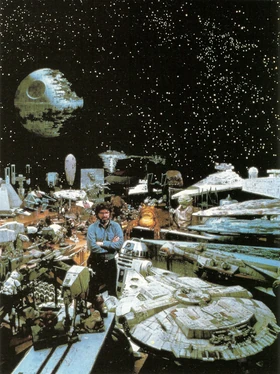
"Fear will keep the local systems in line. Fear of this battle station."—Grand Moff Tarkin in A New Hope
The Pacific Theater of the Second World War ended in 1945 with Imperial Japan unconditional surrender following the Allied Powers' invention of the atomic bomb and the US' two detonations over Hiroshima and Nagasaki. With the Soviet Union's first nuclear bomb test in 1949, the Communist victory in the Chinese Civil War later that year, and the Soviet launch of Sputnik in the Space Race in 1957 fuelled worries that a nuclear arms race between the Soviet and American superpowers would lead to mutually assured annihilation, reflected in American films such as Stanley Kubrick's 1964 Dr. Strangelove or: How I Learned to Stop Worrying and Love the Bomb,[368] which influenced George Lucas.[327] Writing in 2012's Star Wars and History, Lori Maguire noted Lucas' dislike of US President Nixon: despite the 1970s' détente with the Soviet Union led by Nixon and advisor Henry Kissinger, revelations about dishonesty over the Vietnam War from Lyndon B. Johnson's presidency, Nixon's Watergate scandal, and secret bombings of Cambodia undermined public confidence in the US government, and the Death Star in Star Wars' original trilogy resonated with the Cold War reality at the time.[368]

The Mandalorian mural inspired by Picasso's Guernica.
When US President Ronald Reagan proposed a space-based missile defense system called the Strategic Defense Initiative in 1983, Senator Ted Kennedy criticized this "Star Wars scheme" as "a trip wire for nuclear war" based on a "preposterous" romanticization of the American West. The "Star Wars" nickname was then popularized by the media[368] despite Lucasfilm requesting news bureaus not to.[344] In response to this, Nute Gunray in The Phantom Menace had his name derived from Reagan's.[392] A second inspiration for Nute Gunray was the American congressman Newt Gingrich, whose prominence during the Republican Revolution in 1994 influenced George Lucas while he was drafting The Phantom Menace. Lucas conceived the Trade Federation's motives and characterization as a reflection of contemporary political upheaval, with Gingrich's "Contract with America" serving as a particular touchstone. Lucas also named the Trade Federation's representitive Lott Dod after the Republican Senate leader Trent Lott.[393]
The US Space Force was founded in 2019 and began developing the Golden Dome missile defense system in 2025 primarily to counter China.[394] Maguire noted that fear had been used as an effective weapon in war, such as fascist German and Italian forces' bombing of Guernica in 1937 to support Francisco Franco in the Spanish Civil War.[368] The 2010 Season Two episode "The Mandalore Plot" of The Clone Wars and the 2013 Season Five episodes "Shades of Reason" and "The Lawless" feature cubist murals of Mandalorians killing Jedi, which were inspired by the artist Pablo Picasso and specifically Guernica, painted in response to the bombing of that Basque town.[395][396] Maguire also noted that fear could be used to start wars, such as the US and UK's claims of weapons of mass destruction in Iraq as rationale for the 2003 invasion during the war on terror.[368]
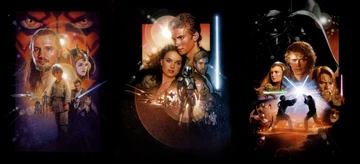
The prequel trilogy was conceived during the Vietnam War but Lucas also compared the story to his concerns for American democracy during the Iraq War.
Lucas acknowledged at the Cannes Film Festival in 2005 that the prequel trilogy's tale of democracy's collapse is comparable to the United States' then-ongoing war in Iraq,[354] and according to journalist Maureen Dowd in 2009, Lucas also compared Anakin Skywalker to George W. Bush who oversaw the war as US President and the role of the mentor, Emperor Palpatine, to Bush's Vice President, Dick Cheney.[397] However, Lucas had clarified in 2005 that he had written the prequel story during the Vietnam War, with concerns about the Kennedy family and President Nixon and his worry that democracy in America is vulnerable—he believed that politicians' inefficiency prompts voters to elect charismatic "tyrants" who promised to "get the job done."[354] In his 1999 interview with Schell, Lucas had said that "a benevolent despot is the ideal ruler" to "get things done," with the caveat that "power corrupts" and only "a big human" could overcome power abuse.[326] William J. Astore wrote in 2012's Star Wars and History that the United States was effectively conflicted between the roles of benevolent Jedi—some American units were praised as "Jedi" for their service the wars against the Iraqi despot Saddam Hussein—and imperialist Sith, given the civilian casualties and collateral damage incurred during both the Iraq War and the then-ongoing war in Afghanistan.[368] The conflict ended with the botched American-led withdrawal at Kabul and Afghanistan's fall to the Taliban regime in 2021.[398]
Beyond George Lucas[]
Transition to Disney[]
- "And George, you know, his increasing need to use politics as a way to express some of his frustration with what was going on in the world is what comes through in the Star Wars [prequels]. And, you know, fans can look at that and determine whether or not they connected with that or not, but certainly George did. That was really important to him. And, you know, that was his prerogative. It was his story. He was using that in a way that was personally meaningful to him."
- ―Kathleen Kennedy, in an interview about her approach to encouraging creative freedom in Lucasfilm following Lucas' departure

George Lucas (center) in 2012, at the Tuskegee Airmen convention
Just as Lucas had created Star Wars to address themes about human societies without explicitly referencing issues on which audiences have formed their own prejudices of opinion,[331] the filmmaker had ironically become frustrated with Star Wars fans on the Internet who constantly "yell" about "what a terrible person you are" after developing their own prejudices of opinion on what Star Wars should be.[400] Following Lucasfilm's release of the 2012 film Red Tails about the Tuskegee Airmen serving in World War II, George Lucas sold his company to The Walt Disney Company so that Lucasfilm could continue running Star Wars while he himself focused on experimental filmmaking beyond the "white slaver" mainstream of the Hollywood industry[335] that did not believe films starring Black people had a profitable market outside the United States.[401] Lucas had been planning to return to the independent filmmaking of his college days since at least 2005.[337]
The book Star Wars and History was published in late 2012, five years after George Lucas had read a copy of Kevin S. Decker and Jason T. Eberl's Star Wars and Philosophy, which was published independent of Lucasfilm, and asked Jonathan W. Rinzler—the author of The Making of Star Wars: The Definitive Story Behind the Original Film—to arrange a similar volume of essays by relevant academics on Star Wars' historical influences. While the essays were written from the perspectives of their respective authors, they were based on back-and-forth communication with Rinzler as an intermediary with Lucas, who listed various subjects that "became the nucleus for all the essays" and set aside some that were more concerned with political science for a potential future book.[402] A 263-page unpublished book attributed to Lucasfilm and the Wiley publishing house is listed under the title "Star Wars Politics" and dated April 15, 2013 on Google Books.[403]
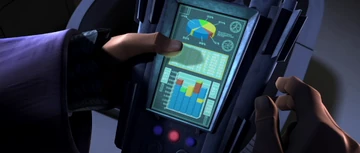
Still of Senator Amidala urging Senator Organa to make a speech about galactic finance in "Pursuit of Peace," an episode that George Lucas wanted to address banking deregulation in light of the Global Financial Crisis.
In January 2013, the Obama Administration rejected a 34,435-strong public petition for beginning construction on a Death Star because the administration was concerned with budget deficits and "does not support blowing up planets," instead listing the alternative US space-based science, technology, engineering, and math-related achievements and developments in both public and private sectors.[404] The Season Three episodes "Heroes on Both Sides" and "Pursuit of Peace" of The Clone Wars aired in 2010, addressing banking deregulation at George Lucas' behest[405]—the production schedule of the television series meant they were written three years prior[406]—in 2007, when the Global Financial Crisis occurred and laid the ground for democratic backsliding worldwide.[407]
Since George Lucas' departure from Lucasfilm, the company had been directed by Kathleen Kennedy, a film producer who had worked closely with Lucas and Steven Spielberg. Kennedy encouraged artists of Star Wars to make their work personal, noting the earnest authenticity of Lucas and Spielberg's films and particularly Lucas' "increasing need to use politics" in the Star Wars prequels to express his ideas in light of real-world events.[399] Kennedy appreciated the global leverage that Disney has provided for Lucasfilm, which was able to make official in-roads into China and Russia in the 2010s.[408]
Humanitarian efforts[]
The 501st Legion was founded in 1997 as a Star Wars fan and volunteer group in support of charitable work worldwide.[409] Other groups include the Rebel Legion and the Mandalorian Mercs.[410] Lily Meszaros—who played the Jedi Council member Stass Allie in 2005's Revenge of the Sith—fled from Rwanda following the genocide in 1994 to Australia. She set up the Rwandan Orphans Assistance Response to provide aid for children in Rwanda,[411] raising funds partly by signing Star Wars autographs.[412]
In 2014, Disney and Lucasfilm created the Star Wars: Force for Change initiative in partnership with J.J. Abrams' Bad Robot Productions to support UNICEF, the United Nations Children's Fund, during the production of the 2015 sequel trilogy movie, Star Wars: Episode VII The Force Awakens. The campaign benefitted the UNICEF Innovation Fund, which was founded by Disney/Lucasfilm and the government of Denmark to support new Innovation Lab projects. Between May 21 and July 25, Star Wars fans were asked to contribute in exchange for a chance to appear in Episode VII, and the partnership raised over $4.2 million dollars from 125 countries in addition to Disney's donation of $1 million.[413] In 2016, UNICEF and Force for Change delivered the Myanmar Social Innovation Lab[414] and a digital care protection system in Cambodia.[415]
In April 2015, Lucasfilm's Force for Change was announced as a presenting sponsor with UNICEF USA for the UNICEF Kid Power program, which encouraged children in the US to be active and raise funds for nutrition programs for malnourished children around the world.[416] Ashley Eckstein—who voiced Ahsoka Tano in the television series The Clone Wars and Star Wars Rebels—took part in UNICEF's Kid Power program to share the group's work in Afghanistan, Haiti, and the Dominican Republic with exclusive content for Rebels Season Three.[417] In 2017, Force for Change raised funds for both UNICEF USA and Starlight Children's Foundation.[418] In 2017, the Hong Kong Committee for UNICEF partnered with Disney for the city's first "Star Wars Run" raising funds for children worldwide. In 2018, UNICEF Hong Kong likewise partnered with Force for Change, the 501st Legion fan group, and local companies for a "Star Wars Dress Up Day" on May 4, Star Wars Day with Star Wars merchandise in conjunction with marketing for the film Solo: A Star Wars Story, which was released in May 24.[419]
During the Polaris Dawn spaceflight in September 2024, astronaut Sarah Gillis played John Williams' violin solo of "Rey's Theme" in Earth's orbit with the accompaniment of orchestras in Brazil, Haiti, Sweden, Uganda, Boston and Los Angeles in the US, and Venezuela. The event was a partnership between John Williams, SpaceX's Polaris Program, El Sistema music-education program, and St. Jude Children's Research Hospital.[420]
A new era of storytelling[]
- "And so if you make a timeless story like Star Wars, then it's always going to feel relevant. […] I just think that we are constantly accusing each other of that [corruption] and trying to overthrow them and become powerful ourselves. It's this never-ending thing."
- ―Gareth Edwards
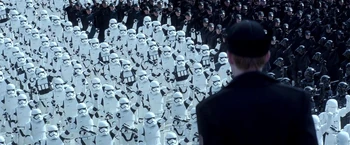
Neo-fascist stormtroopers salute in The Force Awakens with Star Wars' return to the silver screen in 2015.
J.J. Abrams and Lawrence Kasdan wrote the story of The Force Awakens based on the existing Star Wars setting and characters as part of Lucas' tale of hope against the backdrop of cynicism following the Vietnam War. Abrams and Kasdan, the latter of whom also worked on the scripts of the original trilogy, therefore extended the story of "light versus dark" and good against evil rather than make real-world geopolitical or social allegories, though Abrams acknowledged that the rise of the First Order against a benevolent New Republic could be comparable to forces happening then in the real-world.[422] The Order itself was borne of story conversations that included speculation on what might have happened if the Nazis had all fled to and regrouped in Argentina.[423] Andy Serkis, the actor of First Order Supreme Leader Snoke, described the character as a "totalitarian leader" in December 2017.[424]
Commenting on the television series Star Wars Rebels, which aired between 2014 and 2018 with himself as executive producer, Dave Filoni discussed politics and evil as a complex matter, comparing the real world's history of democracies collapsing into dictatorships with how a beautiful tree could rot from within and thus, in Star Wars, making everyone a pawn of Palpatine "even without the Empire." Filoni said that the theme of Star Wars is in Luke Skywalker's message—to "not to be of yourself but to be selfless," finding enlightenment and then inspiring others to act too.[425] The first novel of the new canon continuity, A New Dawn, was written by John Jackson Miller and published in September 2014 as a prequel to Rebels, which premiered in October. Miller likened the Star Wars galaxy's rapid increase of military production within a period of twenty years under the Empire to collectivization in the Soviet Union, which turned a predominantly agrarian Russia and the satellite nations that it conquered into an industrial-military powerhouse at the cost of "over 20 million" lives in the interwar period. The author also drew from his experience in studying totalitarian governments states in comparative politics for how the Empire adopts and transforms pre-existing Republic institutions. Miller further compared the fact that the Empire's surveillance apparatus had developed before Palpatine's time to how "surveillance of various kinds has gone on for decades, for centuries," under many governments and commercial entities in the real world, made more apparent with the Edward Snowden leaks in 2013.[426]
The 2015 comic miniseries Star Wars: Shattered Empire was written by Greg Rucka exploring the immediate aftermath of the Empire's defeat in Return of the Jedi, and the author researched propaganda and political turmoil in the Arab Spring uprisings of the early 2010s, the Soviet Bloc that collapsed in a wave of eastern European revolutions in 1989, and the totalitarian state of North Korea.[427] Adam Lance Garcia likewise wrote the 2023 short story "The Veteran," set during the riots following the Battle of Endor, with historical events such as the Arab Spring and the Tiananmen Square protests and massacres of 1989 in mind.[428]
The 2016 novel Bloodline by Claudia Gray explores the political debate between the Centrists and Populists toward the end of the New Republic Era, and Gray, having watched the musical Hamilton while writing the novel, was inclined to agree with a reader's observation that Bloodline's politics echoes the political debate between Alexander Hamilton's Federalists and Anti-Federalists over ratifying the US Constitution that clearly defined a federal government with certain central powers in 1787 and 1788.[429] The 2016 reference title Star Wars Propaganda: A History of Persuasive Art in the Galaxy by Pablo Hidalgo includes the Declaration of Rebellion, a document written by Mon Mothma on behalf of the Rebel Alliance,[17] which originated in Paul Murphy's 1990 Star Wars Legends roleplaying book The Rebel Alliance Sourcebook.[430] The text borrows phrases from the United States Declaration of Independence of 1776.[431]

The creators of Rogue One credited characters' relationships in face of the cycles of corruption with audiences' sense of resonance.
Director Gareth Edwards of Rogue One: A Star Wars Story clarified that the anthology movie was written in mid-2014 when asked whether it is significant to "recent political events" during its release in December, 2016. Edwards also echoed Lucas' belief that storytelling reflects a "human condition" that remains constant throghout human history; a "timeless" saga such as Star Wars would always resonate with contemporary events given Edwards' belief that humanity is a cycle of revolution against someone in power deemed to be corrupt.[421] Felicity Jones, who played the heroine Jyn Erso, stressed in an interview in the same month that the core of Star Wars films is rooted in characters' relationships—in Rogue One's case between father and daughter, where the filmmakers intended for viewers regardless of gender to want to be Jyn Erso as the main protagonist—which in turn make audiences want the characters to "succeed against the forces of evil."[432] Jones also appreciated that Jyn Erso's focus on her survival and mission rather than having a sexualized appearance fulfilled her perspective on feminism.[433] Rogue One writer and second unit director Tony Gilroy recalled in 2025 that the film's post-production at Skywalker Sound took place in a sad atmosphere on the days following the 2016 US elections results, and it was particularly surreal and sad to attend President Barack Obama's final Christmas party in the White House, to which Rogue One crew members were invited.[434] For the 2016 election, George Lucas supported Donald Trump's opponent Hillary Clinton.[435]
Escapism and nostalgia, or confronting oppression?[]
Rights in the West: democratic backsliding[]
The diversity debate[]
In early November 2016, Rogue One writer Chris Weitz posted comments on Twitter against Donald Trump following his victory in the 2016 US presidential election and added that the Empire in Star Wars is a "white supremacist (human) organization," prompting retaliatory online criticism. When Disney CEO Bob Iger was asked for comment at Rogue One's world premiere, he dismissed the media's "story" and asserted that the film makes no "political statements" whatsoever. Iger further said the company was proud of Rogue One's "diverse" casting, "and that is not a political statement, at all."[436] When journalist Steven W. Thrasher interviewed Riz Ahmed—who played the Imperial-turned-rebel pilot Bodhi Rook in Rogue One—earlier in July and asked him about the issue of diversity, the actor was happy that Lucasfilm was normalizing diversity in Star Wars yet, when asked about being known as the first Muslim Star Wars actor and the loud negative reaction against John Boyega's leading role as a "black stormtrooper," Ahmed described the situation as "strange"—"I can understand when John Boyega bristled at that kind of description, because it's putting you back in a pigeonhole." Ahmed said that much of life as an artist "is to transcend the labels people impose on you," but audiences could also feel a strong sense of resonance with another person's appearance, identity, and life experience. As to discussions on how art might be "political," the interviewer mentioned that the label was commonly applied to "artists of color," but Ahmed said that it has more to do with class distinctions in the British context—he thought that the interviewer could be more focused on racial cleavages as an American compared to himself, a Briton who is thus more aware of class cleavages.[437] In February 2017, Ahmed raised funds in aid of war-torn Syria's refugees with signed Star Wars memorabilia in light of the fall of Aleppo to the Russian- and Iranian-backed Assad regime in late 2016.[438]
Women's rights and LGBTQIA+ representation[]
- "I like that in the Star Wars world it's rather subtle, but you're seeing a woman as a leader who's not trying to lead as a man. [Rian Johnson is] saying something that's been a true challenge in feminism. Are we going to lead and be who we are as women in our femininity? Or are we going to dress up in a boy's clothes to do the boy's job? I think we're waking up to what we want feminism to look like."
- ―Laura Dern, speaking about The Last Jedi in an interview in 2017
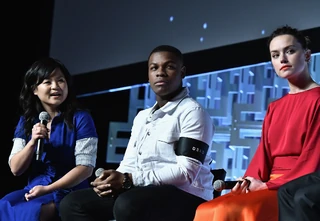
Kelly Marie Tran, John Boyega, and Daisy Ridley
Director Rian Johnson of the December 2017 sequel movie, Star Wars: Episode VIII The Last Jedi, was asked about whether it was influenced by nascent political polarization under Donald Trump's presidency, and Johnson similarly spoke of Star Wars movies as never being consciously "conceived as a political allegory." He believed audiences apply Star Wars on political situations of the day because Lucas' stories have a universal and archetypal power;[439] Laura Dern said that when she and Johnson first discussed her role as Amilyn Holdo, the director spoke earnestly about the power of Star Wars to explore the complexity of being human, making sense of light and dark and struggles with family via characters and the "hero's journey." Dern was especially pleased that Holdo has a feminine physicality[440] and said that her character reflected "a true challenge in feminism. Are we going to lead and be who we are as women in our femininity? Or are we going to dress up in a boy's clothes to do the boy's job? I think we're waking up to what we want feminism to look like."[391]
Both Laura Dern and Oscar Isaac, who played Poe Dameron, said in an interview that they had heard from Rian Johnson about their characters' depiction in Star Wars media beyond the movies and were vaguely aware about Holdo being a "very sexual character"—the September 2017 Claudia Gray novel Leia, Princess of Alderaan had mentioned that Holdo was attracted to species and genders beyond just humanoid humans[184]—and fan enthusiasm over whether Dameron could be a LGBT character. Isaac was glad that "people can see themselves in a hero" from a broad range of personal identities including LGBT and Latino, even if the story does not necessarily nail down any particular interpretation.[441] Censors in Singapore and the United Arab Emirates cut a brief lesbian kiss from local releases of Star Wars: Episode IX The Rise of Skywalker in 2019.[442]
Between the personal and the political[]
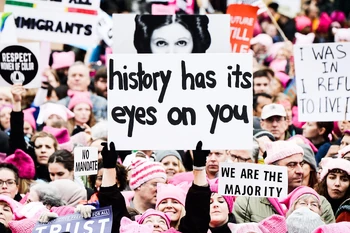
The Women's March in January 2017, protesting the incoming Trump administration, photographed by Kevin Mazur.
Rolling Stone magazine noted in its cover story of The Last Jedi that images and slogans associated with Princess Leia Organa were a common sight during the January, 2017 Women's March, held less than a month after Carrie Fisher's death, in response to the misogyny of the newly inaugurated President Trump. Interviewed by the magazine in late 2017, Daisy Ridley described the saga as a "wonderful mix" of what she thought was "somewhat a reflection of society" and "escapism, because there are creatures and there are people running around with fucking lasers and shit."[443] Interviewed by StarWars.com in 2022, Kelly Marie Tran said that she felt her character Rose Tico, introduced in The Last Jedi, is resonant with her own cultural and personal experience of growing up with parents who were "ripped from the place they lived"—Tran's parents survived the Vietnam War during their childhood and were among the Vietnamese boat people who managed to settle in the United States after fleeing their home country at the end of the war, and they made personal sacrifices to raise their family, even initially disapproving Tran's efforts to become an actor as it seemed impossible.[444]
Upon the publication of Christie Golden's novel Battlefront II: Inferno Squad in July 2017, she expressed in an interview that Star Wars media had been influenced by the development of mass media and the Internet in the real-world, replying to a question about moving beyond the clear-cut morality of popular culture prompted by World War II. Golden's works explore characters across different factions and points of view, including the Empire's Inferno Squad as a covert operation unit, and the author said that although society is "more polarized than ever," greater opportunities to reach out beyond one's world views meant that it is more difficult to "demonize people and make them one dimensional."[445]

A post from the official Star Wars Twitter account in the eve of the 2020 US elections
While promoting the final movie of the sequel trilogy, The Rise of Skywalker, Lucasfilm's President Kathleen Kennedy similarly said in 2019 that the modern world has lost the "sense of innocence" of the 1970s and the "black-and-white" sensibility of World War II; contemporary storytelling would reflect the changed society of today. Director J.J. Abrams compared the First Order's origins to a hypothetical scenario of "the Argentine Nazis" actually banding together to continue their pursuit of fascism.[350] Slavery was not welcome in the otherwise criminal setting of Kijimi City, which was not only styled after Kurosawa films but also took inspiration from Nazi-occupied Paris and Michael Curtiz's 1942 film Casablanca of the Moroccan colony under Nazi-collaborationist French control.[446] Abrams also took an approach different from the nostalgia of The Force Awakens and focused on how a new, young generation confronts the "debt that has come before," "less about restoring an old age" but "more about preserving a sense of freedom and not being one of the oppressed."[350]
On October 27, 2020, one week ahead of the November 3 United States elections, the official Star Wars Twitter account posted an image of the word "VOTE"—styled as a blue hologram containing the Rebel Alliance emblem in place of the letter "O"—with the text "Make your voice heard."[447] In 2023, Ian McDiarmid compared Palpatine to "a certain contemporary politician" because "the word loser" was likely the worst thing either could ever hear.[448]
Black Lives Matter[]
- "You are important. Your individual power, your individual right, is very, very important. We can all join together to make this a better world."
- ―John Boyega, speaking at a Black Lives Matter rally in 2020

John Boyega speaking in London, June 3, 2020
The outbreak of the COVID-19 pandemic affected people across the world into the 2020s.[450] During the Black Lives Matter protest in his home city of London in the United Kingdom on June 3, 2020, John Boyega—who played the stormtrooper–turned–Resistance fighter Finn in the sequel trilogy—spoke out against the racism that Black people face even in the democratic world.[449] On the same day, Lucasfilm expressed solidarity with Boyega and his speech,[451] and the actor publicly revealed his frustration with Disney and the wider Hollywood industry's unfair treatment of people of color in an interview released three months later. Boyega highlighted the dissonance between the sequels' initial marketing and the relatively lessened prominence of the characters played by people of color in The Last Jedi, and he added that he thought J.J. Abrams tried to salvage Disney's mistreatment with his unplanned return to directing The Rise of Skywalker.[452]
The game show Star Wars: Jedi Temple Challenge was scheduled to be released on June 3, 2020, but producer and lead actor Ahmed Best announced its delay to June 10 given widespread civil and violent reactions to George Floyd's murder by police in the US several days prior, on May 25.[453]
Might in the East: growing autocracy[]
China, Taiwan, and Hong Kong[]
While the original trilogy entered China in the aftermath of the Cultural Revolution in various unofficial ways, Lucasfilm officially collaborated with Chinese companies via Disney with the release of the sequel trilogy in the late 2010s.[372] Compared to the original American posters for The Force Awakens and also Hong Kong's bilingual Chinese-English posters,[454] when the movie was released in mainland China in January 2016, the poster design there significantly diminishes John Boyega's character and entirely removes his Latino co-star Oscar Isaac as Poe Dameron and the non-human characters Chewbacca and Maz Kanata.[455] In a 2018 interview, Boyega said that he became aware of the racist changes via social media but did not focus on it, instead taking pride of the fact that The Force Awakens would be seen by large numbers of people and he would appear throughout the movie.[456] Its premiere inspirited Star Wars fans in mainland China, who have been able to build up sizeable online fan communities and kept up with US-based Star Wars news via websites such as the unofficial encyclopedia Wookieepedia.[376]

Star Wars Day celebration at Taiwan's Presidential Office
When the cover of the TIME magazine in June 2015 featured Taiwan's presidential candidate Tsai Ing-wen with the words "She could lead the only Chinese democracy," state media in mainland Chinese censored the words and compared her picture to a picture of Master Yoda.[457] Tsai was elected President. In 2018, the Taiwan Presidential Office held a May the Fourth welcome event with Star Wars fans where Vice President Chen Chien-jen remarked: "If you all come in peace, I welcome you all as our guests. Today Master Yoda [President Tsai] is absent, but I quote one phrase from Yoda—'size matters not'. Taiwan is bigger than you think."[458]
Both former Chief Secretary Anson Chan and activist Joshua Wong of Hong Kong compared the city's Police Force to the stormtroopers of Star Wars in their "indiscriminate brutality" against peaceful young demonstrators during the 2014 and 2019–2020 pro-democracy protests. Chan claimed in 2014 that Hong Kong's tradition of peaceful protest dated back to the 1989 Tiananmen crackdown, and yet the police and the governments of Hong Kong and China have routinely failed to honor their responsibilities, opting to "rule by law" rather than uphold the rule of law as stipulated by the Sino-British Joint Declaration and the local constitution. Wong claimed in 2020 that a new cold war was brewing between China and "the democratic world" and Hong Kong, with the sometimes-violent clashes between protesters and police, was one of its first battles.[459][460] Artwork of the Hong Kong protest movement feature local imagery alongside Hollywood popular culture imagery, including Star Wars, in what scholars describe as an attempt to reframe Hong Kong in good versus evil terms, especially for citizens who dually identify as localists and cosmopolitans, and also amplify international outreach.[461] Similar Star Wars artwork were made during the pro-democracy protests in Thailand in 2020.[462] During the 2024 trial of activist Benny Tai, arrested in 2021 for "subversion" under a new law inserted by the Chinese government into the local constitution, a handpicked national security judge characterised the 2020 pro-democracy primary election candidates as "stormtroopers" for planning to win a majority of seats in the ultimately postponed Hong Kong legislative election and to vote down the government budget, and the judge added that the court intended to find their "Darth Vader." Tai later pleaded guilty and the court stated he was the "mastermind" of the primaries.[463]
The Star Wars: Galactic Conflict video game was developed in China and approved by the authorities between 2019 and 2020,[464] and a Taiwanese company would have handled distribution outside the mainland via a subsidiary in Hong Kong that was founded in response to the trade war between China and the United States[465]—the game was never released amidst various irregularities.[466] The official Chinese web-novel The Vow of Silver Dawn[372] was released between 2020 and 2021[467] to explore the Star Wars galaxy from a Chinese cultural context.[372] Among the web-novel's characteristics is the setting of Aakaash system, ruled by a corrupt corporation that isolated itself from the Republic, brainwashed citizens in news media, enforced disappearances, and suppressed the dragon-like Loongren ethnic group.[66]
Russia, information war, and Ukraine[]
A study published in the First Monday journal in 2018 reported that a significant number of Twitter posts harassing Rian Johnson over The Last Jedi are characteristic of troll accounts of the Russian Federation, which manipulate and exploit the politicization of popular culture discourse, particularly misogynistic, anti-gay, and alt-right beliefs, akin to 2014's Gamergate harassment campaign and Russia's electoral interference targeting the United States.[468]
According to an English-language article by the Russian government's Russia Beyond media outlet in 2015, the Zebra youth television program in Leningrad (Saint Petersburg) illegally broadcast dubbed clips of Star Wars in 1989, but the US Consulate General allowed Zebra to continue doing so. Star Wars was finally released in the Soviet Union in the summer of 1990, and the Communist state collapsed in the following year, to be largely replaced by the Russian Federation. The Russia Beyond article goes on to mention that a 2001 episode of the satirical television series Kukly had a puppet of the "recently elected president Vladimir Putin" play as Luke Skywalker while a puppet of ex-president Boris Yeltsin played as Obi-Wan Kenobi.[469] The article neglects to mention that the broadcaster was taken over by the Russian regime that year.[470]
Following Ukraine's Revolution of Dignity in 2014, Putin launched Russia's war against Ukraine.[471] In 2015, the Ukrainian city of Odesa invited sculptor Oleksandr Milov to transform a statue of the Soviet Union founder Vladimir Lenin into Darth Vader. The city also planned to install a Wi-Fi router in the dictator's head so that he could communicate with other Sith.[472]
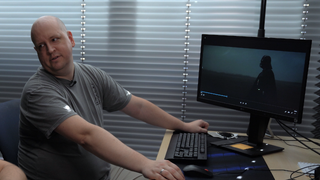
Work on Star Wars continues in Ukraine, taking advantage of AI technology.
The full-scale Russian invasion of Ukraine in February 2022 disrupted the Ukrainian speech-synthesis start-up Respeecher's work on the Star Wars: Obi-Wan Kenobi television series, but employees finished replicating James Earl Jones' voice as Darth Vader via artificial intelligence with the actor's consent, having previously replicated actor Mark Hamill's voice as a young Luke Skywalker for Star Wars: The Mandalorian and Star Wars: The Book of Boba Fett.[471] In September 2022, Hamill joined Ukraine's United24 crowdfunding campaign as an ambassador to acquire reconnaissance drones, with Ukrainian President Volodymyr Zelenskyy thanking Hamill's support and echoing Star Wars' theme that "good will triumph over evil and light will overcome darkness."[473] In March 2023, Hamill voiced Ukraine's "Air Alert" app in its English-language version.[474] Ukrainian actress Ivanna Sakhno, who played Shin Hati in the 2023 television series Star Wars: Ahsoka, is also an ambassador for United24 and the International Rescue Committee and advocating for her country, which is "fighting for democratic values around the world."[475]
Evolution of culture, geopolitics, and AI—2020s[]
The High Republic[]
Launched on January 5, 2021 following several months of delay in light of the COVID-19 pandemic, Star Wars: The High Republic is a multimedia project set during a renaissance era of the Jedi and the Galactic Republic, beginning with works primarily by authors Cavan Scott, Claudia Gray, Charles Soule, Daniel José Older, and Justina Ireland.[476] Starlight Beacon is a central setting of the project's Phase I and is "very closely tied" to New York's World Trade Center and the Twin Towers' collapse in the September 11 attacks of 2001.[477] Phase II features the Eiram and E'ronoh War, for which author Zoraida Córdova researched the World Wars and the Cold War about the cyclical nature of human conflict.[478]
Phase III features the Stormwall, which was similarly influenced by the Berlin Wall; Justina Ireland was serving in the US army during 9/11, and as a child, she had happy childhood memories of news about the fall of the Berlin Wall and the supposed end of communism in November 1989. Ireland also said that her fellow authors had also lived through such "touchstone historical moments" that could influence their writing.[477] Tessa Gratton wrote the 2024 novel The High Republic: Temptation of the Force focusing on love and politics, having struggled with the seeming contradiction of a Jedi's duty to uphold justice and dismissal of "love" as simply attachment in Star Wars while also appreciating that politics in practice is messy, yet the setting has "a lot of really clear-cut lines" that allow ideas to be clearly expressed via politics. The author thought that a person could not truly believe in justice if they do not love something, and the time of the High Republic allowed Yoda to support Elzar Mann emotionally unlike Anakin Skywalker in the prequel trilogy because the Jedi were not yet deeply entangled with the Republic's politics.[479]

Starlight Beacon, a centerpiece in The High Republic storytelling
In 2024, Daniel José Older retweeted a November 21 Twitter post from a reader of his Star Wars: The High Republic Adventures comic series expressing that the Valo story arc, spanning issues 11 and 12 published in the preceding days, felt "like a commentary on current events, specifically about Palestine"[480]—suffering from mass killings and forced displacement particularly within the Gaza Strip since the October 7 Hamas terrorist attack on Israel in 2023 amidst a wider regional crisis, international controversy, and Israeli protests against their leader Benjamin Netanyahu.[481][482] Older later quoted an excerpt of a review of the twelfth issue on Twitter: "In Star Wars The High Republic Adventures #12 Daniel José Older reminds us of a fundamental premise behind Star Wars: Resistance is Perseverance. Standing up for freedom in the midst of colonization and apartheid lies in persistence of hope and persistence of action."[483]
Andor Season One[]
- "Our world is exploding in different places right now, people's rights are disappearing, and Andor reflects that. [In the show] the Empire is taking over, and it feels like the same thing is happening in reality, too. I was impressed by Tony's social-realist intentions. He's created a whole new morality. It's very deep and humane—there is grief, mourning, hope, fear. It's not just primary colours here."
- ―Fiona Shaw, in a 2022 interview on Tony Gilroy's Andor series
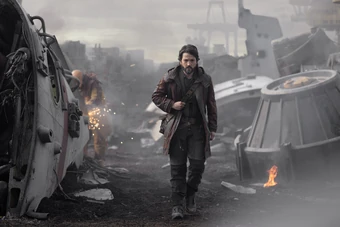
Andor drew from a plethora of revolutionary histories.
Showrunner Tony Gilroy characterized his work on the television series Star Wars: Andor as an amateur historian and late bloomer who learnt traditional ways of storytelling from writers like William Goldman and had a golden opportunity from Disney and Lucasfilm President Kathleen Kennedy to turn 1500 pages on revolution and the rise of authoritarianism into a drama series.[485] When Gilroy was asked about political resonances in 2022's Andor Season 1 in November of that year, he stated that the Andor was written without contemporary politics in mind, drawing on historical revolutions simply as spontaneous events to drive the characters' adventures—"whatever contemporary resonance it has is usually in the eye of the beholder. Oppression is oppression."[486] In another November interview, Gilroy emphasized that his personal politics are "absolutely not important" to the series' themes and that Star Wars allows plentiful comparisons to history. As to the "age old question" of "who's a terrorist and who's a freedom fighter," Gilroy wanted every character to "speak for themselves" to make their motives believable and referred the idea of controversial revolutionaries to historical nation-building movements, naming the United States' Thomas Jefferson and South Africa Nelson Mandela and further listing the revolutions of France, Haiti, Russia and the Soviet Union, and the nation-building of Israel.[487] Gilroy also named the French Montagnard, the African National Congress, the Irgun Building in Palestine, and the American Continental Congress. Responding to a comparison with Russia's contemporaneous war against Ukraine, Gilroy remarked on how sad it is that terrible events continue to repeat themselves through history.[488] The season one finale took inspiration from the 1966 Gillo Pontecorvo film The Battle of Algiers, which was based on the Algerian War of Independence against the colonial French government.[489]
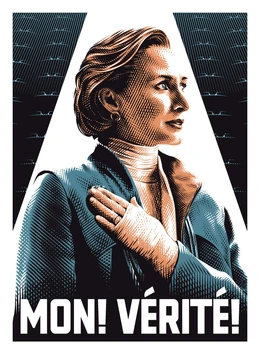
Tracie Ching's Mon! Verité! poster of Mon Mothma speaking her truth
Gilroy also likened Andor's character of Luthen Rael as a start-up company founder[487] and, earlier in September, identified the senator and eventual Rebel Alliance leader Mon Mothma as a "figurehead of liberal democracy that will fail."[490] Gilroy compared the pre-existing canon role of her as a "still portrait" of a "proper" and "powerful" senator like US House Speaker Nancy Pelosi in another interview in the same month and promised that Andor would "build a real life" behind Mothma's character,[491] and in an interview released in November, he clarified that he was not thinking about Pelosi when writing the scripts.[488] Genevieve O'Reilly, the Irish-Australian actor of Mothma in Revenge of the Sith and Andor, said in an April 2025 interview that she and Gilroy had talked about not placing Mothma in another expositional role again but instead bring a "deeply human" characterisation of the woman to the fore.[492]
O'Reilly added that "the tentacles of empire" underpins a large part of human history across the continents and ages, whether it be in Australia, Ireland, America, Africa, Portugal, or France.[492] Speaking in the following month, O'Reilly said that to develop her portrayal of Mon Mothma, she was inspired by many female leaders and rebels in history—among them Empress Zoe of the Roman Empire in Constantinople and the Irish revolutionary politician Constance Markievicz and also the contemporary President of Mexico Claudia Sheinbaum.[493] The character of Mon Mothma in relation to the real world had also been previously discussed by authors of official Star Wars material. In 2012's Star Wars and History, Janice Liedl had likened Mon Mothma to Countess Matilda of Tuscany, who cut off her husband from her possessions and brokered a brief peace between the Holy Roman Emperor and the Pope, whom she supported.[368] In February 2017, Chuck Wendig, author of the 2015–2017 The Aftermath Trilogy which detailed Mon Mothma leading the fledgling New Republic, had described her as a "fairly centrist leader" who proved the difficulty of good governance.[494]
Fiona Shaw, who played Maarva Andor and spoke in an interview released in August 2022, thought that Gilroy's story is a "scurrilous" and "social-realist" take on "the Trumpian world" that was "exploding in different places right now" with people's rights being taken away.[484] Gilroy said that Syril Karn, played by Kyle Soller, was aspiring to be part of the Imperial Security Bureau, which he compared to the Nazi SS.[491] In April 2025, Soller said that his character showed the "banality of evil"—a concept from Hannah Arendt's 1963 report on the trial in Israel of the SS member and Holocaust organizer Adolf Eichmann, who was apparently leading an ordinary life in Argentina after the world war—a unexceptional bureaucrat "desperate to be loved" who would facilitate atrocities for professional promotion.[495]
Legacies of war, colonialism, and authoritarianism in animation[]

Ksenia Zelentsova's "One Heart Divided" painting of the clones starring in The Bad Batch
In 2020, George Lucas and Dave Filoni reflected on how the clone trooper–focused stories of The Clone Wars were very well received by military families.[405] The 2021–2024 television series Star Wars: The Bad Batch follows a group of clones handling the Republic's transition into the Empire. StarWars.com interviewer Dan Brooks thought that the conflict between Hunter and Crosshair—without the typical clone inhibitor chip—represented an ideological struggle between democracy and loyalty to authority, and supervising director and executive producer Brad Rau replied that he and the series writers wanted to show clone soldiers having different points of views with their own free will, and rather than present a binary view of morality, they wanted the audience to see that "neither one of them were necessarily right or wrong." Head writer and executive producer Jennifer Corbett added that The Bad Batch explores how even for ordinary clones, despite the chips' effects "wearing off," some choose to remain with the Empire while others choose not to.[496] For season 3, Corbett said the writers intended to ground their stories to real-world topics and particularly focused on military veterans who "no longer have a war to fight" and find themselves unemployed and in need of support.[497] The television series Ahsoka, created by Dave Filoni, addresses the question of history repeating in cycles through the character of Baylan Skoll, who says that history "repeats again, and again, and again" in an "inevitable" circle if not stopped.[498]
The May 2023 Star Wars: Visions animated short "In the Stars," made by the Chilean studio Punkrobot Studios and set on a world ravaged by the Galactic Empire for its natural resources, took inspiration from the art and culture of the indigenous peoples of Patagonia in southern Chile, using the Empire as an allegory for the centuries of colonial oppression imposed on native people by the Spanish Empire and independent Chile, which did not transition into a modern democracy until dictator Augusto Pinochet was forced to step down in 1990.[499] The short specifically honored the Selk'nam people, against whom the Chilean state conducted genocide.[500] The Visions short "The Spy Dancer," made by the French Studio La Cachette and set on an affluent world occupied by the Galactic Empire, was inspired by cabarets in Nazi-occupied Paris as well as the performers Josephine Baker—who aided the French Resistance in the Second World War and later the American civil rights movement—and Mata Hari—who was executed by France for allegedly spying for the German Empire in the First World War. Director Julien Chheng was also influenced by his family's history under the genocidal Communist Khmer Rouge in 1970s Cambodia, particularly how the regime turned family members against each other. "The Spy Dancer" was particularly well-received by audiences in Cambodia and Argentina, which ended its last military dictatorship in 1983 after losing the Falklands War to the United Kingdom.[501]
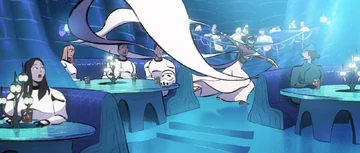
Lucasfilm invited animation studios worldwide to produce Star Wars: Visions shorts, with some creators drawing on the heritage of dictatorship.
Another Visions short, "The Bandits of Golak," made by the Indian studio 88 Pictures and set amidst conflict between the Galactic Empire and native people, serves as a metaphor for the legacy of British colonization and imperialism—particularly mass displacement and religious divides caused by the Partition of India in 1947 in the modern-day states of India, Pakistan, and Bangladesh.[502] The Visions short "Aau's Song" by Triggerfish Animation Studios reflect its creators' love for South Africa's natural landscapes despite the myriad issues "stemming from our recent history" and South Africans' wide range of backgrounds.[503]
Culture war: social media and election fears[]
- "It's not lost on me how, the way that these events have unfolded, is also due to the hyper divisiveness of the time that we live in—that is driven, I would say by this point, by echo chambers of thought and algorithms that reinforce our biases, and I think that applies to everybody."
- ―Amandla Stenberg, in a video discussing the hateful harassment that she has received in 2024

Social media platforms such as Twitter have become battlegrounds of political discontent and division.
Lucasfilm employees and the leads of the sequel trilogy have faced considerable harassment over the years, particularly sexist and racist messages and death threats online. Social media escalated toxic antagonism among Star Wars communities and have become an avenue for mass outrage influenced by Russian troll accounts.[468] The author Chuck Wendig faced years of harassment following the publication of his novel Aftermath in 2015 on including LGBT characters and was dropped by Marvel Comics from his Star Wars work in October 2018 for his outspoken political comments on social media.[505] This followed an upsurge in an online alt-right mob of the Comicsgate movement targeting Wendig on YouTube and Twitter that was joined by Twitter bot accounts.[506]
Lucasfilm issued a statement on February 10, 2021, concerning The Mandalorian actress Gina Carano, saying that "her social media posts denigrating people based on their cultural and religious identities are abhorrent and unacceptable."[507] When Moses Ingram shared her thoughts on receiving hateful messages about her role in the Obi-Wan Kenobi series on Instagram on May 31, 2022, she thanked the fans who supported her in light of the abuse. Later that day, the official Star Wars Twitter account shared Ewan McGregor's video message in solidarity with his co-star, saying that "if you're sending her bullying messages, you're no Star Wars fan." The Star Wars account made a further statement condemning the abuse, including "If anyone intends to make her feel in any way unwelcome, we have only one thing to say: we resist" and adding that "There are more than 20 million sentient species in the Star Wars galaxy, don't choose to be a racist."[508]

Amandla Stenberg playing the violin solo that John Williams had written for her.
Leslye Headland's 2024 television series Star Wars: The Acolyte is set during the end of the High Republic Era, and Headland compared the state of the Republic to the isolationist tendencies of the United States between the World Wars.[509] Amandla Stenberg, who played Osha and Mae Aniseya in the series, made a music video addressing her exhaustion with targeted online discourse and harassment. She criticized the transformation of the term "woke" for culture war and clickbait purposes, including journalists who sacrifice "truth" for selective "metrics and data" that fuel division.[510] The cast and crew of The Acolyte faced racist and sexist online harassment. On August 19, Lucasfilm and Disney informed media outlets that there would not be a second season of The Acolyte and offered no further comment. Twitter owner Elon Musk later reacted to the news on the social media platform to suggest that the series is "woke."[511] Stenberg later shared their thoughts on Instagram, calling out the "hyper-conservative bigotry and vitriol, prejudice, hatred, and hateful language" used by "the alt-right" to target individuals, with "echo chambers of thought and algorithms that reinforce our biases" driving the "hyper divisiveness" of online discourse. Stenberg also said "we all exist in the context in all which we live," calling on people to vote in the 2024 United States elections and to "challenge us all and challenge myself to continue questioning what it is that I digest and think critically about what shapes it."[504]
Responding to a question about "white men" dominating Star Wars at 2024's Cannes Film Festival, George Lucas said that most beings in his universe were aliens and his films starred prominent non-white cast members and showed strong women. Lucas further said he intended his universe to show that all people are "equal" regardless of their appearance, gender, or species, with the only form of discrimination being anti-droid sentiment similar to the contemporary development of advanced artificial intelligence.[327] Lucas had said in 2020 that the D-Squad arc on existentialism in droids were his favourite episodes of The Clone Wars.[405] The English comic writer Alan Moore had similarly written "Rust Never Sleeps," among several other comics in Star Wars Legends published in 1982, on the idea of artificial intelligence's having no rights compared to organic beings. Moore noted in 2024 that British and American culture and politics have, over the decades of the Internet's democratization, become dominated by the adverse effect of fandoms—a sense of ignorance, entitlement, frustration, and complaint where "entertainments may be cancelled prematurely through an adverse fan reaction," "misogynist crusades such as Gamergate or Comicsgate," and elections are treated as a fandom event—which Moore believed has been fueling superficial politics with dangerous effects on the populist road to fascism.[512]
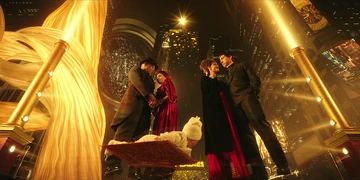
Francis Ford Coppola's Megalopolis compares American democracy to the fall of the Roman Republic.
Lucas' filmmaker friend Francis Ford Coppola's film Megalopolis premiered at the 2024 Cannes festival, exploring the similar premise that the United States of America is a new Roman Republic and, like Rome two thousand years ago, coud lose its republic and democracy[513] at the 2024 US election. Coppola mentioned Lucas as an influence and mourned that journalism and Hollywood industries are "dying," and America's existing "system" of consumerism has been making an unhappy people. With Megalopolis, he wanted to highlight that humanity is an "extraordinary" civilization of which every person has a creative power, even given their circumstances, to change themselves and their surrounding world for humanity to mutually thrive.[514]
"You take a negative and you make it into a positive"[]
- "This is a story that gives me so much fuel to keep going forward, because when I get to bring characters like this to life and they come from me and what that represents it, I hope that it serves as a source of inspiration, representation and for the Venezuelan people to see that it is possible and that it doesn't always have to end in demise and pain."
- ―Humberly González, in an interview on Star Wars Outlaws and the Venezuelan people's fight for democracy in 2024
As the leading woman of the 2024 video game Star Wars Outlaws, Venezuelan actress Humberly González believed her character Kay Vess' resilience and struggles reflect the experiences of her people, who had voted for democracy and freedom in June of that year but continue to be ruled by a decades-old authoritarian regime. González believed that Vess' story of not giving up serves as an inspiration because "freedom is worth fighting for." She also thought that her separation from her family in Venezuela echoes Vess' story, coupled with her immigrant experience of learning to open up and trust people in the liberal democracy of Canada to pursue her dream career as an actress, which she learned has been particularly inspiring to other Latina migrants, people of color, and women.[515]
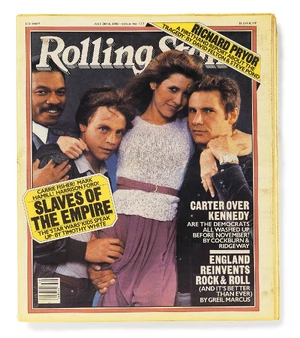
Billy Dee Williams, Mark Hamill, Carrie Fisher, and Harrison Ford on the Rolling Stone magazine, 1980, photographed by Annie Leibovitz.
Lando Calrissian actor Billy Dee Williams, who had lived through America's Jim Crow era of segregation and been friends with civil rights figure James Baldwin,[516] was initially concerned about the racialist impression that the "black fear" of Darth Vader, voiced by James Earl Jones, could give in contrast to the "white knight" of Alec Guinness' Obi-Wan Kenobi, but following 1980's release of The Empire Strikes Back, he was pleased that Star Wars has a clearer symbolism of humanity's darkness as the antithesis of clarity. Drawing on his conversations with director Irvin Kershner on Japanese philosophy, Williams described Star Wars as a lesson in truths and consequences about abuse of power, and that the "greatest teacher" is the one who says "Don't follow me, follow yourself. Because within you there is that kingdom, that life, that force."[517] Williams had been aware that his younger sequel trilogy leads faced racism and sexism from online trolls by 2019 and,[518] in an interview promoting his memoir in 2024, said he believes that while the world has been dominated by "a European western value system for centuries," ultimately he does not care about discussing identity politics, saying: "The only thing that's dangerous is lots of stupid people running around and shooting people," and that "you take a negative and you make it into a positive."[516]
Dr. Chris Kempshall's Star Wars: The Rise and Fall of the Galactic Empire was first published in the United Kingdom on July 4, 2024, the day of the UK general election, as an analysis of the Galactic Empire from an in-universe historical perspective.[519] It would complement the Star Wars: Reign of the Empire novel series.[520] On November 5, the day of the 2024 US elections, Industrial Light & Magic encouraged Americans to "Vote and make your voice heard" via Twitter, including the image previously posted by the official Star Wars account ahead of the US elections in 2020.[521]
The Revolution Starts Now[]
Love in the time of unrest[]
- "No one goes in a revolution if it's not for love, for a real need of bringing change for a community. […] It's a love story. There's no revolution without love."
- ―Diego Luna, in April 2025, on Andor
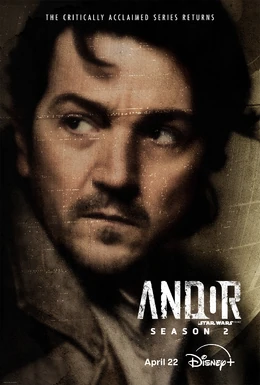
In 2025, Andor and The Mask of Fear explore the start of Star Wars' revolution.
According to Alexander Freed, his February 2025 novel Reign of the Empire: The Mask of Fear explores the "violent disagreement" of "'ordinary' citizens" in the Empire's early days on the "ideas of democracy, resistance, revolution, and complicity."[523] Editor Tom Hoeler further said that the book was informed by political movements in the real world and developed with the same intent as the television series Andor[524]—according to Freed, his novel and Andor are "both interested in what it means to live under an authoritarian regime, the psychological harm that builds up under those conditions, and the sacrifices people make."[525] Freed also said that all Star Wars work involve a clear moral world of good and evil based on the Force—even while characters allow a depth of nuance to be explored—the notion of a found family, whether literal or forging a sense of community with likeminded people—and faith in peace and being able to discuss differences while still accepting that negotiations often descend into violence.[526] Andor Season 2, released in April and May that year, had its trailer released in February using Steve Earle's 2004 country punk song The Revolution Starts Now,[527] which addresses how citizens ought to actively defend American democracy in light of the election and ongoing war in Iraq that year.[528]
Diego Luna, who played Cassian Andor, said in an interview in April 11, 2025 that revolutions are based on love.[522] Elizabeth Dulau, who played Kleya Marki, said in an interview published on April 28 that beneath the rigid veneer of her character was "a lot of love" that motivated her to sacrifice her daily life for the rebellion.[529] In an interview with The Hollywood Reporter published on April 15, showrunner Tony Gilroy credited Lucasfilm's President Kathleen Kennedy and Disney's CEO Bob Iger—who returned to the role in November 2022—with the "gamble" of backing Andor's story of political revolution even though streaming services like Disney+ were beginning to face market difficulties in mid-2022, and Andor was restructured from five season to two seasons rather than abandoned.[530] In an interview with The Telegraph published on April 23, Tony Gilroy was asked if there was any order from Lucasfilm to "adjust the depiction of the Empire in light of a presidency that could be seen to mirror it" in light of Donald Trump's second term as US President. Gilroy replied that he would be asking the same question if he was in the interviewer's place but elaborated that his story and characters were based on historical revolutions—such as the Soviet revolutionaries Leon Trotsky and Stalin who robbed a bank to fund the revolution,[531] which was the basis for the Aldhani heist in Season 1,[532] or the French Resistance comprising Gaullists, Communists, and the Maquis who hated each other.[531]
In a Golden Globe press Q&A held on April 15 and published on April 20, Tony Gilroy said he was informed by the revolutions of Haiti, Russia, America, and Britain, as well as early Catholicism and the Mexican revolutionary Emiliano Zapata.[533] In an interview with Agence France-Presse (AFP) in Paris published via France 24 on April 20, Gilroy added that he was also informed by the French Revolution, the English-born American and French revolutionary Thomas Paine, Oliver Cromwell, and the Roman Revolution. Gilroy also said to AFP that his writing of Ghorman was partly inspired by the 2009–2017 television series A French Village, about Nazi-occupied France, and that "the dynamic of oppression and resistance are a Catherine wheel" and history is "timeless, sadly."[534] Gilroy also said he was interested in Mao Zedong in another interview published that day, by Time Out, and he also took inspiration from the 1969 Jean-Pierre Melville film Army of Shadows, set during the French Resistance, the 1982 Jacques Demy film A Room in Town, set in a 1955 strike in France, and Gillo Pontecorvo's 1966 film The Battle of Algiers, with the writer also finding the 1943 Jean Renoir film This Land Is Mine echoing Andor. The creators were also influenced by the television series Babylon Berlin, set in the latter years of Weimar Germany.[535]
In an interview conducted ahead of Season 2's premiere and published upon the series finale's release on May 13, Variety asked Tony Gilroy about motifs of unrest across Andor, noting how the series "summons images of Ukraine, Gaza, Kabul and Hong Kong" of current affairs together with historical references—Gilroy said that he was writing about all revolutions and insurrections and how he felt that people, including himself, often have a narcissistic and individualistic belief that they are living in a unique time of history despite that not being "the pattern of history." Nevertheless, seeing audiences draw current real-world parallels to the series, such as a sense of authoritarianism threatening democracies like the United States, is a reflection on "if people find history knocking at their door, there's probably all kinds of places they can look for references."[536] The writer said in a roundtable discussion hosted by Lucasfilm and released on June 12 that the "British Revolution"—the civil wars in the isles ruled intermittently by Charles I, Oliver Cromwell, and Charles II during much of the 17th century and culminating in the Revolution of 1688—was the "ultimate revolution," as Karl Marx and Friedrich Engels had claimed.[532]
Stellan Skarsgård, the actor of Luthen Rael in Andor, asked that his character not be motivated by revenge against the Empire. Tony Gilroy agreed and modeled Luthen Rael as an extreme accelerationist political revolutionary like Mao Zedong who incites desperate scenarios to compel people to revolt. Rael also takes inspiration from revolutionaries dedicated to connecting people and gathering resources like Benjamin Franklin.[537] Gilroy also described the character as a start-up company founder[487] who has secured venture capital funding and is seeking to go public with the revolution in his garage but is terrible at human resource management.[538]
Forest Whitaker, who had played the revolutionary Saw Gerrera in Andor and the Ugandan dictator Idi Amin in the 2006 film The Last King of Scotland, said he was drawn to both stories as they are about characters compelled to fight for a cause; Amin and Gerrera, "in their own ways," led rebellions that they believed would protect their people from being "subjugated by their environments." Whitaker did not base his potrayal of Gerrera on any direct historical research, though he was partly inspired by the Latin American revolutionary Che Guevara as a leader who "fought for his people from the outskirts of society." Whitaker added that he appreciated Andor for exploring the "gray areas" of "flawed leaders, misguided rebels, and figures who'd both torture and nurture" like Saw Gerrera, an exemplification of the violent pursuit of a cause "by whatever means necessary," yet audiences connect to the character because his "motivations are just." Whitaker himself had founded the Whitaker Peace and Development Initiative in 2012, which has been developing programs to train and support marginalized people in places afflicted by conflict, with an emphasis on enabling youth and women to build more resilient communities working with their environment.[539]
The weight of words[]
- "In the Star Wars universe, the Galactic Senate had a very long history as a governing body that was built on democratic principles, so through the five years of Andor, which we've condensed into two years [seasons], we're watching many events, but we're watching the destruction and obliteration of democratic principles, and the Senate is descending—we're watching it through Mon's eyes over her shoulder—the Senate descending into total capitulation to the Emperor's rule."
- ―Dan Gilroy
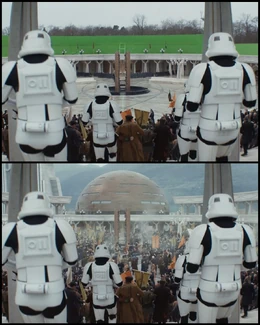
The set of Palmo Plaza (above) and the finalized shot (below).
Tony Gilroy was permitted to use the word "fascism" as part of Andor's press tour towards the end of the series' release on Disney+.[541] On May 13, Gilroy said during a livestream on the official Star Wars YouTube channel that fascism not only destroys the people that the ideology is used to target but also the people who enact it, referring to ISB supervisor Dedra Meero and the bureaucrat Syril Karn.[542] The ISB features prominently in the series and, in Gilroy's words, "isn't made up of caricatures" but people who believe in the "righteousness of control," with mundane bureaucracy becoming an oppressive weapon that destroys even its own enforcers.[539] The ISB originated in the Star Wars Legends continuity in 1987's Star Wars: The Roleplaying Game by West End Games,[543] created by Bill Slavicsek as the Empire's "KGB or secret police." For 1990's The Rebel Alliance Sourcebook, Slavicsek signed off on Paul Murphy's creation of the Ghorman Massacre, which drew inspiration from the British Indian Army's Jallianwala Bagh massacre in 1919 based on his reading of historian Jan Morris’s Pax Britannica Trilogy.[544]
Tony Gilroy placed emphasis on a non-ideological study of characters, like the Dedra Meero as an Imperial Kinder-block victim trying to "become the thing that scares me [her] the most" and Syril Karn's "romantic" careerism and "small-mindedness" in greed, explicitly drawing on Hannah Arendt's banality of evil and events such as the Nazi Wannsee Conference for Krennic's conference on the genocide of Ghorman but without making his writing an academic study, all the while personally struggling with understanding why people do things they know to be wrong.[545] The showrunner also cited the 2001 Frank Pierson film Conspiracy, which dramatizes the Wannsee Conference, as an influence for the Ghorman operation.[530] According to Dan Gilroy, brother of Tony Gilroy and the writer of the Andor Season 2 episodes "Messenger," "Who Are You?" and "Welcome to the Rebellion," and the nominee for an Emmy Award for the writing of the lattermost episode, the Ghorman Massacre serves as the "fulcrum" of the entire series and a radicalization event for both the Imperial and rebel sides—a being of the galaxy either buys into Krennic's fascistic narrative like Dedra Meero or otherwise chooses not to act and becomes a bureaucrat or some other part of the "bonfire of fascism" like Syril Karn, or they choose to act against the Empire before it is too late. Dan thought that Syril Karn's final moment is akin to Alec Guinness' portrayal of epiphany—"what have I done?"—at the end of the 1957 David Lean film The Bridge on the River Kwai.[540]
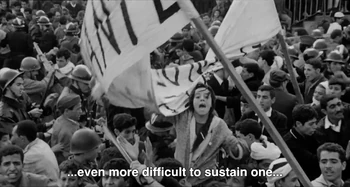
Andor drew inspiration from various film and events, including the 1966 film The Battle of Algiers on the Algerian Revolution.
Janus Metz, the director of the same Season 2 arc and an Emmy Award nominee for the direction of "Who Are You?," which shows the Ghorman Massacre, had previously filmed Danish soldiers serving in Helmand in the Afghanistan War for the 2010 documentary Armadillo and wanted to convey the sense of being amidst a real firefight.[539] At the set of Palmo Plaza, Metz and the crew discussed films and events serving as inspiration, including Gillo Pontecorvo's The Battle of Algiers (1966), Romain Gavras' Athena (2022), football riots, and street fights in the Gaza Strip.[540] The episode was filmed "almost like a documentary" and intentionally grounded in the sense of control and resistance prevalent under authoritarian regimes during the Cold War and contemporary surveillance states. The director credited the all-French cast of actors who sang the Ghorman anthem "We Are the Ghor" by composer Nicholas Britell and Tony Gilroy for delivering a sense of belonging and resistance that is poignant not only in the Star Wars universe but also in the real world.[539] The Ghorman protest phrase "we are the Ghor, the galaxy is watching" borrows from the real life protest phrase "the whole world is watching," which is, according to Gilroy, "universal enough that I can use it," based on its use during the Occupy Wall Street movement in 2011. The phrase was popularized in the 1960s by civil rights protests, Bob Dylan's "The Times They Are a-Changin'," and the anti–Vietnam War protests in Chicago.[546]
The role of singing in resistance movements such as among Danes under Nazi occupation and Estonians under Soviet occupation inspired Tony Gilroy to make the Ghorman anthem, while Nazi false flag operations at the start of Germany and the Soviet Union's Invasion of Poland inspired Dan Gilroy's writing of the sniper at Palmo Plaza.[547] Los Angeles Times' Spanish language division asked Tony Gilroy on May 30 if he was informed by the 1968 Tlatelolco massacre in Mexico City or something similar like 1989's Tiananmen Square massacre, and Gilroy replied he had not learnt of Tlatelolco until recently but found the role of snipers shared between Andor and the actual event particularly interesting.[493] Eugene Lin, who played an Imperial security trooper in the Ghorman Massacre, shared a comment on social media likening it to "space Tiananmen Square massacre."[548]
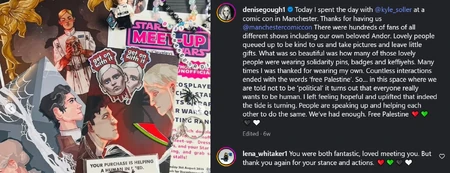
A social media post by Denise Gough on Andor and Palestinian solidarity
Dedra Meero's actor, Denise Gough, expressed in interviews her belief that artists like herself using their platforms to speak up for the Palestinian people is important to keep up a groundswell of support through democracies like Ireland for the rights of other people.[549] Gough has said she is touched by Andor fans who met her and Kyle Soller wearing symbols of solidarity with Palestinians and "countless interactions" ending with the words "free Palestine," which she thought was not just "political" but simply human.[550] Having visited Palestine in September and witnessed Israel's ongoing occupation of the West Bank first-hand, Gough said in an interview with journalist Mehdi Hasan that Andor's portrayal of the banality of evil particularly resonates with the apparent resurgence of fascism in the world, and she could not see how Israel can be considered a democracy.[551]
Nemik's actor, Alex Lawther, likewise joined the Palestine solidarity protests in London expressing a "collective outrage" and calling on the UK government to take action on the killing of Palestinians,[552] and both Gough and Lawther were among the artists asserting that Israel has been committing genocide in a video projected by the Palestine Solidarity Campaign UK at the Labour Party Conference on September 28, 2025, requesting the UK government to stop arms sales to Israel and to sanction the country.[553] Stellan Skarsgård believed that bringing one's own experiences into understanding Andor is the way to treat any series, even though it was written before Trump's re-election and "the horrors of Gaza" that he was worried would happen upon hearing Israeli politicians speaking of "flattening Gaza" and ethnic cleansing right after the October 7 terror attack, and a series like Andor cannot be written again because "you can be sure that it'll fit the world."[554] When asked about including the word "genocide" in a Star Wars series at the ATX TV Festival of May 29–June 1, Gilroy expressed that it is sad that many people could find an immediate emotional resonance with the word; Andor writer Beau Willimon mentioned he also found that people could find the series motivating for their own actions, with Gilroy adding to the cheers of the audience that Willimon himself has made personal sacrifices as president of the Writers Guild of America, East.[541]
Aside from the labor union, Willimon was also working on a documentary on Russia's attacks on Ukraine inside the country in spring 2022 during the development of Andor Season 2,[555] including at the site of the Bucha massacre which Ukrainian authorities have described as genocide,[556] and the series' writers spoke plenty about Ukraine as they did history with podcasts like Dan Carlin's Hardcore History.[555] Emmy-nominated costume designer Michael Wilkinson considered the dramatic tragedy that the Ghor, a "strong community with a strong sense of traditions," would serve in Andor and made a conscious decision to portray the Ghor as "everything great about humans." To that end, Ghorman fashion was made to be "very traditional and sober and elegant" with inspiration drawn particularly from 1940s and 1950s Paris and Italy, and this culture becomes a part of Syril Karn's journey in the season as he evolves from the "officecore" look of Coruscant bureaucracy.[540]
Dan Gilroy spoke about Mon Mothma's speech on the Ghorman genocide in an interview published on August 19, 2025. Delivered by Genevieve O'Reilly, the speech was inspired by the speeches of US President Abraham Lincoln, UK Prime Minister Winston Churchill, American civil rights leader Martin Luther King Jr., and Indian independence activist Mahatma Gandhi for their sense of gravitas and wisdom. Gilroy added that Mothma raising the issue of "the death of truth" in the Senate was an attempt to bring people out of the "mass hypnosis" created by ever bigger lies under authoritarian regimes, akin to the methods of Nazi propagandist Joseph Goebbels—the speech would be like "accusing Hitler of genocide in the Reichstag," the German parliament, and Mothma knew the Empire would seek to execute her for using the word "genocide" because it is "radioactive." Gilroy, whose father was among the soldiers who liberated the Ohrdruf concentration camp in Germany in 1945, added that the term remains contentious to the present day as authoritarian regimes "will vehemently and violently combat anyone trying to say what they’re doing is anything other than righteous."[557] Speaking on May 30, Genevieve O'Reilly had said that the woman she plays must use her voice as her weapon or a powerful tool, and that it is important for art to "give voice to things that we find difficult."[493]
The applicability of Andor[]
- "My overwhelming feeling over the past three months and going out to sell the show is really—it's sadness. […] We went around the world selling the show, and every place we went…because I really didn't want to—particularly in the beginning, I didn't want to have the show get ghettoized by being left or right or political or whatever, I was really, we were really surfing through…but every journalist, every interview that we did, everywhere we went, people were finding ways to take things—the same incident and make it applicable for them. 'Oh, this is Gaza, this is Ukraine, this is Northern Ireland, this is—this is me, man. This is me! This is us!' And that's—it's very sad. I do worry, as I said before, I do worry that we're into a different situation with tech. I wonder if our fallacy is that we've been going along, going 'oh, here's all these revolutions and we know everything about a revolution and Mike's [Mike Duncan] done all these shows about it and Tony's written all this stuff and it's all codified and you just pick one from column A, from column B'—I wonder if there isn't another page in the book that we haven't seen, and that's the page we're on now, and that's the one that worries me the most."
- ―Tony Gilroy, in July 2025, reflecting on Andor, humanity, and the advance of AI

Copies of REBELIÓN: An Andor Zine on store shelves.
O'Reilly also said that "when story is at its best, it's holding a mirror up to us. Perhaps we can see ourselves and our pain and our troubles reflected in something—and maybe we can ask ourselves some questions." She added that she hoped Andor can spark more conversations between people, and there is hope if individuals can find their fellow people and connect with each other.[493] In Ross Douthat's interview of Gilroy for The New York Times that was published on June 5, the two discussed how Andor focused on the destruction of community and the future of AI. Gilroy said he had discussed AI with people in Los Angeles in the past few days and came across the "terrifying" prospect of a misaligned AI superintelligence killing all humans arriving as early as 2027, or alternative dystopic scenarios such as mass unemployment and an AI nuclear race between the United States and China.[559] In a podcast recorded with the host Jon Stewart and historian Mike Duncan on July 9, Gilroy discussed his use of historical revolutions as a catalog for fictional stories, emphasizing the behavioral aspect of individuals—such as what they fear or the banal selfishness of agents of the state—and integrating them with the journey of a character like Cassian Andor waking up to political consciousness. Gilroy said he had worked on ideals for the future after the revolution for Andor but deliberately left it out; overcoming a common obstacle like the Galactic Empire or the Russian tsarist regime took precedent, ahead of any discussion on a desired future after the fight and without a common goal.[558]
Duncan agreed and added that a common feature of revolutions is that they start with ideals and slogans such as freedom and democracy but spiral out of any individual's control, and once they had successfully removed a regime, authority, sovereignty, and legitimacy had to be reconstructed and inevitably lead to the movement's splintering, allowing the influence of power-seeking figures such as Lenin to dominate. In the same vein, Gilroy said he had adapted the "authoritarian playbook" of "building the enemy you want," giving the examples of J. Edgar Hoover with the civil rights and anti-war movements, the British state with the IRA, or Benjamin Netanyahu with Hamas, complementing the spontaneous nature of uprisings, such as the martyr of the Arab Spring. The podcasters then discussed the United States seemingly becoming a "tinderbox."[558]
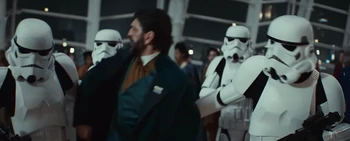
The arrest of Senator Dasi Oran in an episode released in May. Tony Gilroy remarked that Andor's creators were shocked at real life Senator Alex Padilla being handcuffed and dragged away from a US federal press conference in June.
Gilroy had thought about some of the audiences' remarks that Andor has been "predictive" of America in the past six months, with the mineral rights over Ghorman echoing the US' ambitions over Greenland and Ukraine, the migrantion issue on Mina-Rau echoing the US Immigration and Customs Enforcement (ICE) agency's hardline deportation operations, and the arrest of Senator Dasi Oran in the Senate Building echoing US Senator Alex Padilla being forcibly detained at a federal press conference. Gilroy added he was surprised a confrontation over an ICE raid had not yet led to an event akin to the Kent State shootings during the anti-war protests in 1970 and prompted a declaration of martial law, and he suggested a civil conflict would then perhaps be a desired outcome for the "tech right" like Peter Thiel of Palantir Technologies who are using Trump as a "host organism" and, as expressed in the interview with Ross Douthat on June 26, would not care if AI wipes out humanity.[558]
Gilroy recalled that the fantasy author J. R. R. Tolkien disliked allegories and pointed out that they are different from applicability—Gilroy realized that the audience of Andor have found the story applicable to many different contexts. Although he was hesitant, especially at the start of Season 2's press tour, to let interviewers associate political labels with Andor, he has felt sadness as people around the world find Andor resonating deeply with their own experiences. Gilroy's greatest concern was that although Andor and Mike Duncan's podcasts have examined patterns of human history, humanity may be compromising ourselves with the development of advanced AI. The podcast speakers nevertheless expressed hope that the series, having become part of contemporary popular culture with phrases like "I have friends everywhere" appearing at anti-authoritarian protests such as America's No Kings Day demonstrations on June 14, could help people adapt to the changing times.[558] Indeed, the sign-up webpage of the American Indivisible movement, titled "Join Our Fight to Restore the Republic," uses a photograph of a placard bearing the words "I have friends everywhere" by the flag of the USA.[560]
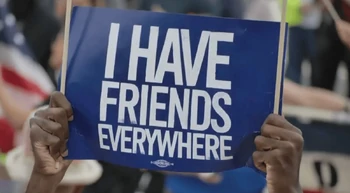
Protests against Trump's presidency in the United States have adopted the phrase "I have friends everywhere" from Andor.
Star Wars imagery had already been invoked in pro-democracy protests in Hong Kong[461] and Thailand during the youth-led pan-Asian Milk Tea Alliance movement in 2020,[462] as well as during the 2024 protests in South Korea[561] and the March 2025 protests in Indonesia.[562] Nemik's line that "freedom is a pure idea" from Andor Season 1 has been used in the 2025 Palestine solidarity protests in London.[563] Placards inspired by Andor Season 2 have also been used in the September 2025 protests in the Philippines as part of the Asian Spring.[564]
In an interview with Charlie Sykes released on August 12, 2025, Tony Gilroy said that as someone brought up amid a strong belief in American democracy following World War II[545]—Dan Gilroy had said in another interview that their father taught them that crimes against humanity like the Ohrdruf concentration camp he had helped liberate in 1945 should not be forgotten, whitewashed, or ignored[557]—it has been shocking how history has developed in his own lifetime. While Andor was written as a non-ideological adventure focused on characters, Gilroy mentioned that Andor's crew was wondering in 2024 how the US election results would impact the series' reception upon its release in 2025; the writer thought that Trump's second presidency has been adding an extra dimension to it, and that "at this point," he is comfortable with fans comparing Andor's use of the word "genocide" with using that word in real life in relation with Israel's actions in Gaza.[545]
Gilroy had also heard that the singing of "We Are the Ghor" in the fictional Ghor language sounded like various real life languages such as Ukrainian to different people, and while the "horror show" of history repeats and makes Andor immediately resonant, he has become gravely concerned that a "tech Reich," whether it be Palantir or Xi Jinping, is building AI that would be more dangerous and intractable than anything in history, and there is no leader who could make a rational and global plan to control this development.[545] Tony Gilroy also said in an interview with Pop Culture Confidential released on August 19 that as a post–World War II child who lived in America from the civil rights movement and Vietnam War to the COVID-19 pandemic who "thought I had lived through all the history I was going to get," he viewed history as progressive, with struggles despite being bloody ultimately resulting in better overall outcomes, until very recently—"you want to live after antibiotics and before the robots take over."[565]

Tony Gilroy, the creator and showrunner of Andor
In an interview with Backstory Magazine released on August 24, Tony Gilroy and Dan Gilroy were asked about how Andor resonates with contemporary politics. Tony said that both Andor and modern states borrow from the same "fascist playbook," or rather the "authoritarian playbook" since "fascism is used as a universal term for authoritarianism," that has existed for thousands of years of human history and been documented since at least the time of the Roman historian Suetonius. Dan added that "Who Are You?" begins and ends with HoloNet News propaganda due to his interest in the role of mass media since making the 2014 film Nightcrawler, believing that the United States lost "any credible news the second that the news rooms had to make money" in his lifetime because news became entertainment that has been stripped of context. As for Mon Mothma's speech in the next episode, the key sentiment for Dan as the writer was its meaning to those who may be frustrated that the longstanding democratic bodies they have cherished in the real world are being undermined.[547]
The politics of narrative art[]
- "We've given people a narrative to relate to politics in a more story-based way."
- ―Dan Gilroy
In an interview with The Bulwark released on September 10, Tony Gilroy remarked that the cast and crew of Andor had no orders from Disney and were initially tight-lipped when being interviewed about real world politics so as to maintain an audience with a diverse spread of opinions, but the creators gradually loosened up with their own individual opinions. By the end of the publicity period, the creators have felt that it was no longer their responsibility to refrain from linking the series to politics because politics has gone beyond ideological left-right divisions. Instead, they morbidly joked that Trump official Stephen Miller was following the series and believed the present governments of the United States, Israel, and Russia are "matching the show"—"it's fascism, man." Gilroy highlighted Trump's deployment of the National Guard on the streets of Washington, D.C. and the president posting an Apocalypse Now meme about the "Department of War" napalm-bombing Chicago and the "nationalization" of companies like Intel by open bribery, which he thought contrasts starkly with the "passivity" of the people.[567]
As such, Tony Gilroy felt that perhaps Nemik's point in Season 1—that the "pace of oppression outstrips our ability to understand it"—has come true, all the while making America "a second-rate power" when compared to China's victory parade in Tiananmen Square with Russia, North Korea, and other authoritarian regimes. Gilroy asserted that Andor does not advocate leftism or right-wing or progressive ideology or has any relation to the US' political parties—Andor's ideas are moral and center around the notion of the destruction of communities, and he thought that he would not know how to write such things in fiction as reality has become so surreal. He concluded that people had forgotten that their lives are owed to someone's sacrifice in the past and how good it feels to be courageous, to make sacrifices, and to "stand up for the things you know are absolutely right."[567]
Dan Gilroy won an Emmy Award for his writing on Andor on September 14. Gilroy credited the fans for engaging with the series beyond just watching it, mentioned that he shared many fans' sentiment that it has ongoing real life parallels, and thanked Bob Iger for backing Andor as a story about "ordinary people who are caught in extraordinary circumstances." Gilroy also thought that Andor's creators have given audiences "a narrative to relate to politics in a more story-based way," and he as a writer was motivated by his belief that "there are things worth dying for."[566] On September 19, Dan Gilroy wrote in Deadline magazine's opinion column that the Disney corporation faces a choice of either paving way for what he characterized as the most venomous "evil" in America's history or defending the US Constitution's First Amendment following Disney's suspension of the Jimmy Kimmel Live! talk show due to government pressure, which Gilroy compared to Putin's silencing of shows that criticized him upon taking power in post-Soviet Russia. Jimmy Kimmel's suspension prompted a protest at Disney's headquarters by writers' and actors' guilds with signs, including some which read "Did you even watch Andor?" and "This is literally what your show Andor is about."[568]
Disney reinstated Kimmel three days later, with the Governor of Illinois quoting a line about oppression by Nemik in Andor.[569] Tony Gilroy had said on April 15 that power has always wanted to control the narrative since the first campfire story, citing the Reichstag fire as the Nazi pretext for persecuting communists and Jews, the Gulf of Tonkin incident as the American pretext for expanding the war in Vietnam, and William Randolph Hearst's press campaign that pressured America to wage war against the Spanish Empire. Aside from history, the Andor showrunner was also inspired by the series' actors as he was writing and greatly appreciated that the crew was able "to build a community that's vaguely utopian while making a show about the destruction of community—that was powerful."[533]
George Lucas' alma mater, the University of Southern California's School of Cinematic Arts, organized "War, Justice, and Democracy in ANDOR: A STAR WARS STORY," two days of Andor screenings and conversations with Tony and Dan Gilroy on October 12 and 13, in partnership with Disney+. They were hosted by the International Criminal Court's founding chief prosecutor Luis Moreno Ocampo and filmmaker Professor Ted Braun.[570] Following the event, Tony Gilroy recorded a video urging fellow Americans to join the No Kings protests on October 18—"democracy is up for grabs and it's up to us to protect the thing we love." Andor actors Diego Luna, Denise Gough, and Benjamin Norris (who played Bardi) jointly posted the video with the Indivisible campaign group.[571] Din Djarin actor Pedro Pascal met Tony Gilroy on the day of what Pascal characterizes as pro-democracy protests in Los Angeles,[572] where The Guardian found Gilroy, who reiterated his alarm about his work on authoritarianism and the courage needed for resisting it in Star Wars materializing in contemporary America and expressed dismay at people still lacking an organized leadership while faced with the "karaoke fascist playbook."[573] New York City comptroller and politician Brad Lander posted photos of the No Kings protests with the line "I have friends everywhere."[574]
The future of Star Wars[]
Daisy Ridley would reprise her role as Rey Skywalker in a Star Wars film being developed with Sharmeen Obaid-Chinoy as the director and George Nolfi as a screenwriter. In February 2025, Nolfi noted how George Lucas' Star Wars is "very steeped in broad notions of politics," whereby individuals organize their society against chaos only to have their tools become weapons of oppression, ranging from antiquity to modern times with the Roman Empire and Nazis—but unlike attending a philosophy or political science class or reading the news of today, Star Wars makes sense of reality in an emotionally resonant way.[575] In the same month, Daisy Ridley similarly expressed the idea that all Star Wars movies are political and emotionally relatable, with "the individual versus the big corporation or the big group."[576]
LEGO[]
In the non-canon 2022 video game LEGO Star Wars: The Skywalker Saga, Padmé Amidala shouts "For the Republic! For democracy!" upon being selected as a player character. During players' space battle against the Home One, Captain Fo Skoolan declares that ship is a part of the Galactic Republic and that the player should "prepare to be shot down in the name of democracy."[577]
Appearances[]
Sources[]
 Galactic Republic in the Encyclopedia (original site is defunct)
Galactic Republic in the Encyclopedia (original site is defunct) Padmé Amidala in the Encyclopedia (original site is defunct)
Padmé Amidala in the Encyclopedia (original site is defunct) Patitites in the Encyclopedia (original site is defunct)
Patitites in the Encyclopedia (original site is defunct) Rebel Alliance in the Encyclopedia (original site is defunct)
Rebel Alliance in the Encyclopedia (original site is defunct) Sio Bibble in the Encyclopedia (original site is defunct)
Sio Bibble in the Encyclopedia (original site is defunct)
- Star Wars: The Rebel Files
- Star Wars Bust Collection: Darth Vader Character: Darth Vader ‡
- Dawn of Rebellion
- Ultimate Star Wars, New Edition
- 2020 Topps Women of Star Wars Card: #62: Queen Apailana (backup link not available)
- Star Wars 100 Objects
- Star Wars Encyclopedia: The Comprehensive Guide to the Star Wars Galaxy
 "Launchpad" — Star Wars Insider 230
"Launchpad" — Star Wars Insider 230 Galactic Republic in the Databank (backup link)
Galactic Republic in the Databank (backup link) Rebel Alliance in the Databank (backup link)
Rebel Alliance in the Databank (backup link)


